
100+ Botany Research Topics [Updated 2024]
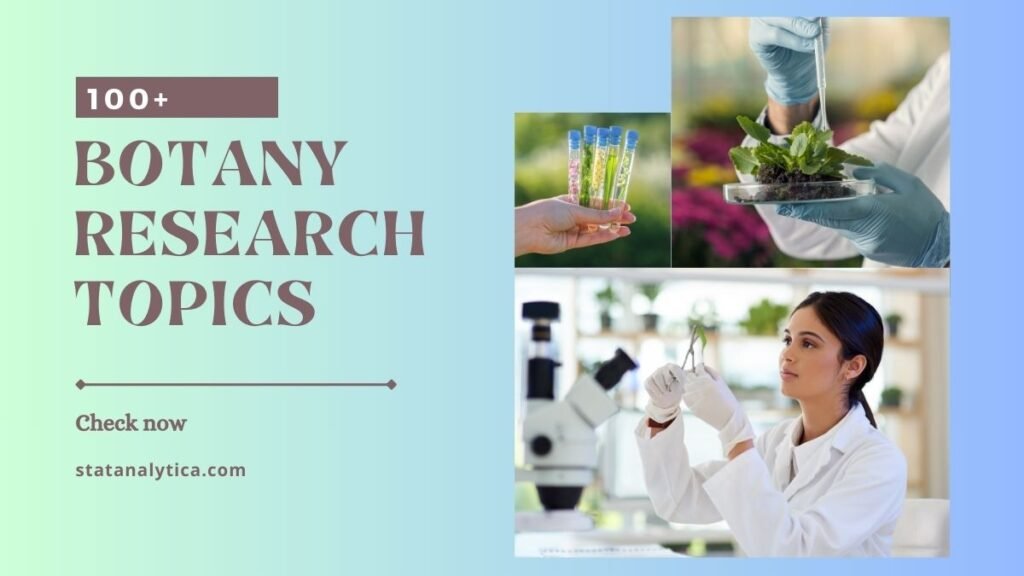
Botany, the scientific study of plants, holds the key to understanding the intricate and fascinating world of flora that surrounds us. As we delve into the realm of botany research, we uncover a vast array of botany research topics that not only contribute specifically to our scientific knowledge but also play an important role in addressing real-world challenges.
In this blog, we will embark on a journey through the rich landscape of botany research, exploring various captivating topics that researchers are delving into.
How to Select Botany Research Topics?
Table of Contents
Selecting an appropriate and engaging botany research topic is a crucial step in the research process. Whether you are a student working on a thesis, a scientist planning a research project, or someone passionate about exploring the wonders of plant biology, the right choice of topic can significantly impact the success and enjoyment of your research.
Here are some guidelines on how to select botany research topics:
- Identify Your Interests:
- Start by reflecting on your own personal interests within the field of botany. Consider the aspects of plant biology that fascinate you the most.
- Whether it’s plant physiology, taxonomy, ecology, genetics, or any other subfield, choosing a topic aligned with your interests can make the research process more enjoyable.
- Review Literature:
- Conduct a thorough review and it will be of existing literature in botany. Explore recent research articles, journals, and books to identify gaps in knowledge, emerging trends, and areas where further investigation is needed.
- This can help you find inspiration and identify potential research questions.
- Consider Relevance:
- Assess the relevance of your chosen topic to the current state of botany and its applications. Consider how your research could contribute to addressing real-world challenges, advancing scientific knowledge, or informing practical solutions.
- Relevant research topics often garner more attention and support.
- Evaluate Feasibility:
- Evaluate all possible feasibility of your chosen topic in terms of available resources, time constraints, and research capabilities.
- Consider the accessibility of study sites, the availability of equipment and materials, and the level of expertise required. A feasible research topic is one that aligns with your resources and constraints.
- Collaborate and Seek Guidance:
- Discuss your ideas with mentors, professors, or colleagues in the field.
- Collaborative discussions can provide valuable insights, help refine your research questions, and guide you toward topics that align with current research priorities.
- Explore Emerging Technologies:
- Consider incorporating emerging technologies and methodologies in your research. This not only adds a contemporary dimension to your study but also opens up new possibilities for exploration.
- Technologies like CRISPR-Cas9, high-throughput sequencing, and remote sensing have revolutionized botany research.
- Think Interdisciplinary:
- Botany often intersects with various other disciplines, such as ecology, genetics, molecular biology, environmental science, and more.
- Consider interdisciplinary approaches to your research, as this can lead to innovative and comprehensive insights.
- Address Global Challenges:
- Botany research can play a crucial role in addressing global challenges like climate change, food security, and biodiversity loss.
- Choosing a topic that contributes to solving or mitigating these challenges adds societal relevance to your work.
- Explore Local Flora:
- If applicable, explore the flora of your local region. Investigating plant species native to your area can have practical implications for local conservation, biodiversity studies, and environmental management.
- Stay Inquisitive and Open-Minded:
- Keep an open mind and stay curious. Scientific research often involves unexpected discoveries, and being open to exploration can lead to novel and exciting findings.
- Be willing to adapt your research questions based on your findings and new insights.
100+ Botany Research Topics For All Students
Plant physiology.
- The Role of Plant Hormones in Growth and Development
- Mechanisms of Photosynthesis: A Comprehensive Study
- Impact of Environmental Stress on Plant Physiology
- Water Use Efficiency in Plants: Regulation and Adaptation
- Nutrient Uptake and Transport in Plants
- Signaling Pathways in Plant Defense Mechanisms
- Regulation of Flowering Time in Plants
- Physiological Responses of Plants to Climate Change
- Role of Mycorrhizal Associations in Plant Nutrition
- Stress Tolerance Mechanisms in Halophytic Plants
Plant Taxonomy
- Phylogenetic Analysis of a Plant Family: Case Study
- Integrating Molecular Systematics in Plant Taxonomy
- Plant DNA Barcoding for Species Identification
- Revision of a Plant Genus: Taxonomic Challenges
- Cryptic Species in Plant Taxonomy: Detection and Implications
- Floristic Diversity in a Specific Geographic Region
- Evolutionary Trends in Angiosperms
- Ethnobotanical Contributions to Plant Taxonomy
- Application of GIS in Plant Taxonomy
- Conservation Status Assessment of Endangered Plant Species
Plant Ecology
- Ecosystem Services Provided by Plants
- Dynamics of Plant-Animal Interactions in a Habitat
- Impact of Invasive Plant Species on Native Flora
- Plant Community Composition Along Environmental Gradients
- Ecological Consequences of Plant-Pollinator Decline
- Microbial Interactions in the Rhizosphere
- Plant Responses to Fire: Adaptation and Recovery
- Climate Change Effects on Plant Phenology
- Restoration Ecology: Reintroducing Native Plants
- Plant-Soil Feedbacks and Ecosystem Stability
Plant Pathology
- Molecular Mechanisms of Plant-Pathogen Interactions
- Emerging Plant Diseases: Causes and Consequences
- Integrated Disease Management in Agriculture
- Fungal Pathogens: Diversity and Control Strategies
- Plant Immunity and Defense Mechanisms
- Resistance Breeding Against Viral Pathogens
- Bacterial Diseases in Crop Plants: Diagnosis and Management
- Impact of Climate Change on Plant Pathogen Dynamics
- Biocontrol Agents for Plant Disease Management
- Genetic Basis of Host Susceptibility to Plant Pathogens
Ethnobotany
- Traditional Medicinal Plants: Documentation and Validation
- Cultural Significance of Plants in Indigenous Communities
- Ethnobotanical Survey of a Specific Region
- Sustainable Harvesting Practices of Medicinal Plants
- Traditional Plant Use in Rituals and Ceremonies
- Plant-Based Foods in Indigenous Diets
- Ethnopharmacological Studies on Antimicrobial Plants
- Conservation of Ethnobotanical Knowledge
- Ethnobotanical Contributions to Modern Medicine
- Indigenous Perspectives on Plant Conservation
Genetic and Molecular Biology
- CRISPR-Cas9 Applications in Plant Genome Editing
- Epigenetics in Plant Development and Stress Response
- Functional Genomics of Plant Responses to Abiotic Stress
- Genetic Diversity in Crop Plants and its Conservation
- Genetic Mapping and Marker-Assisted Selection in Plant Breeding
- Genome Sequencing of Non-Model Plant Species
- RNA Interference in Plant Gene Regulation
- Comparative Genomics of Plant Evolution
- Genetic Basis of Plant Adaptation to Extreme Environments
- Plant Epigenome Editing: Methods and Applications
Plant Anatomy and Morphology
- Comparative Anatomy of C3 and C4 Plants
- Xylem and Phloem Development in Plants
- Leaf Anatomy and Adaptations to Photosynthesis
- Morphological Diversity in Plant Reproductive Structures
- Evolution of Floral Symmetry in Angiosperms
- Root Architecture and its Functional Significance
- Stem Cell Dynamics in Plant Meristems
- Comparative Morphology of Succulent Plants
- Tissue Regeneration in Plants: Mechanisms and Applications
- Wood Anatomy and Tree-Ring Analysis in Dendrochronology
Climate Change and Plant Responses
- Impact of Global Warming on Alpine Plant Communities
- Plant Responses to Elevated CO2 Levels
- Drought Tolerance Mechanisms in Plants
- Shifts in Plant Phenology Due to Climate Change
- Climate-Induced Changes in Plant-Pollinator Interactions
- Carbon Sequestration Potential of Forest Ecosystems
- Ocean Acidification Effects on Seagrass Physiology
- Plant Responses to Increased Frequency of Extreme Events
- Alpine Plant Adaptations to Harsh Environments
- Climate-Driven Changes in Plant Distribution and Biogeography
Emerging Technologies in Botany Research
- Application of Machine Learning in Plant Phenotyping
- Nanotechnology in Plant Science: Current Status and Future Prospects
- Metagenomics in Studying Plant Microbiomes
- Remote Sensing for Monitoring Plant Health
- High-Throughput Sequencing in Plant Genomics
- CRISPR-Based Gene Drives for Ecological Restoration
- Advances in Plant Imaging Techniques
- Synthetic Biology Approaches in Plant Engineering
- Augmented Reality Applications in Plant Biology Education
- Digital Herbariums: Integrating Technology in Plant Taxonomy
Misc Botany Research Topics
- Metabolic Pathways in Plant Secondary Metabolism: Regulation and Significance
- Population Genomics of Endangered Plant Species: Implications for Conservation
- Impact of Soil Microbes on Plant Health and Productivity
- Evolutionary Dynamics of Plant-Pathogen Coevolution: Insights from Molecular Data
- Application of CRISPR-Based Gene Editing for Improving Crop Traits
- Phytochemical Profiling of Medicinal Plants for Drug Discovery
- Investigating the Role of Epigenetic Modifications in Plant Stress Responses
- Role of Plant Volatile Organic Compounds (VOCs) in Ecological Interactions
- Biotic and Abiotic Factors Influencing Plant Microbiome Composition
- Molecular Basis of Plant-Microbe Symbiosis: Lessons from Nitrogen-Fixing Associations
How to Make Botany Research Successful?
Conducting successful botany research involves a combination of careful planning, effective execution, and thoughtful analysis. Whether you are a student, a researcher, or someone conducting independent studies, here are key tips to ensure the success of your botany research:
- Establish Clear Objectives: Clearly articulate the goals and objectives of your research. What specific inquiries do you intend to address? A well-defined research focus serves as a guiding framework, ensuring your efforts remain purposeful and on course.
- Conduct an In-Depth Literature Review: Immerse yourself in the existing body of literature within your field of study. Identify gaps, discern trends, and pinpoint areas where your research could contribute significantly. A thorough literature review lays a robust groundwork for shaping your research design.
- Choose an Appropriate Research Topic: Select a research topic that resonates with your interests, aligns with your expertise, and addresses the current needs of the scientific community. Ensure that the chosen topic is not only feasible but also harbors the potential for impactful outcomes.
- Develop a Sound Research Plan: Create a detailed research plan outlining the methodologies, timelines, and resources required. A well-structured plan helps in efficient execution and minimizes the risk of unforeseen challenges.
- Utilize Cutting-Edge Technologies: Stay updated with the latest technologies and methodologies in botany research. Incorporate advanced tools such as high-throughput sequencing, CRISPR-Cas9 , and remote sensing to enhance the precision and efficiency of your research.
- Collaborate and Seek Guidance: Collaborate with experts in the field, seek mentorship, and engage in discussions with colleagues. Networking and collaboration can provide valuable insights, guidance, and potential avenues for collaboration.
- Ensure Ethical Considerations: Adhere to ethical guidelines and standards in your research. Obtain necessary approvals for human subjects, follow ethical practices in plant experimentation, and ensure the responsible use of emerging technologies.
- Implement Robust Experimental Design: Design experiments with attention to detail, ensuring that they are replicable and provide statistically significant results. Address potential confounding variables and incorporate controls to enhance the reliability of your findings.
- Collect and Analyze Data Thoughtfully: Implement systematic data collection methods. Use appropriate statistical analyses to interpret your results and draw meaningful conclusions. Transparent and well-documented data analysis enhances the credibility of your research.
- Regularly Review and Adapt: Periodically review your progress and be open to adapting your research plan based on emerging findings. Flexibility and responsiveness to unexpected results contribute to a dynamic and successful research process.
- Communicate Your Research Effectively: Share your findings through publications, presentations, and other relevant channels. Effective communication of your research results contributes to the broader scientific community and enhances the impact of your work.
- Foster a Collaborative Research Environment: Encourage collaboration within your research team. A collaborative environment fosters creativity, diverse perspectives, and a collective effort towards achieving research goals.
- Contribute to Sustainable Practices: If your research involves fieldwork or plant collection, adhere to sustainable practices. Consider the impact on local ecosystems and strive to minimize any negative consequences.
- Stay Resilient: Research can have its challenges, setbacks, and unforeseen obstacles. Stay resilient, remain focused on your goals, and view challenges as opportunities for growth and learning.
- Celebrate Achievements and Learn from Failures: Acknowledge and celebrate your achievements, no matter how small. Learn from any setbacks or failures and use them as lessons to refine and improve your research approach.
In the vast and diverse field of botany research, scientists are continually unraveling the mysteries of the plant kingdom. From the intricate processes of photosynthesis to the challenges posed by emerging plant diseases and the potential of cutting-edge technologies, botany research is a dynamic and ever-evolving field.
As we delve deeper into the green secrets of the plant world, our understanding grows, offering not only scientific insights but also solutions to address pressing global challenges such as food security, biodiversity loss, and climate change.
The exploration of botany research topics is a journey of discovery, paving the way for a sustainable and harmonious coexistence with the plant life that sustains our planet.
Related Posts

Step by Step Guide on The Best Way to Finance Car

The Best Way on How to Get Fund For Business to Grow it Efficiently
Leave a comment cancel reply.
Your email address will not be published. Required fields are marked *
Subscribe or renew today
Every print subscription comes with full digital access
Science News

Big monarch caterpillars don’t avoid toxic milkweed goo. They binge on it
Instead of nipping milkweed to drain the plants’ defensive sap, older monarch caterpillars may seek the toxic sap. Lab larvae guzzled it from a pipette.
How air pollution may make it harder for pollinators to find flowers
Giant tortoise migration in the galápagos may be stymied by invasive trees, more stories in plants.

On hot summer days, this thistle is somehow cool to the touch
In hot Spanish summers, the thistle Carlina corymbosa is somehow able to cool itself substantially below air temperature.

Ancient trees’ gnarled, twisted shapes provide irreplaceable habitats
Traits that help trees live for hundreds of years also foster forest life, one reason why old growth forest conservation is crucial.

Here’s why blueberries are blue
Nanostructures in a blueberry’s waxy coating make it look blue, despite having dark red pigments — and no blue ones — in its skin, a new study reports.

This weird fern is the first known plant that turns its dead leaves into new roots
Cyathea rojasiana tree ferns seem to thrive in Panama’s Quebrada Chorro forest by turning dead leaves into roots that seek out nutrient-rich soil.

A rare 3-D tree fossil may be the earliest glimpse at a forest understory
The 350-million-year-old tree, which was wider than it was tall thanks to a mop-top crown of 3-meter-long leaves, would look at home in a Dr. Seuss book.

How an invasive ant changed a lion’s dinner menu
An invasive ant is killing off ants that defend trees from elephants. With less cover, it’s harder for lions to hunt zebras, so they hunt buffalo instead.

This first-of-its-kind palm plant flowers and fruits entirely underground
Though rare, plants across 33 families are known for subterranean flowering or fruiting. This is the first example in a palm.

‘Most Delicious Poison’ explores how toxins rule our world
In his debut book, Noah Whiteman tours through chemistry, evolution and world history to understand toxins and how we’ve come to use them.

On some Australian islands, sea level rise may be helping mangroves thrive
Rising seas usually spell trouble for mangroves. But the first survey of the Howick Islands in 50 years finds that mangroves there have expanded a lot.
Subscribers, enter your e-mail address for full access to the Science News archives and digital editions.
Not a subscriber? Become one now .
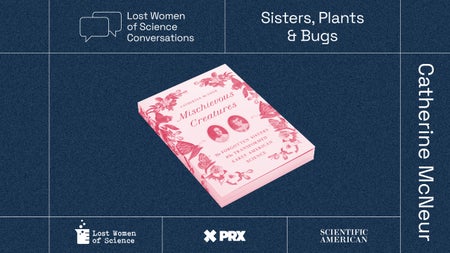
The Forgotten Sisters Who Transformed Early American Science
The Morris sisters made significant contributions to botany and entomology, but their stories were erased from the history of early American science, both accidentally and by design.
Katie Hafner, Catherine McNeur, Michelle Nijhuis, The Lost Women of Science Initiative
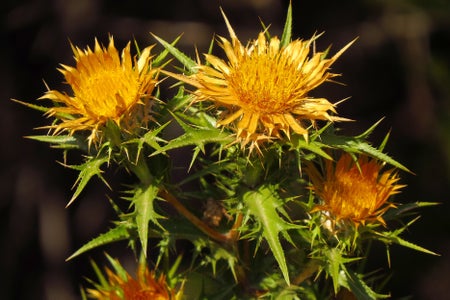
This Flower Refrigerates Itself to Survive Scorching Summers
A humble thistle blossom in southern Spain somehow keeps itself up to 18 degrees Fahrenheit cooler than the surrounding air
Elizabeth Anne Brown
This Genetically Engineered Petunia Glows in the Dark and Could Be Yours for $29
The engineered “firefly petunia” emits a continuous green glow thanks to genes from a light-up mushroom
Katherine Bourzac, Nature magazine
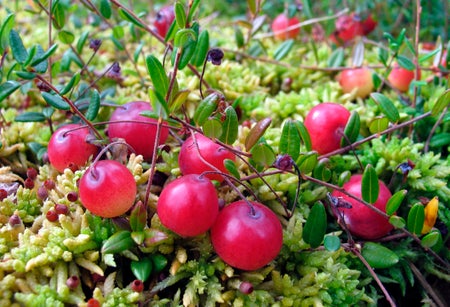
Cranberries Are a Scientific Delicacy
From self-pollination to bogs, cranberries are a Thanksgiving classic with many fascinating botanical and genetic features
Serina DeSalvio, The Conversation US

This Fall Is Full of Acorns—Thanks to a ‘Mast’ Year
Trees can outsmart animals such as squirrels and birds by synchronizing their seed production
Emily Moran, The Conversation US

How Hot Is ‘Pepper X’? Its Creator Spent 6 Hours Recovering from Eating It
“Pepper X” is officially the hottest pepper in the world, weighing in with 2.693 million Scoville heat units. The creator reveals his process and experience tasting the pepper
Stephanie Pappas

We Finally Know Where Oranges and Lemons Come From
In addition to finding where citrus come from, researchers have pinpointed the genetic origins of the fruits’ tart taste
Jack Tamisiea

Thousands More Puzzling ‘Fairy Circles’ Have Been Found around the World
These mysterious spots of barren soil have fascinated scientists for years. Now evidence of their existence beyond two known locations is stirring up a fresh round of contention
Lori Youmshajekian

Tropical Forests May Be Getting Too Hot for Photosynthesis
When trees get too hot, energy production in their leaves breaks down
Meghan Bartels
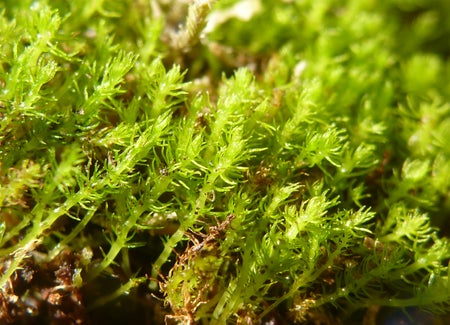
The World’s Oldest Moss Outlived the Dinosaurs, but It May Not Survive Climate Change
The world’s oldest moss has survived Earth’s shifting landscapes for more than 400 million years, but climate change is happening faster than it can adapt
Chelsea Harvey, E&E News

Can Virtual Reality Mimic Nature’s Power to Make Us Healthier?
Just seeing nature in VR brings some health benefits—and helps scientists learn why we need the real thing

Quantum Light Experiment Proves Photosynthesis Starts with a Single Photon
Scientists have used quantum technology to track individual particles of light as they begin the process of photosynthesis
23 Ideas for Science Experiments Using Plants
ThoughtCo / Hilary Allison
- Cell Biology
- Weather & Climate
- B.A., Biology, Emory University
- A.S., Nursing, Chattahoochee Technical College
Plants are tremendously crucial to life on earth. They are the foundation of food chains in almost every ecosystem. Plants also play a significant role in the environment by influencing climate and producing life-giving oxygen. Plant project studies allow us to learn about plant biology and potential usage for plants in other fields such as medicine, agriculture, and biotechnology. The following plant project ideas provide suggestions for topics that can be explored through experimentation.
Plant Project Ideas
- Do magnetic fields affect plant growth?
- Do different colors of light affect the direction of plant growth?
- Do sounds (music, noise, etc.) affect plant growth?
- Do different colors of light affect the rate of photosynthesis ?
- What are the effects of acid rain on plant growth?
- Do household detergents affect plant growth?
- Can plants conduct electricity?
- Does cigarette smoke affect plant growth?
- Does soil temperature affect root growth?
- Does caffeine affect plant growth?
- Does water salinity affect plant growth?
- Does artificial gravity affect seed germination?
- Does freezing affect seed germination?
- Does burned soil affect seed germination?
- Does seed size affect plant height?
- Does fruit size affect the number of seeds in the fruit?
- Do vitamins or fertilizers promote plant growth?
- Do fertilizers extend plant life during a drought?
- Does leaf size affect plant transpiration rates?
- Can plant spices inhibit bacterial growth ?
- Do different types of artificial light affect plant growth?
- Does soil pH affect plant growth?
- Do carnivorous plants prefer certain insects?
- 8th Grade Science Fair Project Ideas
- Plant and Soil Chemistry Science Projects
- High School Science Fair Projects
- Middle School Science Fair Project Ideas
- Animal Studies and School Project Ideas
- Elementary School Science Fair Projects
- Chemistry Science Fair Project Ideas
- Magnetism Science Fair Projects
- Science Fair Project Ideas
- 4th Grade Science Fair Projects
- Environmental Science Fair Projects
- Plant Stresses: Abiotic and Biotic Stresses
- 6th Grade Science Fair Projects
- Household Product Testing Science Fair Projects
- College Science Fair Projects
- Understanding Simple vs Controlled Experiments
- Research topics related to
54 Research topics related to Plants

- November 29, 2022
- No comments
Looking for research topics related to Plants? this page might help you come up with ideas. Research topics are subjects or issues researchers are interested in when conducting research. A well-defined research topic is the starting point of every successful research project. Choosing a topic is an ongoing process by which researchers explore, define, and refine their ideas.
There are many research topics related to Plants, depending on your specialization and interests. The topics below are only for guides. We do not encourage writing on any of them because thousands of people visit this page also to get an idea of what project topics to write on.
Plants/Botany focuses on the scientific study of plants, related microbial organisms, and plant habitats and ecosystem relations. The primary purposes of research topics related to Plants are to inform action, gather evidence for theories, and solutions to problems, and contribute to developing knowledge.
- Algal Diversity And Water Quality Of Asata River Enugu
- Assessment Of Genetic (Via Protein Electrophoresis) And Nutritional Variabilities Among Ten Accessions Of Sphenostylis Stenocarpa (Hocht. Ex. A. Rich) Harms
- Biodiversity In Organic Cropping Systems
- Combating The Global Food Crisis: Diazotroph Bacteria As A Cereal Crop Growth Promoter
- Comparative Phytochemical Analyses Of Methanolic And Aqueous Leaf Extracts Of Three Medicinal Plants Used In Plant Disease Control
- Comparative Studies On The Heavy Metal Concentration In Leaf, Stem, And Root Of Corchorus Olitorius L. Irrigated With Sewage Water And Tap Water Respectively
- Compare The Rate Of Growth And Plant Vigor Of Hydroponically Grown Plants To Plants Grown Conventionally, In Soil.
- Corn Response To Sulfur And Zinc Study
- Determine The Effect Of Earthworm Density On the Decomposition Or Reduction Of Surface Residues.
- Determine Whether Or Not Recycled (Reclaimed) Water Would Harm California Native Plant Species.
- Effect Of Different Concentrations Of Iaa (Plant Hormone) On Root Initiation
- Effect Of Sucrose Concentrations On The In Vitro Plantlet Regeneration From Mature Zygotic Embryo Explants Of Jatropha Curcas L. In Murashige And Skoog (Ms) Medium
- Effects Of Abscisic Acid During Water Stress
- Effects Of Crude Oil On Some Bacteria And Mineral Constituents Of Rhizosphere Of Delonix Regia Hook
- Effects Of Nitrogen Fertilizer And Plant Spacing On Two Pasture Grasses (Brachiaria Decumbens And Digitaria Decumbens )
- Effects Of Plant Hormones On Regrowth Of Grasses
- Effects Of Simulated Crude Oil Contamination On The Physicochemical Properties And Bacterial Population Of Rhizosphere Of Sorghum Vulgare Pers
- Effects Of Some Ethno Medicinal Plant Extracts On Fungi Associated With Rot Of Yam (Dioscorea Rotundata Poir)
- Fungitoxic Effect Of Ethanolic And Aqueous Leaf Extracts Of Azadirachta Indica A. Juss, Ocimum Gratissimum Linn And Benlate In The Control Of Post-Harvest Fungal Diseases Of Solanum Melongena Linn (Egg Plant)
- Genetics Of Aphid (Aphis Craccivora Koch.) And Rosette Resistance In Groundnut (Arachis Hypogaea L.)
- Gossypium Hirsatum[Phytochemical Analysis Of Methanolic Extract Of Cotton Plant]
- Hydrocarbon Degradation And Accumulation By Sansevierialiberica Gerome And Labroy Polluted With Crude Oil
- Hydrocarbon Degradation And Heavy Metals Uptake By Senna Alata (L.) Roxb. In Soil Polluted With Spent Engine Oil
- Improvement Of Crop Production In Arid Areas
- Jatropha Curcas Seed Cake As An Organic Fertilizer
- Managing Continuous Corn For High Yields
- Methanolic Extract Of Aqueous Of Enantia Chlorantha
- Monitoring Of Crop Physiology Using Remote Sensing Methods
- Must Plants Have Energy From The Sun To Live
- Nitrogen Fertility Management Of Switchgrass For Sustainable Bioenergy Feedstock Production
- Nutrient Requirements For In Vitro Propagation Of Ricinus Communis L. Zygotic Embryo Using The Basal Media Of Murashige And Skoog, Gamborg Et Al. And Schenk And Hildebrandt
- Phytochemical Screening Of Loranthus Micranthus Linn. Parasitic On Six Different Host Plants
- Relationship Between Pod Growth And Plant Hormones
- See If A Garlic Extract Can Prevent Crown Gall In Rose And Tomato Plants
- Studies On Aspects Of Reproductive Biology And Pod Yield In Bambara Groundnut (Vigna Subterranean (L.) Verdc)
- Taxonomic Studies Of Five Varieties Of Colocasia Esculenta (L.) Schott (Cocoyam)
- The Effect Of Far Infrared On The Growth Of Mold
- The Effect Of Light Quality On The Structural Properties Of Wheat Plants
- The Effect Of Radiation And Heat On The Germination Of Radish Seeds
- The Effect Of Temperature On The Percentage Of Germination Of Mung Beans
- The Effect Of Ultraviolet Light On Plant Development And Fruit Production
- The Effects Of Gravity And Centrifugal Forces On The Gravitropism And Growth Of Bean Seeds
- The Effects Of Nitrogen Fertilizer On Plant Growth
- The Effects Of Plant Hormones On Root Initiation
- The Effects Of Soil Moisture Content On The Growth And Distribution Of Sorghum Root Systems
- The Effects Of Tillage On Soil Organic Matter
- The Influence Of Soil Compaction On Grass Growth
- The Use Of Watermelon (Citrullus Lanatus) Seed As A Coagulant In The Treatment Of Industrial Wastewater.
- The Western Red Lily And Its Adaptations For Survival In Its Habitat
- Use Of Biofertilizer Produced From Fermented Organic Wastes In The Production Of Okra
- Variability And Correlation Studies In Basil, Scent Leaf (Ocimum Gratissimum)
- Water Quality And Algal Biodiversity
- Water Quality And Algal Diversity Of Fish Ponds And Dam Reservoir
- Which Natural Insecticide Kills The Fewest Lady Beetles
Related Choice
Leave a reply cancel reply.
Your email address will not be published. Required fields are marked *
Save my name, email, and website in this browser for the next time I comment.
You May Also Like
51 research topics related to pharmacy.
- November 26, 2022
42 Research topics related to Social Psychology
- January 9, 2023
50 Research topics related to Political Science
- November 28, 2022
Research topics related to Psychology
- November 21, 2022
Research topics related to Pediatric Nursing
- January 30, 2023
62 Research topics related to Microbiology
An official website of the United States government
The .gov means it’s official. Federal government websites often end in .gov or .mil. Before sharing sensitive information, make sure you’re on a federal government site.
The site is secure. The https:// ensures that you are connecting to the official website and that any information you provide is encrypted and transmitted securely.
- Publications
- Account settings
Preview improvements coming to the PMC website in October 2024. Learn More or Try it out now .
- Advanced Search
- Journal List
- Int J Environ Res Public Health

Worldwide Research Trends on Medicinal Plants
Esther salmerón-manzano.
1 Faculty of Law, Universidad Internacional de La Rioja (UNIR), 26006 Logroño, Spain; [email protected]
Jose Antonio Garrido-Cardenas
2 Department of Biology and Geology, University of Almeria, ceiA3, 04120 Almeria, Spain; se.lau@anedracj
Francisco Manzano-Agugliaro
3 Department of Engineering, University of Almeria, ceiA3, 04120 Almeria, Spain
The use of medicinal plants has been done since ancient times and may even be considered the origin of modern medicine. Compounds of plant origin have been and still are an important source of compounds for drugs. In this study a bibliometric study of all the works indexed in the Scopus database until 2019 has been carried out, analyzing more than 100,000 publications. On the one hand, the main countries, institutions and authors researching this topic have been identified, as well as their evolution over time. On the other hand, the links between the authors, the countries and the topics under research have been analyzed through the detection of communities. The last two periods, from 2009 to 2014 and from 2015 to 2019, have been examined in terms of research topics. It has been observed that the areas of study or clusters have been reduced, those of the last period being those engaged in unclassified drug, traditional medicine, cancer, in vivo study—antidiabetic activity, and animals—anti-inflammatory activity. In summary, it has been observed that the trend in global research is focused more on the search for new medicines or active compounds rather than on the cultivation or domestication of plant species with this demonstrated potential.
1. Introduction
Ten percent of all vascular plants are used as medicinal plants [ 1 ], and there are estimated to be between 350,000 [ 2 ] and almost half a million [ 3 ] species of them. Since ancient times, plants have been used in medicine and are still used today [ 4 ]. In the beginning, the trial and error method was used to treat illnesses or even simply to feel better, and in this way, to distinguish useful plants with beneficial effects [ 5 ]. The use of these plants has been gradually refined over the generations, and this has become known in many contexts as traditional medicine. The official definition of traditional medicine can be considered as “the sum total of the knowledge, skills and practices based on the theories, beliefs and experiences indigenous to different cultures, whether explicable or not, used in the maintenance of health, as well as in the prevention, diagnosis, improvement or treatment of physical and mental illnesses” [ 6 ].
It is a fact that all civilizations have developed this form of medicine [ 7 ] based on the plants in their own habitat [ 8 ]. There are even authors who claim that this transmitted knowledge is the origin of medicine and pharmacy. Even today, hundreds of higher plants are cultivated worldwide to obtain useful substances in medicine and pharmacy [ 9 ]. The therapeutic properties of plants gave rise to medicinal drugs made from certain plants with these benefits [ 10 ].
Until the 18th century, the therapeutic properties of many plants, their effect on the human organism and their method of treatment were known, but the active compound was unknown [ 11 ]. As an example, the Canon of Medicine written by the Persian physician and scientist Avicenna (Ibn Sina) was used until the 18th century [ 12 ].
The origin of modern science, especially in the Renaissance, in particular chemical analysis, and the associated instrumentation such as the microscope, was what made it possible to isolate the active principles of medical plants [ 13 ]. Since then, these active principles have been obtained synthetically in the laboratory to produce the medicines later [ 14 ]. The use of medicines was gradually expanded. Until today, the direct use of medicinal plants is apparently displaced in modern medicine [ 15 ]. Today’s medicine needs the industry producing pharmaceutical medicines, which are largely based on the active principles of plants, and therefore, these are used as raw materials in many cases [ 16 ]. Yet, today, the underdeveloped world does not have access to this modern medicine of synthetic origin, and therefore, large areas of the world continue to use traditional medicine based on the direct use of medicinal plants due to their low cost [ 17 ].
However, it should be noted that the possible trend to return to this type of traditional medicine may have two major drawbacks. The first is the use of medicinal plants without sanitary control, without thinking about the possible harmful aspects for health [ 18 ]. Although many plants do not have side effects like the aromatic plants used in infusions: chamomile, rosemary, mint, or thyme; however, others may have dangerous active principles. To cite an example, Bitter melon ( Momordica charantia L. ) used to cure fever and in cases of malaria [ 19 ], its green seeds are very toxic as they can cause a sharp drop in blood sugar and induce a patient’s coma (hypoglycemic coma) [ 20 ]; this is due to the fact that the components of bitter melon extract appear to have structural similarities to animal insulin [ 21 ]. Secondly, there has been a proliferation of products giving rise to false perspectives, as they are not sufficiently researched [ 22 ].
Examining the specialized literature of reviews and bibliometric studies on medicinal plants, three types of studies are found: those focused on a geographical area, those focused on a specific plant or family, and those focused on some type of medical interest activity. Regarding the studies of geographical areas, for example, there are the studies of Africa. Specifically, in South Africa, the plants that are marketed [ 23 ], as these plants of medical interest have been promoted [ 24 ], or for the treatment of specific diseases such as Alzheimer’s [ 25 ]. In Central Africa, the studies of Cameroon are remarkable, where for general bibliometric studies of its scientific output, the topic of medicinal plants stands out as one of the most important in this country [ 26 ]. Or those of Ghana, regarding frequent diseases in this country such as malaria, HIV/AIDS, hypertension, tuberculosis, or bleeding disorders [ 27 ]. Other countries that have conducted a bibliometric study of their medicinal plants have been Cuba [ 28 ] and China [ 29 ].
The other direction of the bibliometric studies mentioned, those that focus on specific plants, are those of: Artemisia annua L. [ 30 ], Aloe vera [ 31 ], Panax ginseng [ 32 ], Punica grantum L. [ 33 ], Apocynum cannabinum [ 34 ], or Andrographis paniculata [ 35 ]. The third line of the bibliometric research on medicinal plants deals with some kind of specific activity; there are studies for example for the activities of: antibacterial or antifungal [ 36 ], antioxidant [ 37 ], and anticancer [ 38 , 39 , 40 ].
As a common feature of the bibliometric studies published so far, none of them has a worldwide perspective. Furthermore, they are generally based on Web of Science and some of them on other more specific databases such as CAB Abstracts or PlantMedCUBA, but no work based on Scopus has been observed. Therefore, this paper aims to study what types of scientific advances are being developed around medicinal plants, what research trends are being carried out, and by which countries and research institutions. To this purpose, it is proposed to carry out a bibliometric analysis of all the scientific publications on this topic.
2. Materials and Methods
The data analyzed in this work have been obtained through a query in the Scopus database, which has been successfully used in a large number of bibliometric studies [ 41 ]. Due to the large amount of results, it was necessary to use the Scopus API to download the data, whose methodology has been developed in previous works [ 42 , 43 ]. In this study, the query used was: (TITLE-ABS-KEY(“medic* plant*”)). An outline of the methodology used is shown in Figure 1 . The analysis of the scientific communities, both in terms of keywords and the relationship between authors or between countries was done with the SW VosViewer [ 44 ].

Methodology.
3.1. Global Evolution Trend
From 1960 to 2019, more than 110,000 studies related to medicinal plants have been published. Figure 2 shows the trend in research in this field. Overall, it can be said that there was a continuous increase from 1960 to 2001, with just over 1300 published studies. From here, the trend increases faster until 2011, when it reaches a maximum of just over 6200 publications. After this period, publications stabilize at just over 5000 per year. These three periods identified are highlighted in Figure 2 .

Worldwide temporal evolution of medical plants publications.
3.2. Global Subject Category
If the results are analyzed according to the categories in which they have been published (see Figure 3 ), according to the Scopus database, it can be seen that most of them have been carried out in the Pharmacology, Toxicology and Pharmaceutics category with 27.1 % of the total. Other categories with significant relative relevance have been: Medicine (23.8%), Biochemistry, Genetics and Molecular Biology (16.7%), Agricultural and Biological Sciences (11%), Chemistry (8.7%), Immunology and Microbiology (2.5%), Environmental Science (2.1%), and Chemical Engineering (1.5%). All other categories are below 1%, such as: Nursing, Multidisciplinary, or Engineering.

Medicinal plants publications by scientific categories indexed in Scopus.
3.3. Distribution of Publications by Countries
If the results obtained are analyzed by country, a total of 159 countries have published on this topic. Figure 4 shows the countries that have published on the subject and the intensity with which they published has been shown. It is observed that China and India stand out over the rest of the countries with more than 10,000 publications, perhaps influenced by traditional medicine, although their most cited works are related to antioxidant activity, both for China [ 45 ], and for India [ 46 , 47 ], and in this last country also antidiabetic potential [ 4 ]. The third place is the USA followed by Brazil, both with more than 5000 publications. The most frequently cited publications from these countries focus on antioxidant activity [ 48 ], and antimicrobial activity [ 49 ] for the USA and anti-inflammatory activity for Brazil [ 50 , 51 ].

Worldwide research on medical plants.
As mentioned, the list of countries is very long, but those with more than 2000 publications are included: Japan, South Korea, Germany, Iran, United Kingdom, Pakistan, Italy, and France. If the overall results obtained are analyzed in their evolution by years, for this list of countries with more than 2000 publications, Figure 5 is obtained. From this point onwards, three groups of countries can be identified.

Temporal evolution on medical plants publications for Top 12 countries.
The first group is the leaders of this research, China and India, with between 800 and 1100 publications per year. China led the research from 1996 to 2010, and from this year to 2016, the leader was India, after which it returned to China. The second group of five countries is formed in order in the last year of the study: Iran, Brazil, USA, South Korea and Pakistan. This group of countries has a sustained growth over time, with a rate of publications between 200 and 400 per year. It should be noted that Brazil led the third place for a decade, from 2007 to 2016, since then that position is for Iran. The third group of five countries is made up of: Japan, Germany, United Kingdom, Italy, and France. They are keeping the publications around 100 a year, with an upward trend, but at a very slight rate.
If the analysis of the publications by country is made according to the categories in which they publish, Figure 6 is obtained, which shows the relative effort between the different themes or categories is shown. At first look, it might seem that they have a similar distribution. However, in relative terms the category of Pharmacology, Toxicology and Pharmaceutics is led by Brazil with 35% of its own publications followed by India with 33%. For the Medicine category, in relative terms it is led by China with 29 %, followed by Germany with 27 %. The category of Biochemistry, Genetics and Molecular Biology always takes second or third place for this ranking of countries, standing out especially for Japan and South Korea with 23% and for France with 22%. The fourth category for many countries is Agricultural and Biological Sciences, with Pakistan standing out with 20%, followed by Italy with 16%. The category of Chemistry occupies the fourth category for countries such as Japan with 20% or Iran with 14%. The other categories: Chemical Engineering, Immunology and Microbiology, Environmental Science, Multidisciplinary, or Engineering, are below 5 % in all countries.

Distribution by scientific categories according to countries.
According to these results, it can be seen the relative lack of relevance of the category of Agricultural and Biological Sciences for medicinal plants, compared to the categories of Pharmacology, Toxicology and Pharmaceutics, Medicine, or Biochemistry, Genetics and Molecular Biology.
3.4. Institutions (Affiliations)
So far, the distribution by country has been seen, but the research is done in specific research centers (institution or affiliations as are indexed in Scopus) and therefore, it is important to study them. Table 1 shows the 25 institutions with more than 400 publications, of which 13 are from China (including the first 7), 3 from Brazil, 2 from South Korea, and now with 1: Saudi Arabia, Pakistan, Iran, Mexico, Cameroon, France, and Malaysia.
Top 25 affiliations and main keywords.
If the three main keywords of these affiliations are analyzed, it can be seen that there are no great differences, and in fact, they are often the same: Unclassified Drug, Drug Isolation, Drug Structure, Chemistry, Controlled Study, Isolation And Purification, Chemistry, and Plant Extract. They only call attention to “Drugs, Chinese Herbal” which appears in two affiliations: China Academy of Chinese Medical Sciences, and Beijing University of Chinese Medicine, which of course is a very specific issue in this country.
3.5. Authors
The main authors researching this topic are shown in Table 2 , which are those with more than 100 publications on this topic. It is observed that they are authors with a significantly high h-index. On the other hand, it is noteworthy that the first two are not from China or India, which as we have seen were the most productive countries, and also had the most relevant institutions in this area. The lead author is from South Africa, J. Van Staden, and the second from Bangladesh, M. Rahmatullah. The author with the highest h-index is from Germany, T. Efferth.
Main authors in medicinal plants.
If the network of collaboration between authors with more than 40 documents is established, Figure 7 is obtained. Here, there are 33 clusters, where the most important is the red one with 195 authors, where the central author is Huang, L.Q. The second more abundant cluster is the green one, composed of 69 authors. In this cluster, there is no central author, but instead, a collaboration between prominent authors such as Kim, J.S., Lee, K.R. or Park, J.S. The third cluster, in blue, is composed of 64 authors, led by the authors M.I. Choudhary and M. Ahmad.

A collaborative network of authors with more than 40 publications on medicinal plants.
The fourth cluster, of yellow color is composed of 63 authors, the central authors are Y. Li and H-D. Sun. The fifth cluster, in purple, is also composed of 51 authors, the central author is W. Villegas. It should be noted that this cluster is not linked to the whole network, so they must research very specific topics in their field. The sixth cluster is composed of 48 authors and is cyan colored, the central author is Rahmatullah, M. The cluster of the main author of Table 2 , Van Staden, J., is composed of 23 authors, and would be number 17 in order of importance by number of authors, is light brown, and is located next to that of W. Vilegas but without any apparent connection.
3.6. Keywords
3.6.1. global perspective.
The central aspect of bibliometric studies is to study the keywords in the publications and, through the relationships between them, to establish the clusters or scientific communities in which the different topics associated with a field of study can be grouped together. If keywords are extracted from the total number of publications, an overview can be made of the most used keywords in relation to the subject of medicinal plants (see Figure 8 ). As expected, the search terms are the main ones, but then, there are two indexing terms, Human and Nonhuman, and then Unclassified Drug and Plant Extract.

Cloudword of keywords in medical plants publications.
If the keywords are analyzed by country, and we do not take into account the search terms, the results are obtained in Table 3 , where the four main keywords of the main countries that research this topic are shown. It can be seen that the terms: Unclassified Drug, Plant Extract, and Controlled Study, are the ones that dominate without a doubt.
Main keywords by country.
3.6.2. Keywords Related to Plants
If this keyword analysis is done by parts of the plant (see Table 4 ), which shows which parts of the plant have been most investigated. It should be noted that the number of documents is less than the sum of the individual keywords, since a publication contains more than one keyword. It has been obtained that the parts of the plant most studied in order of importance have been the value expressed in relative terms: Leaf-Leaves (33%), Root-Roots (22%), Seed (12%), Stem (10%), Fruit (10%), Bark (7%), and Flower (6%). The table also shows which plant families have been most used for the study of that part of the plant.
Main keywords related to plant parts and plant families studied.
To give an idea of the most studied plant families, see Table 5 . Although the first two are the same family, it has been left separately to indicate the indexing preferences of the two main affiliations that study them. This is also the situation with Compositae that correspond to the family of Asteraceae. This table lists for each plant family the main institution working on its study. However, it is curious that even if a country is a leader in certain studies related to plant families, most often it is found that the institution leading the issue is not from the country leading the study on that plant family. This helps to establish a certain amount of global leadership on the side of the institutions.
Plant families and Institutions.
3.7. Clusters
The analysis of the clusters formed by the keywords allows the classification of the different groups into which the research trends are grouped. A first analysis has been made with the documents published between 2009 and 2019 and in two periods, from 2009 to 2014 and from 2015 to 2019. Figure 9 shows the clusters obtained for the period 2009 to 2014, showing seven clusters, which can be distinguished by color, and in Table 6 its main keywords have been collected.

Network of keywords in medical plants publications: Clusters between 2009–2014.
Main keywords used by the communities detected in the topic in the period 2009–2014.
The first of these clusters, in red (1-1), is linked to traditional medicine. This is reflected in the main keywords associated with this cluster: phytotherapy, herbaceous agent, traditional medicine, ethnobotany. Within this cluster, the most cited publications are related to the antioxidant function of plants. This includes the prevention of hyperglycemia hypertension [ 52 ], and the prevention of cancer. Of the latter, studies suggest that a reduced risk of cancer is associated with high consumption of vegetables and fruits [ 53 ]. Another topic frequently addressed is the antidiabetic properties, as some plants have hypoglycemic properties [ 34 ]. It should be remembered that diabetes mellitus is one of the common metabolic disorders, acquiring around 2.8% of the world’s population and is expected to double by 2025 [ 54 ].
The second cluster, in green (1-2), appears to be the central cluster, and is related to drugs—chemistry. The main keywords are: drug isolation, drug structure, chemistry, drug determination, and molecular structure. Here, the most cited publications are the search for new drugs [ 55 ] or in natural antimicrobials for food preservation [ 56 ].
The third cluster, in purple (1-3), is focused on in vivo study through studies with laboratory animals, as shown by keywords such as mouse and mice. As it is known that in vivo drug trials are initiated in laboratory animals such as mice, in general studies focused on anti-inflammatory effect [ 57 , 58 ].
The fourth cluster, in yellow (1-4), is engaged in the search for drugs. The main keywords in this regard are unclassified drug and drug screening. Within this cluster, the studies of flavonoids stand out [ 59 ]. Flavonoids have been shown to be antioxidant, free radical scavenger, coronary heart disease prevention, hepatoprotective, anti-inflammatory and anticancer, while some flavonoids show possible antiviral activities [ 60 ].
The fifth cluster, in blue (1-5), is focused on the effectiveness of some drugs, and their experimentation on animals. Some of the most cited publications of this cluster over this period are those focused on genus Scutellaria [ 61 ], Epimedium ( Berberidaceae ) [ 62 ] and Vernonia ( Asteraceae ) [ 63 ].
The sixth cluster, in cyan (1-6), is aimed at the effect of extraction solvent/technique on the antioxidant activity. One of the most cited publications in this regard studies the effects on barks of Azadirachta indica , Acacia nilotica , Eugenia jambolana , Terminalia arjuna , leaves and roots of Moringa oleifera , fruit of Ficus religiosa , and leaves of Aloe barbadensis [ 64 ]. Regarding neuroprotection, some publications are the related to genus Peucedanum [ 65 ] or Bacopa monnieri [ 66 ]. This cluster is among the clusters of traditional medicine (1-1) and drug efficacy (1-5).
Finally, the seventh orange cluster (1-7) is of small relative importance within this cluster analysis and is focused on malaria. As it is known, malaria is one of the most lethal diseases in the world every year [ 67 ]. Malaria causes nearly half a million deaths and was estimated at over 200 million cases, 90 per cent of which occurred in African countries [ 68 ]. Of the Plasmodium species affecting humans, Plasmodium falciparum causes the most deaths, although Plasmodium vivax is the most widely spread except in sub-Saharan Africa [ 69 ]. On the other hand, this cluster cites Plasmodium berghei , which mainly affects mice, and is often used as a model for testing medicines or vaccines [ 70 ].
The second period under study, from 2015 to 2019, is shown in Figure 10 , where five clusters have been identified, Table 7 , as opposed to the previous period which was seven. Now, there is no cluster focusing on malaria. In Figure 10 , the colors of the cluster have been unified with those of Figure 9 , when the clusters have the same topic as in the previous period.

Network of keywords in medical plants publications: Clusters between 2015–2019.
Main keywords used by the communities detected in the topic in the period 2015–2019.
The first cluster in order of importance (2-1), the red one in Figure 10 , can be seen to be that of unclassified drug, which has gone from fourth place (1-4) to first in this last period. In this period, research works include one on the therapeutic potential of spirooxindoles as antiviral agents [ 71 ], or the antimicrobial peptides from plants [ 72 ].
The second cluster of this last period (2-2), the one in green in Figure 10 , is the one assigned to traditional medicine, which has now moved up to second place (1-1) in decreasing order of significance. It seems that this cluster of traditional medicine is now the merging with the drug efficacy cluster of the previous period (1-4). This cluster includes research such as oxidative stress and Parkinson’s disease [ 73 ].
The cluster from the previous period that was devoted to animals-in vivo study (1-3), we assume is now divided into three new clusters. The first of these would be the third cluster (2-3), blue in Figure 10 , which can be considered to be dedicated to cancer. One of the works in this cluster is “Anticancer activity of silver nanoparticles from Panax ginseng fresh leaves in human cancer cells” [ 74 ]. Then, the other two are committed to in vivo studies or with animals. The first one seems to be more engaged in vivo study at antidiabetic activity [ 75 , 76 ], would be the cyan-colored cluster 4 (2-4). The other cluster (2-5) involved in testing anti-inflammatory activity, with plants such as Curcumin [ 77 ], Rosmarinus officinalis [ 78 ], would be the purple cluster in Figure 10 .
3.8. Collaboration Network of Countries
Figure 11 shows the collaborative network between countries doing research on medicinal plants. Table 8 lists the countries of each cluster identified and the main country of each cluster. The countries that are most central to this network of collaboration between countries are India, Iran, Indonesia, and the USA. The largest cluster is led by Brazil, which is also not restricted to its own geographical area as it has strong collaborative links with European countries as well as with neighboring countries such as Argentina. The second cluster led by South Africa also presents the same features as the previous one, some collaborations with nearby countries, Tanzania, Congo, or Sudan, but also with European countries such as France, Belgium, or the Netherlands.

Countries network collaboration.
Countries collaboration in the period 2009–2019.
The third cluster is led by India and has very strong collaboration with Iran, but it could also be considered as the central country in the whole international collaboration network. The cooperation with European countries comprises mainly Eastern countries like Poland, Serbia, or Croatia.
The fourth cluster, led by Germany and Pakistan, includes Middle Eastern countries such as Jordan, Saudi Arabia, and United Arab Emirates, which are quite related to the cluster led by China. The fifth cluster seems to have a geographical consideration within Asia by including countries such as Indonesia, Malaysia, Thailand, and Australia. The sixth cluster includes very technologically advanced countries such as USA, UK, Japan, Canada, or South Korea. The seventh cluster is very small in the number of countries. It is made up of very different countries like some in Africa: Cameroon and Kenya; some of Europe as Denmark, and some from Asia like Nepal. In this sense, most of the research linked to African countries in general and to Cameroon particularly is linked to the most frequent parasitic diseases [ 79 ], such as African trypanosomiasis [ 80 ], diarrhea [ 81 ] or tuberculosis [ 82 ]. Finally, the China cluster is made up of nearby areas of influence such as Taiwan, Singapore, Hong Kong, Macau, or Taiwan.
4. Conclusions
The use of plants as a source of research in the search for active compounds for medicine has been proven to have a significant scientific output. An analysis of the scientific literature indexed in the Scopus database concerning medicinal plants clearly shows that in the last 20 years, progress has been rapid, with a peak in 2010. From this year onwards, publications have stabilized at just over 5000 per year.
The research of products derived from the plants shows great collaboration between the countries of the first world and the countries with a traditional use of these plants from Asia, Africa or Latin America, all this to produce new medicines with scientific tests of safety and effectiveness. Within the analysis of the different clusters of collaboration between countries, there are four from Asia, led by China, India, Indonesia and Pakistan; two from Africa, led by South Africa and Cameroon, and then one from Latin America, led by Brazil and another from North America, led by the USA. It has been proven that there is no cluster of European countries, but that they generally collaborate with countries with which they have a commercial relationship. The research of medicinal plants in Africa is greatly underdeveloped, in contrast with China and India. In fact, there is no African country among the countries that published the most in this field. Among the first 25 institutions there is only one that belongs to the African continent. From this top 25, 13 are from China (including the first 7), 3 from Brazil, 2 from South Korea, and 1 of Saudi Arabia, Pakistan, Iran, Mexico, Cameroon, France, and Malaysia.
The most widely used search terms by the main institutions researching in this field are Unclassified Drug, Plant Extract, and Controlled Study. From the study of the keywords in the period from 2009 to 2014, seven clusters have been found, those dedicated to: Traditional medicine, Drug determination, Animals-in vivo study, Unclassified drug, Drug efficacy, Effect of extraction solvent, and Malaria. Subsequently, from the period 2015 to 2019, the clusters are reduced to five, and those focused on: Unclassified drug, Traditional medicine, Cancer, In vivo study—antidiabetic activity, and Animals—anti-inflammatory activity.
This is proven by the fact that of the total number of publications analyzed, more than 100,000, only 11% are in the Agricultural and Biological Sciences category, while more than 50% are grouped in the Pharmacology, Toxicology and Pharmaceutics category and Medicine. This study highlights the scarce research from the agronomic perspective regarding domestication, production or genetic or biotechnological research on breeding of medicinal plants.
Acknowledgments
The authors would like to thank to the CIAIMBITAL (University of Almeria, CeiA3) for its support.
Author Contributions
E.S.-M., J.A.G.-C. and F.M.-A. conceived the research, designed the search, and wrote the manuscript. All authors have read and agreed to the published version of the manuscript.
This research received no external funding.
Conflicts of Interest
The authors declare no conflict of interest.
Insights in Plant Biotechnology: 2021
Loading... Editorial 30 January 2023 Editorial: Insights in plant biotechnology: 2021 James R. Lloyd , Ralf Wilhelm , Manoj K. Sharma , Jens Kossmann and Peng Zhang 690 views 0 citations
Original Research 25 July 2022 Pan-genome analysis of three main Chinese chestnut varieties Guanglong Hu , 4 more and Yanping Lan 3,857 views 6 citations
Original Research 14 June 2022 Differential Gene Expression and Withanolides Biosynthesis During in vitro and ex vitro Growth of Withania somnifera (L.) Dunal Sachin Ashok Thorat , 8 more and Annamalai Muthusamy 2,461 views 3 citations
Original Research 06 June 2022 Identification of Reference Genes for Reverse Transcription-Quantitative PCR Analysis of Ginger Under Abiotic Stress and for Postharvest Biology Studies Gang Li , 9 more and Yongxing Zhu 2,386 views 13 citations
Original Research 02 June 2022 Nested miRNA Secondary Structure Is a Unique Determinant of miR159 Efficacy in Arabidopsis Muhammad Imran , 8 more and Min Zhang 1,353 views 2 citations
Original Research 31 May 2022 Production of Recombinant Active Human TGFβ1 in Nicotiana benthamiana Aditya Prakash Soni , 3 more and Inhwan Hwang 3,089 views 1 citations
Perspective 27 May 2022 Gene Editing to Accelerate Crop Breeding Kanwarpal S. Dhugga 3,325 views 7 citations
Mini Review 26 May 2022 Clustered Regularly Interspaced Short Palindromic Repeats-Associated Protein System for Resistance Against Plant Viruses: Applications and Perspectives Fredy D. A. Silva and Elizabeth P. B. Fontes 2,167 views 3 citations
Original Research 20 May 2022 Genomics-Assisted Improvement of Super High-Yield Hybrid Rice Variety “Super 1000” for Resistance to Bacterial Blight and Blast Diseases Zhizhou He , 15 more and Junhua Peng 1,656 views 5 citations
Loading... Original Research 19 May 2022 Eradication of Potato Virus S, Potato Virus A, and Potato Virus M From Infected in vitro-Grown Potato Shoots Using in vitro Therapies Jean Carlos Bettoni , 7 more and Jayanthi Nadarajan 5,637 views 21 citations
Original Research 13 May 2022 Successful Production and Ligninolytic Activity of a Bacterial Laccase, Lac51, Made in Nicotiana benthamiana via Transient Expression André van Eerde , 8 more and Jihong Liu Clarke 1,843 views 2 citations
Loading... Review 09 May 2022 Molecular Determinants of in vitro Plant Regeneration: Prospects for Enhanced Manipulation of Lettuce (Lactuca sativa L.) Tawni Bull and Richard Michelmore 7,858 views 6 citations
Review 29 April 2022 A Walk Through the Maze of Secondary Metabolism in Orchids: A Transcriptomic Approach Devina Ghai , 3 more and Jaspreet K. Sembi 2,334 views 3 citations
Review 29 April 2022 Glyco-Engineering Plants to Produce Helminth Glycoproteins as Prospective Biopharmaceuticals: Recent Advances, Challenges and Future Prospects Alex van der Kaaij , 3 more and Arjen Schots 3,529 views 2 citations
Loading... Review 29 April 2022 Heat Stress-Mediated Constraints in Maize (Zea mays) Production: Challenges and Solutions Ahmed H. El-Sappah , 13 more and Manzar Abbas 8,397 views 34 citations
Review 25 April 2022 Biotechnological Road Map for Innovative Weed Management Albert Chern Sun Wong , 3 more and Bhagirath Singh Chauhan 4,790 views 3 citations
Original Research 13 April 2022 A Multi-Omics Approach for Rapid Identification of Large Genomic Lesions at the Wheat Dense Spike (wds) Locus Zhenyu Wang , 14 more and Aili Li 1,935 views 1 citations
Loading... Review 08 April 2022 CRISPR/Cas9 and Nanotechnology Pertinence in Agricultural Crop Refinement Banavath Jayanna Naik , 7 more and Soo-Hong Lee 7,043 views 12 citations
Original Research 22 March 2022 Physiological and Molecular Changes in Cherry Red Tobacco in Response to Iron Deficiency Stress Fei Liu , 6 more and Zhongbang Song 1,394 views 2 citations
Original Research 10 March 2022 Salt Stress Alleviation in Triticum aestivum Through Primary and Secondary Metabolites Modulation by Aspergillus terreus BTK-1 Muhammad Ikram Khan , 6 more and In-Jung Lee 1,797 views 13 citations

171+ Botany Research Topics For High School Students
Botany subject matter takes center stage in our blog, offering a captivating exploration of the latest advancements and intriguing facets within the realm of plant science. Delving into diverse Botany research topics, we unravel the complexities of plant life, from molecular intricacies to ecological dynamics. Whether you’re a seasoned botanist, a curious learner, or simply fascinated by the wonders of the botanical world, our blog promises to be a rich resource.
Join us on a journey through the verdant landscapes of scientific discovery, where each post unveils the secrets and marvels that make plants not just a living entity, but an endlessly intriguing and vital part of our planet. Let the exploration of Botany’s wonders commence!
Table of Contents
About Botany Research Topic
Botany research topics for high school students offer a fascinating journey into the world of plants, cultivating both academic growth and practical skills. By aligning research interests, relevance to the curriculum, and collaboration with teachers, students can explore captivating ideas like plant adaptations to climate change, medicinal properties of indigenous plants, and the impact of soil pH on plant growth. Access to resources such as laboratory facilities, online databases, and botanical gardens empowers students to conduct experiments, analyze data, and present their findings effectively. Overcoming challenges, sharing success stories, and considering the broader impact on college applications enrich the botany research experience, fostering a lifelong passion for plant sciences. Discover the boundless possibilities within this engaging field.
Importance of Botany Research for High School Students
Here are some importance of botany research topics for students:
1. Academic Growth
High school students engaging in botany research not only enhance their academic prowess but also develop critical thinking skills. Exploring the intricate world of plants fosters a deeper understanding of biological concepts.
2. Skill Development
Beyond textbooks, botany research cultivates practical skills. From designing experiments to analyzing data, students gain hands-on experience that transcends the confines of traditional classroom learning.
3. Future Career Opportunities
Botany research sets the stage for future career opportunities in diverse fields such as environmental science, agriculture, and pharmaceuticals. It serves as a stepping stone for those passionate about contributing to scientific advancements.
4. Personal Growth and Curiosity
Engaging in botany research sparks personal growth and curiosity among high school students. Investigating plant life encourages a sense of wonder and a desire for knowledge, instilling a lifelong love for learning. This intrinsic motivation goes beyond academic requirements, nurturing a curious mindset that extends into various aspects of their lives.
5. Environmental Awareness and Conservation
Botany research instills a sense of environmental awareness and conservation ethics in high school students. By studying plant ecosystems, students develop a profound understanding of the delicate balance within nature. This heightened awareness cultivates a responsibility towards environmental stewardship, preparing them to address pressing global issues related to biodiversity loss and climate change.
Choosing Botany Research Topics
Here are some steps to choose the botany research topics for students:
Aligning with Interest
Selecting a topic aligned with personal interests enhances motivation and engagement. Whether it’s the study of plant adaptations or medicinal properties, a genuine curiosity fuels meaningful research.
Relevance to High School Curriculum
Choosing topics relevant to the high school curriculum ensures that students integrate research seamlessly into their academic journey. This alignment facilitates a more comprehensive understanding of botanical concepts.
Collaboration with Teacher
Teachers play a pivotal role in guiding students toward suitable research topics. Collaborating with educators helps students navigate the vast array of possibilities and ensures the chosen topic aligns with academic goals.
Also Read: ECE Project Ideas for Final Year
Botany Research Topics For High School Students
Here are some botany research topics for high school students in 2024:
Plant Adaptations
- The Role of Leaf Morphology in Drought Resistance
- Investigating Root Modifications for Nutrient Absorption
- Adaptations of Xerophytes to Arid Environments
- Comparative Study of Hydrophyte Adaptations in Aquatic Environments
- Sun vs. Shade: Examining Plant Responses to Light Variations
- Thermal Adaptations in Plants: Surviving Extreme Temperatures
- Evolutionary Patterns in Plant Adaptations to High Altitudes
- Investigating CAM Photosynthesis in Desert Plants
- Role of Epiphytic Plants in Tropical Forest Canopies
- Exploring Plant Responses to Soil Salinity
- Xylem Adaptations for Water Transport in Drought-Resistant Plants
- Investigating Leaf Surface Structures in Hydrophobic Plant Adaptations
- Shade Tolerance in Plants: Examining Strategies for Low-Light Environments
- Extreme Cold Adaptations: How Plants Survive Freezing Temperatures
- Evolutionary Significance of Plant Mimicry in Adaptations
Medicinal Plants
- Bioactive Compounds in Traditional Medicinal Herbs
- Evaluating Antimicrobial Properties of Plant Extracts
- Investigating Anti-Inflammatory Agents in Medicinal Plants
- Analyzing the Potential of Plants in Cancer Treatment
- Ethnobotany: Studying Indigenous Medicinal Plant Knowledge
- Comparative Analysis of Medicinal Properties in Common Weeds
- Herbal Remedies for Respiratory Disorders: A Botanical Perspective
- Antioxidant Properties of Culinary Herbs
- Exploring Plant-Based Therapies for Neurological Disorders
- Investigating Anti-diabetic Compounds in Plant Extracts
- Investigating Plant-Based Compounds for Antiviral Properties
- Neuroprotective Properties of Plants: Potential Therapies for Brain Health
- Traditional vs. Modern Medicine: A Comparative Study of Plant Remedies
- Anti-inflammatory Potential of Plants Used in Traditional Chinese Medicine
- Exploring Plant-Based Treatments for Metabolic Syndrome
Soil and Plant Growth
- Impact of Soil Microorganisms on Plant Health
- Soil Amendments and Their Effect on Crop Yields
- Rhizosphere Ecology: Understanding Soil-Root Interactions
- Soil pH Variations and Their Influence on Plant Nutrient Uptake
- Nitrogen-Fixing Plants: Enhancing Soil Fertility
- Allelopathy: Investigating Plant-Plant Interactions in Soils
- The Role of Mycorrhizal Fungi in Nutrient Absorption
- Soil Erosion Control: Plant-Based Strategies
- Microbial Biofertilizers for Sustainable Agriculture
- Phytoremediation of Contaminated Soils
- Microbial Diversity in Rhizosphere: Its Impact on Plant Health
- Exploring Organic Soil Amendments for Sustainable Crop Production
- The Influence of Soil Microbes on Nitrogen Fixation in Leguminous Plants
- Mycorrhizal Fungi and Plant Phosphorus Uptake: A Mutualistic Relationship
- Phytoremediation of Heavy Metals: Plant-Based Strategies for Soil Cleanup
Plant Genetics
- Genetic Variation in Wild vs. Cultivated Plant Populations
- Epigenetic Modifications in Plant Development
- CRISPR-Cas9 Technology in Plant Genome Editing
- Investigating Plant Hybridization and Its Implications
- Mendelian Genetics in Plant Breeding
- Genetic Diversity in Endangered Plant Species
- Gene Expression in Response to Environmental Stress
- Study of Plant Genome Sequencing: Advances and Challenges
- Transgenic Plants for Improved Crop Traits
- Investigating the Genetics of Plant Pathogen Resistance
- CRISPR-Cas12b System: Advancements in Precision Plant Genome Editing
- Investigating Epigenetic Changes in Plants Exposed to Environmental Stress
- Genetic Markers for Assessing Biodiversity in Plant Populations
- Transcriptomics: Studying Gene Expression Patterns in Plants under Abiotic Stress
- 15. Investigating the Epigenetic Inheritance of Adaptive Traits in Plant Evolution
Plant Ecology
- Biodiversity Hotspots: Plant Species Richness in Different Ecosystems
- Impact of Invasive Plant Species on Native Ecosystems
- Ecological Significance of Plant-Pollinator Interactions
- Plant Community Dynamics in Successional Habitats
- The Role of Plants in Carbon Sequestration
- Urban Green Spaces: Assessing Plant Diversity in Cities
- Edible Forests: Sustainable Agriculture in Agroforestry Systems
- Alpine Plant Adaptations to Harsh Climatic Conditions
- The Impact of Climate Change on Plant Distribution
- Studying Plant-Soil Feedbacks in Natural Habitats
- Fire Adaptations in Plant Communities: Studying Post-Fire Succession
- Microclimates in Urban Environments: Impact on Plant Species Distribution
- The Role of Plants in Carbon Sequestration in Wetland Ecosystems
- Assessing the Ecological Impact of Invasive Aquatic Plant Species
- Ecosystem Services Provided by Plant Diversity in Agricultural Landscapes
Plant Physiology
- Investigating Photosynthetic Pathways in C3 and C4 Plants
- Stomatal Regulation: Adapting to Environmental Conditions
- Water Transport in Plants: From Roots to Leaves
- Hormonal Regulation of Plant Growth and Development
- Understanding Plant Responses to Light: Photomorphogenesis
- Investigating Plant Senescence: The Aging Process
- Osmotic Stress in Plants: Mechanisms of Adaptation
- Plant Nutrient Uptake: From Soil to Cells
- Plant Biomechanics: How Plants Respond to Mechanical Stress
- The Role of Plant Secondary Metabolites in Defense Mechanisms
- Investigating the Role of Plant Hormones in Stomatal Closure
- Light Signal Perception: How Plants Respond to Different Light Wavelengths
- Water Use Efficiency in Cacti: A Study of Osmotic Adjustments
- Analyzing the Impact of Mechanical Stress on Plant Growth Hormones
- Investigating the Metabolic Pathways of Secondary Metabolites in Plants
Ethical Use of Plants
- Sustainable Harvesting of Medicinal Plants: Balancing Conservation and Utilization
- Ethical Considerations in Plant Genetic Engineering
- Fair Trade Practices in the Plant-Based Industry
- Indigenous Knowledge and Intellectual Property Rights in Ethnobotany
- Plant Conservation Ethics: Protecting Endangered Species
- Cultural Perspectives on Plant Use: A Global Comparison
- Organic Farming Practices: Enhancing Soil Health and Plant Nutrition
- Balancing Economic Development and Plant Biodiversity Conservation
- Plant-Based Products: Navigating Ethical Consumer Choices
- Ethical Considerations in Herbal Medicine Research
- Ethical Considerations in the Global Trade of Medicinal Plants
- Indigenous Ecological Knowledge: Integrating Traditional Practices in Conservation
- Plant Conservation and Indigenous Rights: A Collaborative Approach
- Sustainable Practices in Wild Harvesting of Medicinal Plants
- Ethical Marketing of Plant-Based Products: Transparency and Consumer Trust
Plant Anatomy and Morphology
- Comparative Anatomy of Different Plant Tissues
- Trichomes: Their Structure and Functions in Plant Defense
- Investigating Leaf Venation Patterns in Dicot vs. Monocot Plants
- Xylem and Phloem Structure: Transport Systems in Plants
- Floral Morphology: Adaptations for Pollination
- Stem Modifications in Succulent Plants
- Root Nodules in Leguminous Plants: Anatomical Insights
- Comparative Study of Plant Epidermal Structures
- Wood Anatomy: Growth Rings and Environmental Signals
- Investigating Adaptive Leaf Modifications in Desert Plants
- Investigating Trichome Density as an Indicator of Plant Stress
- Leaf Morphology and Water Use Efficiency in Different Plant Species
- Xylem and Phloem Transport in Succulent Plants: Anatomical Insights
- Exploring Floral Morphology in Orchids: Adaptations for Specific Pollinators
- Stem Anatomy in Climbing Plants: Mechanisms for Vertical Growth
Plant Pathology
- Fungal Pathogens in Agricultural Crops: Identification and Management
- Viral Diseases in Ornamental Plants: Epidemiology and Control
- Bacterial Pathogens and Plant Immune Responses
- Understanding Resistance Mechanisms in Genetically Modified Plants
- Nematode Infestations in Crop Plants: Strategies for Control
- Emerging Plant Diseases: Investigating Causes and Solutions
- Phytophthora Infestations in Forest Ecosystems: Impact and Management
- The Role of Endophytic Microorganisms in Plant Disease Resistance
- Biocontrol Agents: Using Beneficial Microbes to Manage Plant Pathogens
- Integrated Pest Management in Sustainable Agriculture
- Investigating Plant Immune Responses to Emerging Viral Pathogens
- Impact of Climate Change on Nematode Infestations in Crop Plants
- Plant Disease Surveillance: Early Detection and Prevention Strategies
- Investigating Endophytic Microorganisms as Biocontrol Agents in Agriculture
- Sustainable Approaches to Integrated Pest Management in Greenhouse Farming
Plant Reproduction
- Pollination Mechanisms in Orchid Species
- Seed Dispersal Strategies in Wind-Pollinated Plants
- Investigating Floral Scent Chemistry and Reproductive Success
- The Role of Mycorrhizal Fungi in Orchid Reproduction
- Comparative Study of Asexual and Sexual Reproduction in Plants
- Flowering Time Control: Genetic Mechanisms and Environmental Factors
- Investigating Self-Pollination vs. Cross-Pollination in Plant Species
- Seed Dormancy and Germination: Factors Influencing Plant Life Cycle
- Gametophyte Development in Mosses: A Comparative Analysis
- Investigating Apomixis in Plants: Asexual Seed Production
- Floral Morphogenesis: Genetic Control of Petal and Sepal Development
- Investigating the Role of Nectar Chemistry in Pollinator Attraction
- Hybrid Seed Production: Challenges and Opportunities in Agriculture
- Symbiotic Relationships between Plants and Mycorrhizal Fungi
- The Impact of Environmental Factors on Seed Germination Timing
Plant Evolution
- Evolutionary Adaptations in Carnivorous Plants
- Paleobotany: Studying Ancient Plant Fossils
- Comparative Genomics in Plant Evolutionary Studies
- Evolutionary Significance of Plant Secondary Metabolites
- Investigating Evolutionary Relationships in Plant Families
- Evolution of C4 Photosynthesis in Grasses
- Coevolution of Plants and Their Pollinators
- Adaptive Radiation in Island Plant Species
- Evolution of Plant Sex Determination Mechanisms
- Evolutionary Consequences of Polyploidy in Plants
- Plant Evolution in Anthropogenic Landscapes: Human-Induced Selection Pressures
- Molecular Clocks in Plant Evolution: Estimating Divergence Times
- Evolutionary Adaptations in Halophytic Plants: Surviving Saline Environments
- Investigating Coevolutionary Patterns Between Plants and Herbivores
- Paleoclimate Reconstruction Using Plant Fossil Records: Insights into Environmental Changes
Plant Biotechnology
- Genetic Engineering for Increased Crop Yield
- Investigating the Use of Plant Tissue Culture in Cloning
- CRISPR-Cas12a System for Precise Plant Genome Editing
- Metabolic Engineering of Plants for Biofuel Production
- Developing Transgenic Plants for Enhanced Nutrient Content
- Plant-Microbe Interactions in Bioremediation Processes
- Nanotechnology Applications in Plant Biotechnology
- RNA Interference (RNAi) for Pest Control in Agriculture
- Synthetic Biology Approaches in Plant Engineering
- Application of Plant Biotechnology in Phytoremediation
- CRISPR-Cas Systems beyond Cas12a: Emerging Genome Editing Technologies
- Epigenome Editing in Plants: Controlling Gene Expression without DNA Alteration
- Using Plant-Microbe Interactions for Enhanced Nutrient Uptake
- Smart Nanomaterials for Controlled Release of Plant Growth Regulators
- Exploring the Potential of RNA-Based Vaccines for Plant Pathogen Control
These diverse botany research topics aim to inspire high school students to delve into the intriguing world of botany, fostering a deeper understanding of plant sciences and encouraging a passion for research.
In conclusion, our Botany research blog strives to cultivate a deeper appreciation for the marvels of plant life. From the microscopic intricacies to the vast ecological tapestry, we’ve explored the forefront of Botany’s ever-evolving landscape. As we continue to unravel the secrets of the green world, we invite you to stay connected for future discoveries and insights. Whether you’re a scientist, student, or plant enthusiast, our journey into Botany’s depths aims to inspire and foster a profound understanding of the integral role plants play in shaping our planet.
1. What makes botany research topics suitable for high school students?
Botany research topics offer a hands-on approach to learning, fostering critical thinking and practical skills. Engaging in these topics enhances academic growth and opens doors to future career opportunities in various scientific fields.
2. How can high school students access resources for botany research?
High school students can access resources like laboratory facilities, online databases, and botanical gardens. Collaborating with teachers and leveraging educational platforms enriches the research experience. Seek guidance, utilize available tools, and explore the vast world of botany research topics.
Leave a Comment Cancel Reply
Your email address will not be published. Required fields are marked *
Save my name, email, and website in this browser for the next time I comment.
An official website of the United States government
Official websites use .gov A .gov website belongs to an official government organization in the United States.
Secure .gov websites use HTTPS A lock ( Lock A locked padlock ) or https:// means you’ve safely connected to the .gov website. Share sensitive information only on official, secure websites.

U.S. DEPARTMENT OF AGRICULTURE

ARS Research Labs Studying Soil
- U.S. Arid Land Agricultural Research Center
- U.S. Arid Land Agricultural Research Center: Water Management and Conservation Research
- Southwest Watershed Research
- Sustainable Agricultural Water Systems Research
- Crop Improvement and Protection Research
- Watershed Management Research
- Soil and Water Conservation Research
- Wheat Health, Genetics, and Quality Research
- Center for Agricultural Resources Research
- Center for Agricultural Resources Research: Soil Management and Sugarbeet Research
- Center for Grain and Animal Health Research: Hard Winter Wheat Genetics Research
- Northern Plains Agricultural Research Laboratory: Agricultural Systems Research
- Integrated Cropping Systems Research
- Conservation and Production Research Laboratory
- Conservation and Production Research Laboratory: Soil and Water Management Research
- Conservation and Production Research Laboratory: Livestock Nutrient Management Research
- Cropping Systems Research Laboratory
- Cropping Systems Research Laboratory: Wind Erosion and Water Conservation Research
- Grassland, Soil and Water Research Laboratory
- Global Change and Photosynthesis Research
- National Soil Erosion Research
- National Laboratory for Agriculture and The Environment: Soil, Water & Air Resources Research
- Soil Management Research
- Soil and Water Management Research
- U.S. Dairy Forage Research Center
- U.S. Dairy Forage Research Center: Environmentally Integrated Dairy Management Research
- Soil Dynamics Research
- Delta Water Management Research
- Sugarcane Production Research
- U.S. Horticultural Research Laboratory: Subtropical Plant Pathology Research
- Southeast Watershed Research
- National Sedimentation Laboratory
- National Sedimentation Laboratory: Water Quality and Ecology Research
- Crop Science Research Laboratory
- Crop Production Systems Research
- Plant Science Research
- New England Plant, Soil and Water Research Laboratory
- Beltsville Agricultural Research Center: Sustainable Agricultural Systems Laboratory
- Beltsville Agricultural Research Center: Hydrology and Remote Sensing Laboratory
- Beltsville Agricultural Research Center: Mycology and Nematology Genetic Diversity and Biology Laboratory
- Robert W. Holley Center for Agriculture & Health
- Robert W. Holley Center for Agriculture & Health: Plant, Soil and Nutrition Research
- Pasture Systems & Watershed Management Research
186 Research Projects Studying Soil
- Multi-soil-layering technology for removal of antibiotic, antibiotic resistant bacteria, and antibiotic resistance genes from soil columns (Agricultural Water Efficiency and Salinity Research)
- Managing manure as a soil resource for improved biosecurity, nutrient availability, and soil sustainability (Agroecosystem Management Research)
- Development of improved soil sampling design using geophysical layers (Agroecosystem Management Research)
- Soil response to agricultural intensification in the western corn belt (Agroecosystem Management Research)
- Identifying and managing soilborne pathogens in high tunnel vegetable production (Application Technology Research)
- Coupling soilless containerized production systems and irrigation technology to address water, agrichemical, and weed management (Application Technology Research)
- Experimentation, model development and on-farm application crop and soil process models for corn, potato...experiment stations (Beltsville Agricultural Research Center: Adaptive Cropping Systems Laboratory)
- Factors affect the transfer of bacterial pathogens to leafy greens from soils (Beltsville Agricultural Research Center: Environmental Microbial & Food Safety Laboratory)
- Microbial and physico-chemical technologies to control bacterial pathogens during hydroponic, aquaponic, and soil production of fresh produce (Beltsville Agricultural Research Center: Environmental Microbial & Food Safety Laboratory)
- Leveraging the national potato soil health project platform (Beltsville Agricultural Research Center: Genetic Improvement for Fruits & Vegetables Laboratory)
- Common scab pathogen population stability and soil factors associated with disease suppression (Beltsville Agricultural Research Center: Genetic Improvement for Fruits & Vegetables Laboratory)
- Calibration and validation of in situ soil moisture sensors at marena oklahoma (Beltsville Agricultural Research Center: Hydrology and Remote Sensing Laboratory)
- Metrics, management, and monitoring: an investigation of rangeland and pasture soil health and its drivers (Beltsville Agricultural Research Center: Hydrology and Remote Sensing Laboratory)
- Using smap soil moisture products to improve streamflow forecasting in ungauged basins (Beltsville Agricultural Research Center: Hydrology and Remote Sensing Laboratory)
- Root-zone soil moisture using p-band observations (Beltsville Agricultural Research Center: Hydrology and Remote Sensing Laboratory)
- A long term consistent multi-satellite multi-depth soil moisture esdr with uncertainty information (Beltsville Agricultural Research Center: Hydrology and Remote Sensing Laboratory)
- Application of remote sensing and land data assimilation for high-resolution, root-zone soil moisture monitoring within almond orchards... (Beltsville Agricultural Research Center: Hydrology and Remote Sensing Laboratory)
- Soil, crop, and manure biochemistry and molecular ecology: bridging knowledge gaps in microbiome response to management and climate change (Beltsville Agricultural Research Center: Sustainable Agricultural Systems Laboratory)
- Development of genomic tools for control and characterization of rhizoctonia solani and other soil-borne plant pathogens (Beltsville Agricultural Research Center: Sustainable Agricultural Systems Laboratory)
- Long-term cropping systems impacts on soil carbon and nitrogen pools (Beltsville Agricultural Research Center: Sustainable Agricultural Systems Laboratory)
- Assessment of soil quality parameters in tropical soils and elemental composition in tropical crops subjected to abiotic stresses (Beltsville Agricultural Research Center: Sustainable Perennial Crops Laboratory)
- Metrics, management, and monitoring: an investigation in rangeland and pasture soil health and their drivers - fort collins (Center for Agricultural Resources Research: Rangeland Resources & Systems Research)
- Agricultural management for long-term sustainability and soil health (Center for Agricultural Resources Research: Soil Management and Sugarbeet Research)
- Soil c cycling in irrigated agroecosystems (Center for Agricultural Resources Research: Soil Management and Sugarbeet Research)
- Understanding soil and environmental effects on crop species and rangeland ecosystems under water limitation (Center for Agricultural Resources Research: Water Management and Systems Research)
- Long-term tillage influence soil nutrient dynamics and soil quality in dryland cropping system (Center for Agricultural Resources Research: Water Management and Systems Research)
- Long-term oil seed production influence soil quality and carbon content in dryland cropping system (Center for Agricultural Resources Research: Water Management and Systems Research)
- Improving soil quality and productivity of eroded crop land using animal beef manure (Center for Agricultural Resources Research: Water Management and Systems Research)
- Long-term tillage influence soil quality and carbon cycling in dryland cropping system (Center for Agricultural Resources Research: Water Management and Systems Research)
- Long-term cover crops influence soil quality and carbon content in cropping system (Center for Agricultural Resources Research: Water Management and Systems Research)
- Residue removal study and manure addition to maintain soil quality and sustainability (Center for Agricultural Resources Research: Water Management and Systems Research)
- Long-term beef manure influences soil quality, carbon dynamics, and corn productivity (Center for Agricultural Resources Research: Water Management and Systems Research)
- Effect of soil sulfur content on sorghum protein quality (Center for Grain and Animal Health Research: Grain Quality and Structure Research)
- Use of locally effective microorganisms and other amendments for the improvement of soil health in mine-impacted remediated soils (Coastal Plains Soil, Water and Plant Conservation Research)
- Innovative manure treatment technologies and enhanced soil health for agricultural systems of the southeastern coastal plain (Coastal Plains Soil, Water and Plant Conservation Research)
- Strategies to manage feed nutrients, reduce gas emissions, and promote soil health for beef and dairy cattle production systems of the southern great plains (Conservation and Production Research Laboratory: Livestock Nutrient Management Research)
- Developing the perfect molecular markers and new germplasm for rapid incorporation of resistance to soil borne pathogens in soybean (year 4) (Corn Insects and Crop Genetics Research)
- Row crop production under climate change – assessment of sustainable management practices for plant and soil health (Crop Genetics Research)
- Site-specific soil pest management in strawberry & vegetable cropping systems – oxnard plot management (Crop Improvement and Protection Research)
- Site-specific soil pest management in strawberry & vegetable cropping systems - economic analysis (Crop Improvement and Protection Research)
- Site-specific soil pest management in strawberry & vegetable cropping systems - fumigation and weed management (Crop Improvement and Protection Research)
- Site-specific soil pest management in strawberry & vegetable cropping systems - yield monitoring (Crop Improvement and Protection Research)
- Site-specific soil pest management in strawberry & vegetable cropping systems - remote sensing (Crop Improvement and Protection Research)
- Site-specific soil pest management in strawberry & vegetable cropping systems - santa maria (Crop Improvement and Protection Research)
- Site-specific soil pest management in strawberry & vegetable cropping systems - food origins yield quantification (Crop Improvement and Protection Research)
- Site-specific soil pest management in strawberry and vegetable cropping systems – oxnard trials (Crop Improvement and Protection Research)
- Site-specific soil pest management in strawberry & vegetable cropping systems - characterization of plant health (Crop Improvement and Protection Research)
- Site-specific soil pest management in strawberry & vegetable cropping systems - modeling strawberry yield (Crop Improvement and Protection Research)
- A metagenomics marker system for identification of all fusarium oxysporum taxa in field soils (Crop Improvement and Protection Research)
- Strategies and tools to improve soil resources, pest management, and climate resilience on organic and conventional vegetable and strawberry farms (Crop Improvement and Protection Research)
- Assessment and improvement of soil health under modern cropping systems in the mid-southern united states (Crop Production Systems Research)
- Stimulation of potentially active soil microbes to provide maximum soil health (Crop Science Research Laboratory: Genetics and Sustainable Agriculture Research)
- Sensitivity and reproducibility of dynamic soil properties (Cropping Systems and Water Quality Research)
- Expansion and refinement of soil health assessment protocol and evaluation (shape) and revised technical note 450-03 (Cropping Systems and Water Quality Research)
- Regional soil health testing for shape tool (Cropping Systems and Water Quality Research)
- Developing strategies for resilient and sustainable crop, water, and soil management in semi-arid environments (Cropping Systems Research Laboratory: Wind Erosion and Water Conservation Research)
- Establishing a soil health framework for water-limited regions (Cropping Systems Research Laboratory: Wind Erosion and Water Conservation Research)
- Partitioning of anthropogenic radioisotopes on aeolian sediments and erosion-affected soils (Cropping Systems Research Laboratory: Wind Erosion and Water Conservation Research)
- Defining soil health for winegrape production (Crops Pathology and Genetics Research)
- Plant breeding partnership: modeling genetic variation of rice hydraulic response to changes in soil moisture (Dale Bumpers National Rice Research Center)
- Development of the fpac soil carbon data management tools suites and systems that are integrated into and maintained on the usda ars partnerships (Dale Bumpers Small Farms Research Center)
- Microbial indicators of soil health and plant productivity for hawaii agroecosystems (Daniel K. Inouye U.s. Pacific Basin Agricultural Research Center: Tropical Crop and Commodity Protection Research)
- Exploring the link between soil and human health: protein, protein quality, and the nutraceutical amino acid ergothioneine (Eastern Regional Research Center: Sustainable Biofuels and Co-products Research)
- The soil health nexus: biochar use for improving soil health and limiting pfas movement in soils (Edward T. Schafer Agricultural Research Center: Animal Metabolism-agricultural Chemicals Research)
- Pchi - minimizing water and nutrient footprint for sustainable pulses-wheat cropping systems and enhanced soil health (Edward T. Schafer Agricultural Research Center: Sugarbeet and Potato Research)
- Pchi: assessment of soil health and nitrogen economy in lentil and pea cropping systems (Edward T. Schafer Agricultural Research Center: Sugarbeet and Potato Research)
- Field experiments to incorporate pulse crops in cropping systems and assess soil health and plant water use efficiency (Edward T. Schafer Agricultural Research Center: Sugarbeet and Potato Research)
- Pchi: field experiments to incorporate pulse crops in cropping systems and assess soil health and plant water use efficiency - phase 2 (Edward T. Schafer Agricultural Research Center: Sugarbeet and Potato Research)
- Understanding how sunflower soil microbiome impacts resistance to sclerotinia stalk rot (Edward T. Schafer Agricultural Research Center: Sunflower and Plant Biology Research)
- Evaluating rotational cropping systems and their impact on soil microbiota, crop yield and ecosystem benefits in northern agro-ecosystems (Edward T. Schafer Agricultural Research Center: Sunflower and Plant Biology Research)
- Connecting social and environmental characteristics to soil health on new england farms (Food Systems Research)
- Optimizing soil carbon sequestration in oregon seed production systems (Forage Seed and Cereal Research)
- Improved understanding of soilborne oomycete communities from florida citrus production areas (Foreign Disease-weed Science Research)
- Stonefruit rootstock breeding and development for resistance to soilborne diseases and parasitic nematodes (Fruit and Nut Research)
- Climate adaptation and sustainability in switchgrass: exploring plant-microbe-soil interactions across continental scale environmental gradients (Grassland, Soil and Water Research Laboratory)
- Contributions of climate, soils, species diversity, and management to sustainable crop, grassland, and livestock production systems (Grassland, Soil and Water Research Laboratory)
- Rangeland ecohydrology and soil erosion course (Great Basin Rangelands Research)
- Soil erosion and ecosystem recovery after wildfire under a changing climate (Great Basin Rangelands Research)
- Soil, water, meadow and rangeland monitoring on the desatoya mountains project (Great Basin Rangelands Research)
- Identifying huckleberry pollinators and the impact of soil amendment treatments (Horticultural Crops Disease and Pest Management Research)
- Optimizing mineral nutrition in container-grown crops in soilless substrates (Horticultural Crops Production and Genetic Improvement Research)
- Agroecosystem sustainability in upper mississippi river basin: crop, soil, and water resources (National Laboratory for Agriculture and The Environment: Agroecosystems Management Research)
- Quantifying soil health in the des moines lobe under a wide range of management scenarios using the oklahoma mobile kits (National Laboratory for Agriculture and The Environment: Agroecosystems Management Research)
- Know your carbon landscape: data for consistent monitoring of soil carbon monitoring (National Laboratory for Agriculture and The Environment: Agroecosystems Management Research)
- Mapping subsoil fragipan breakdown by ryegrass cover cropping (National Laboratory for Agriculture and The Environment: Soil, Water & Air Resources Research)
- Optimizing carbon management for enhancing soil and crop performances (National Laboratory for Agriculture and The Environment: Soil, Water & Air Resources Research)
- Enhancing long-term agroecosystem sustainability of water and soil resource through science and technology (National Sedimentation Laboratory: Water Quality and Ecology Research)
- Enhancing long-term agroecosystem sustainability of water and soil resources through science and technology (National Sedimentation Laboratory: Water Quality and Ecology Research)
- Provide soil erosion-resistance data of lower american river site 4a to usace, sacramento district, for risk-based evaluation of bank erosion (National Sedimentation Laboratory: Watershed Physical Processes Research)
- Science and technologies for improving soil and water resources in agricultural watersheds (National Sedimentation Laboratory: Watershed Physical Processes Research)
- Acoustic and geophysical methods for multi-scale measurements of soil and water resources (National Sedimentation Laboratory: Watershed Physical Processes Research)
- Assessing conservation practice impacts on reducing soil loss from ephemeral gullies within ceap watersheds (National Sedimentation Laboratory: Watershed Physical Processes Research)
- Characterization of existing soil conservation practices using remote sensing and machine learning (National Sedimentation Laboratory: Watershed Physical Processes Research)
- Groundwater and soil water dynamics modeling to advance erosion prediction in agricultural fields (National Sedimentation Laboratory: Watershed Physical Processes Research)
- Improving understanding of soil processes for making more informed agricultural management decisions that increase agricultural sustainability in the central u.s. (National Soil Erosion Research)
- Northern great plains research laboratory and area iv soil conservation districts research farm agreement (Natural Resource Management Research)
- Assessing soil microbiomes for soil health and agricultural productivity (Natural Resource Management Research)
- Influence of plant secondary metabolites on abiotic co2 efflux from soils (Natural Resource Management Research)
- Support of the soil and water conservation society international annual conference (Natural Resources and Sustainable Agricultural Systems)
- Enhancing soil health in potato production by applying soil amendments and manipulating post-fumigation microbiomes (New England Plant, Soil and Water Research Laboratory)
- Influence of arbuscular mycorrhizal fungi and rhizobium on soil health and plant growth (Northern Plains Agricultural Research Laboratory: Agricultural Systems Research)
- Sustainable soils for healthy communities and climate resilience in the semi-arid west (Northern Plains Agricultural Research Laboratory: Agricultural Systems Research)
- Rangeland resilience following wildfire: post-fire soil health (Northern Plains Agricultural Research Laboratory: Agricultural Systems Research)
- Consequences of uniformly managing irrigated fields with variable soil depths (Northwest Irrigation and Soils Research)
- U.s. dairy net zero initiative: improving dairy on-farm sustainability through improved soil health and manure management (Northwest Irrigation and Soils Research)
- Advancing soil health and agricultural performance to promote sustainable intensification and resilience of northwest dryland cropping systems (Northwest Sustainable Agroecosystems Research)
- Effects of grazing land management on soil organic carbon in the united states: a climate hubs-ltar science synthesis and translation collaboration (Oklahoma and Central Plains Agricultural Research Center (ocparc))
- Evaluation of management impacts on water and soil quality using distributed hydrologic and transport models (Oklahoma and Central Plains Agricultural Research Center (ocparc): Agroclimate and Hydraulics Research)
- Adapting agricultural production systems and soil and water conservation practices to climate change and variability in southern great plains (Oklahoma and Central Plains Agricultural Research Center (ocparc): Agroclimate and Hydraulics Research)
- Impacts of variable land management and climate on water and soil resources (Oklahoma and Central Plains Agricultural Research Center (ocparc): Agroclimate and Hydraulics Research)
- Increasing water productivity, nutrient efficiency and soil health in rainfed food systems of semi-aris southern great plains (Oklahoma and Central Plains Agricultural Research Center (ocparc): Livestock, Forage and Pasture Management Resaerch)
- Interseeding cover crops into corn to extend the grazing season and improve soil health (Pasture Systems & Watershed Management Research)
- Sampling for root-zone enrichment of soil organic matter (Plant Science Research)
- Analysis to support soil health and climate change research (Plant Science Research)
- Enhanced soil carbon farming as a climate solution (Plant Science Research)
- Quantifying soil organic carbon on cotton farms throughout the southeastern united states and texas (Plant Science Research)
- Advancing the state of soil information on u.s. tribal lands for improved food security (Poultry Production and Product Safety Research)
- Developing best management practices for poultry litter to improve agronomic value and reduce air, soil and water pollution (Poultry Production and Product Safety Research)
- Using soil and water health assessment tools to identify best management strategies (Poultry Production and Product Safety Research)
- Identifying drivers of soil carbon and nitrogen cycling in semi-arid agroecosystems (Range Management Research)
- Microbial interactions in the soybean cyst nematode suppressive soil microbiome (Robert W. Holley Center for Agriculture & Health: Emerging Pests and Pathogens Research)
- Biochemistry and physiology of crop adaptation to soil-based abiotic stresses (Robert W. Holley Center for Agriculture & Health: Plant, Soil and Nutrition Research)
- Linking soil carbon building practices to almond nutritional quality (San Joaquin Valley Agricultural Sciences Center: Water Management Research)
- Management practices to promote soil biological health with reduced irrigation inputs (San Joaquin Valley Agricultural Sciences Center: Water Management Research)
- Improving soil and water productivity and quality in irrigated cropping systems (San Joaquin Valley Agricultural Sciences Center: Water Management Research)
- Quantifying dynamic soil properties for soil health in the central valley of california (San Joaquin Valley Agricultural Sciences Center: Water Management Research)
- Soil health and crop productivity in pacific northwest dryland wheat production systems (Soil and Water Conservation Research)
- Attaining high quality soft white winter wheat through optimal management of nitrogen, residue and soil microbes (Soil and Water Conservation Research)
- Developing aspirational practices through improved process understanding to protect soil and air resources and increase agricultural productivity in the upper midwest u.s. (Soil and Water Management Research)
- Improved process-based models for predicting nitrous oxide emissions from fertilized soils (Soil and Water Management Research)
- Soil health and water quality nexus in sustainable agroecosystems (Soil Drainage Research)
- Soil health assessment across the ohio edge-of-field network (Soil Drainage Research)
- Healthy soils, healthy waters: will soil health improvements mitigate nutrient loading to the great lakes? (Soil Drainage Research)
- American society of agronomy, crop science society of america, and soil science society of america (asa, cssa, sssa) (Southeast Watershed Research)
- Influence of soil microbiota and entomopathogenic nematodes on cotton defensive chemical production (Southern Plains Agricultural Research Center: Insect Control and Cotton Disease Research)
- Soil microbiome to control aflatoxin and field evaluation of transgenic corn (Southern Regional Research Center: Food and Feed Safety Research)
- Post-harvest crop residue management affects sugarcane yield, soil health, and carbon sequestration (Sugarcane Research)
- Dissipation and activity of selected pesticides in sugarcane production soil of louisiana (Sugarcane Research)
- Silicate rock (carbonlock) soil application effects on insect herbivory, carbon sequestration, and sugarcane growth (Sugarcane Research)
- Water and soil resources in sustainable sugarcane production systems for temperate climates (Sugarcane Research)
- Determining subsurface hydraulic properties and water content using geophysical methods and limited soil/sediment datasets (Sustainable Agricultural Water Systems Research)
- Machine learning for unearthing environmental drivers of soil moisture dynamics and scaling to hillslope and remote sensing observations (Sustainable Agricultural Water Systems Research)
- Intensification of agroecosystems and its impact on soil health and water quality (Sustainable Water Management Research)
- Characterization of soil health parameters from nematode infested potato fields in the columbia basin (Temperate Tree Fruit and Vegetable Research)
- Increasing water productivity, nutrient efficiency and soil health in rainfed food systems of semi-arid southern great plains (U.s. Arid Land Agricultural Research Center: Plant Physiology and Genetics Research)
- Roles of microplastics in reclaimed water - enhancing persistence and bioavailability of antimicrobials in agricultural soils (U.s. Arid Land Agricultural Research Center: Water Management and Conservation Research)
- Multi-site study of soil, sediments and water for pfass analysis in north carolina (U.s. Arid Land Agricultural Research Center: Water Management and Conservation Research)
- Identify the effective microalgae-based strategies to ensure food safety in reclaimed water irrigated soils (U.s. Arid Land Agricultural Research Center: Water Management and Conservation Research)
- Comprehensive soil health: conservation & remediation practices for urban agriculture (U.s. Dairy Forage Research Center: Dairy Forage Research)
- Outreach and promotion of regenerative grazing practices to support soil health and economic resilience (U.s. Dairy Forage Research Center: Dairy Forage Research)
- Soil health collaborative: evaluating the social, economic, policy, and biophysical drivers and barriers to greater use of soil health practices (U.s. Dairy Forage Research Center: Dairy Forage Research)
- Soil health collaborative: nutrient and pest management program outreach (U.s. Dairy Forage Research Center: Dairy Forage Research)
- Measuring field-scale changes in soil ecosystem services and crop production with the integration of conservation practices in dairy forage systems (U.s. Dairy Forage Research Center: Dairy Forage Research)
- Kentucky alfalfa nutrient survey: understanding the role of soil fertility (U.s. Dairy Forage Research Center: Dairy Forage Research)
- Evaluating, educating, and communicating the value of cover crop in wi crop rotations, for enhanced productivity, water, and soil quality protection (U.s. Dairy Forage Research Center: Dairy Forage Research)
- Native american soil health collaborative: strengthening soil health efforts among indigenous communities (U.s. Dairy Forage Research Center: Dairy Forage Research)
- Advancing hmong farmers in soil health practices through outreach and education (U.s. Dairy Forage Research Center: Dairy Forage Research)
- Supporting soil health practices through study of labor management on midwest diversified farms (U.s. Dairy Forage Research Center: Dairy Forage Research)
- The crop and soil module of the ruminant farm systems (rufas) model (U.s. Dairy Forage Research Center: Environmentally Integrated Dairy Management Research)
- Quantifying soil resources and carbon stocks at the uw marshfield agricultural research station (mars) (U.s. Dairy Forage Research Center: Environmentally Integrated Dairy Management Research)
- Organic soil treatment methods for nematode control in california carrots (U.s. Horticultural Research Laboratory: Citrus and Other Subtropical Products Research)
- Anaerobic soil disinfestation for enhancing and advancing the sustainability of organic specialty crop production systems (asd-easy organic) (U.s. Horticultural Research Laboratory: Citrus and Other Subtropical Products Research)
- Soil amendment effects on tomato bacterial spot (U.s. Horticultural Research Laboratory: Citrus and Other Subtropical Products Research)
- Utilizing nuclear magnetic resonance to determine the effect of anaerobic soil disinfestation on soil properties (U.s. Horticultural Research Laboratory: Citrus and Other Subtropical Products Research)
- Soil disinfestation treatments for organic carrot production (U.s. Horticultural Research Laboratory: Citrus and Other Subtropical Products Research)
- Anaerobic soil disinfestation for organic strawberry production (U.s. Horticultural Research Laboratory: Citrus and Other Subtropical Products Research)
- Impact of residue biochemical quality on soil disinfestation (U.s. Horticultural Research Laboratory: Citrus and Other Subtropical Products Research)
- Investigating soil microbiomes that increase suppression of verticillium dahliae and potato early dying disease (Vegetable Crops Research)
- Alternatives to soil fumigants for managing root-knot nematode damage in carrots (Vegetable Crops Research)
- Leveraging concentrated organic byproduct for nutrient use efficiency, and anaerobic soil disinfestation in organic vegetable production (Vegetable Research)
- Nematode early warning system (news) facilitates real-time remote monitoring of soil pathogens in agricultural fields (Vegetable Research)
- Plant-soil feedbacks driving cheatgrass invasion (Western Regional Research Center: Invasive Species and Pollinator Health Research)
- Ecology and genomics of soilborne pathogens, beneficial microbes, and the microbiome of wheat, barley, and biofuel brassicas (Wheat Health, Genetics, and Quality Research)
- Identification and management of soilborne pathogens of wheat and barley in idaho (Wheat Health, Genetics, and Quality Research)
- Identification and control of soilborne pathogens of wheat and barley (Wheat Health, Genetics, and Quality Research)
- Winter peas in the wheat-fallow region of the pacific northwest: benefits to soil health and cropping systems (Wheat Health, Genetics, and Quality Research)

share this!
March 28, 2024
This article has been reviewed according to Science X's editorial process and policies . Editors have highlighted the following attributes while ensuring the content's credibility:
fact-checked
peer-reviewed publication
trusted source
Cross-species insights: Study finds calcium link in plant and animal immunity
by Anna Euteneuer, University of Cologne
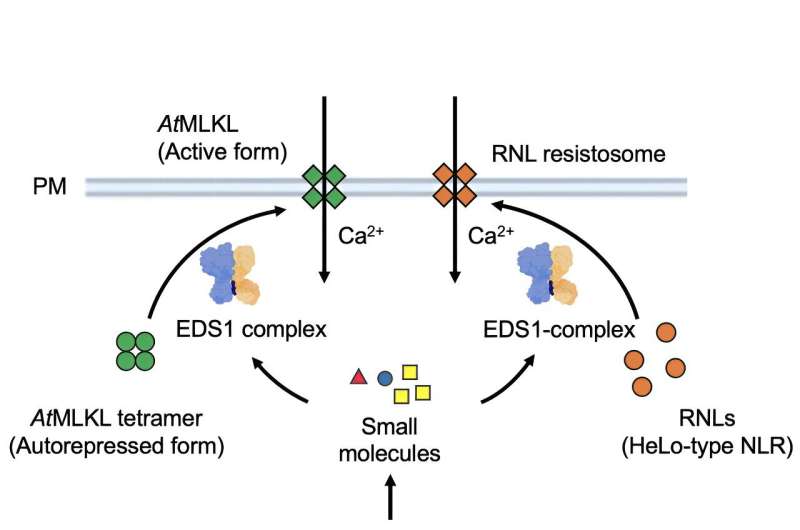
A new study provides insights into how a family of immune proteins in plants confers disease resistance. The study builds on previous research by the same research group, which highlighted the structural similarities of this protein family between plant and animal immune systems.
The study led by Dr. Takaki Maekawa at the University of Cologne's Institute for Plant Sciences and the CEPLAS Cluster of Excellence on Plant Sciences was published in the journal Cell Host & Microbe under the title "Cytoplasmic calcium influx mediated by plant MLKLs confers TNL-triggered immunity".
Both plants and animals face the challenge of having to protect themselves against harmful microorganisms despite their differences in physiology, habitat, and nutritional requirements.
The research group has now identified a new biochemical function of a plant protein family that is similar to so-called mixed lineage kinase domain-like proteins (MLKLs), which induce programmed cell death in animals by damaging the plasma membrane . In this latest study, the team delved deeper into the functionality of plant MLKL proteins.
Their findings suggest a crucial role for these proteins in regulating the calcium ion concentration inside the cells, which is responsible for innate immune responses, mirroring potential functions of animal MLKLs.
The authors first showed that when stress-inducing so-called nicotinamide adenine dinucleotide hydrolases (NADases)enzymes that plants use to generate signaling molecules—are activated, plant MLKL proteins labeled with green fluorescent protein (GFP) cluster into small dots at the plasma membrane in the model plants Arabidopsis thaliana and Nicotiana benthamiana.
This demonstrates that the observed clustering is a general phenomenon in plants. Further investigation revealed that the EDS1-SAG101 scaffold protein complex is required for the dot formations of plant MLKL proteins when signaling molecules are produced. In addition, activated plant MLKLs are required to maintain higher cytoplasmic calcium ion levels in response to bacterial attack. It is likely that the MLKL-mediated increase in cytoplasmic calcium ion concertation further activates the downstream immune machinery.
The plant mutant without functional MLKL is shown to be highly sensitive to filamentous pathogens, such as powdery mildew, compared to bacterial pathogens. This observation suggests that MLKLs play a nuanced role in plant immunity but vary depending on the mode of pathogen infection.
In future studies, the researchers aim to discover the molecular details underlying the function of plant MLKLs that explain the varied sensitivity of mutant plants to different pathogen types. The aim of the new project is to investigate how MLKLs regulate immunity in the tissue context, both spatially and temporally, and how this activation leads to effective plant protection against pathogen attacks.
Finally, this study revealed a number of common regulatory processes for the activation of plant and animal MLKLs, while how activated animal MLKL induces plasma membrane damage remains incompletely characterized. As this study shows that activated plant MLKLs regulate calcium ion concentration, one would expect an animal MLKL function in regulating calcium ion homeostasis.
Journal information: Cell Host & Microbe
Provided by University of Cologne
Explore further
Feedback to editors

Ancient Adélie penguin DNA reveals that small repeats persist for hundreds of millions of years
14 minutes ago

Machine learning provides a new picture of the great gray owl
42 minutes ago

New single-cell analysis tech incorporates advanced fiber optics directly into microfluidic chips
56 minutes ago

The role of interfacial amino acids in shaping bio-electronic communication between proteins

Supercomputer simulations decode the mass puzzle of the first stars

New synthesis platform allows for rapid cancer drug synthesis and testing

Catching vibes: Novel approach captures arthropod-driven vibrations

Chemists discover a key protein in how lysosomes work

Researchers explore the hagfish genome, reconstruct the early genomic history of vertebrates

Atmospheric scientists link Arctic sea loss ice to strong El Niño events
Relevant physicsforums posts, what do large moles on the body indicate.
Mar 30, 2024
Avian flu - A new study led by a team from the University of Maryland
Mar 27, 2024
Are all biological catabolic reactions exergonic?
Mar 20, 2024
A First of Its Kind: A Calcium-based signal in the Human Brain
Mar 18, 2024
Biological culture and cultural biology
Mar 17, 2024
Potentially fatal dog parasite found in the Colorado River
Mar 15, 2024
More from Biology and Medical
Related Stories

For plant and animal immune systems the similarities go beyond sensing
Nov 2, 2020

Researchers solve mystery of how minimalist plant immune molecules become activated
Mar 14, 2024

Manipulating host defenses: Unveiling the role of a powdery mildew effector in grapevine infection
Feb 6, 2024


Scientists uncover how resistance proteins protect plants from pathogens
May 12, 2021

Researchers discover new plant immune pathway based on G protein
Oct 19, 2022

Plant immune proteins trigger cell death
Jun 18, 2021
Recommended for you

Scientist taps into lobsters' unusual habits to conquer the more than 120-year quest to farm them
Mar 29, 2024

Scientists discover a key quality-control mechanism in DNA replication

Researchers reveal evolutionary path of important proteins

Novel role for metabolites in cellular metabolism discovered

Study identifies protein responsible for gas vesicle clustering in bacteria
Let us know if there is a problem with our content.
Use this form if you have come across a typo, inaccuracy or would like to send an edit request for the content on this page. For general inquiries, please use our contact form . For general feedback, use the public comments section below (please adhere to guidelines ).
Please select the most appropriate category to facilitate processing of your request
Thank you for taking time to provide your feedback to the editors.
Your feedback is important to us. However, we do not guarantee individual replies due to the high volume of messages.
E-mail the story
Your email address is used only to let the recipient know who sent the email. Neither your address nor the recipient's address will be used for any other purpose. The information you enter will appear in your e-mail message and is not retained by Phys.org in any form.
Newsletter sign up
Get weekly and/or daily updates delivered to your inbox. You can unsubscribe at any time and we'll never share your details to third parties.
More information Privacy policy
Donate and enjoy an ad-free experience
We keep our content available to everyone. Consider supporting Science X's mission by getting a premium account.
E-mail newsletter

Plant Biochemistry Research Topics
Research topics concerning plant biochemistry linked with biotic and abiotic stresses.
Drought Stress
- A biochemical study to determine the efficacy of plant growth promoters in the Zia mays against drought stress.
- Comparison of volatile organic compounds produced by wheat with and without the drought stress.
- Remarkable features of melatonin in improving plant growth and development under biotic and abiotic stresses.
- Alone and combined application of drought, heat, salt and frost stresses on plant and their effects on the morphological and biochemical properties.
Salinity Stress
- Insights into salt stress-induced changes in antioxidant levels in wheat.
- Effective influence of Bacillus s in maize against the abiotic stresses.
- Assessing the ionic homeostasis in aquatic plants under salt stress and its associated adaptive measures.
- The upregulation of antioxidants and the signaling mechanisms behind them resulted from combined drought and salt stress in wheat.
- Fluctuations in the level of antioxidants resulted from the plant’s encounter with air pollutants.
- Investigation of the ACC deaminase in wheat under the salinity and its prominent role in the remediation of salt stress.
- Evaluating significant efficacy of salinity remediation in the soyabean using different variants of Bacillus sp .
- Abrupt increase in the amino acid content of chickpeas in response to salt stress.
Heavy Metal Stress
- A molecular approach to unlock the heavy metal-resistant defense mechanism in rice.
- Identification of cadmium-tolerant wheat varieties and their underlying mechanisms.
- Exogenous application of organic acid in stimulating plant growth under heavy metal stress.
- Biochemical findings reveal the nickel immobilization mediated through the application of biochar.
- Evaluating proteomics protocols; an investigation of rice phenolics produced under arsenic stress.
- Upregulation of phytochelatins in the presence of mycorrhizal fungal species under the heavy metal stresses in plants.
- A novel approach to discover the leaf senescence in Arabidopsis under stress conditions .
- Identification and characterization of biomarkers linked with the abiotic stress responses in plants.
- Abrupt elevation in the protein and soluble sugars linked with the exposure of cadmium stress and the mechanistic reasoning behind it.
- Quantification of the enzyme activity and its associated biochemical measures in the maize under nickel stress.
- Investigation of the extent of lipid peroxidation in the cadmium-stressed plants.
- Development in metabolomics to better assess the survival responses of plants under heavy metals.
- Cross talk to address signaling cascades involved in the plant defense response against nickel contamination.
- Beneficial role and in-depth analysis of nitric oxide in mitigating heavy metal contamination in the plants.
- Investigating the effective ability of hyperaccumulators in remediating the uranium toxic areas.
- Identification, characterization and expression analysis of arsenic tolerant gene in bacterial strains isolated from the arsenic-contaminated area.
- A cross-talk to better identify and locate the molecular markers associated with the arsenic resistance in the rice.
- Physiological, biochemical and molecular alterations in the young seedling of Oryza sativa to combat the synergistic effects of cadmium and arsenic toxicity.
Unfavorable Conditions and Toxins
- Investigating the physiological and biochemical responses of pea plants in response to different light intensities.
- An abrupt rise in the defense mechanism of Arabidopsis linked with exposure to UV radiation.
- Investigation of unseen potential of total amino acid content for plant survival under unfavorable conditions.
- Upregulation of DNA methylation in the plants in response to the abiotic stresses.
- Identifying the enzymes responsible for the complete metabolism of xenobiotics in plants.
- Increased ability to biotransform and metabolize xenobiotics in higher organisms under the effects of plant metabolites.
- A significant role of glutathione S reductase to mitigate the effects of biocides in plants.
- Biotransformation and detoxification of xenobiotics using microbial assisted phytoremediation.
- A novel attempt to look into aerial and root-specific metabolite production in rice under stress conditions.
- The use of macrophytes in remediating metal contamination in aquatic system.
- Estimating the impacts of industrial effluents on the waterbodies and their environments.
- Detection of groundwater contamination of selenium and arsenic linked with their effects on aquatic life.
- Evaluating the dynamics of rhizobacterial species under the influences of wastewater contamination.
- Plant-mediated phytoremediation of hydrocarbons in the aquatic environment and linked soil systems.

Research Topics Concerning the Improved Nutrient and Metabolite Content in Plants
- Biochemical analysis of two variants of snow peas for lignin accumulation.
- Physiological and morphological improvement of rice attributes linked with the foliar application of salicylic acid.
- Coapplication of iron oxide nanoparticles and biofertilizers in enhancing plant growth and development.
- Differences in the archeal profiles based on the metabolic analysis under the effect of biofertilizers.
- Improved nutritional value of Luffa sp. induced by the activity of biofertilizer.
- Quantification and characterization of extracted proteins from the leaves and roots of sunflowers.
- Protein extraction and identification of bioactive metabolites extracted from seaweed.
- Evaluation of differentially expressed proteins under the effect of drought by gel electrophoresis.
- Efficient investigation of phosphorylated protein sites in the plants resulted from the coapplication of affinity and mass spectrometry.
- Investigating the molecular and biochemical basis of gibberellin, auxin and cytokinin transport in the Luffa sp .
- Biochemical-based effectivity activity of phenols and flavonoids in the plants.
- Biochemical activity of flavonoids extracted from plants and their significant role as a dietary compound.
- Biochemical basis and the reasons underlying the health benefits linked with the dietary compounds synthesized in plants.
- Evaluation of electrochemical and biochemical attributes linked to the production of phytochemicals in the wild-type plant species.
- The significant ability of Moringa oleifera plant to be used as a poultry supplement based on its effective metabolite production.
- A nutritional comparison between two vegetables based on molecular techniques.
- Physiological and biochemical assays to investigate the improved characteristics of sugarcane treated with melatonin.
- The application of fulvic acid enhances the growth and development of plants associated with enhanced nutrient uptake.
- Effects of soil moisture on the plant growth and variations in the photosynthetic pigments due to different water levels.
- Impact of exogenous application of hydrogen sulfide on the growth and yield quality of cherries.
- Identifying the variations in the morphological traits of the plant resulted from the impact of growth regulators.
- Increase in the proline content of plants under the abiotic stresses and investigation of genes involved in them.
- The prominent role of cow dung and its microbial profiling to identify the novel microbe for plant growth and development.
- The isolation and characterization of novel bacterial isolates isolated from the industrial effluents.
- Production of systemically tolerant maize plants based on mycorrhizal species in relation to the action of salicylic acid.
- GC mass spectrometry analysis of plant metabolites extracted from the leaf fractions of Moringa oleifera .
- Cross talk to investigate the potential of methyl jasmonic acid and oxalic acid and a prediction of underlying growth-enhancing mechanisms.
- Enhanced nutritional attributes of maize plant linked with the seed priming with Azobacter .
- Extraction, purification and characterization of effective secondary metabolites in the leaf extract of Luffa acutangula.
- Phytochemical, physiological and biological attributes of plant metabolites linked with efficient growth and development.
- Biochemical evaluation of phenylalanine and polyphenol oxidases regulation in the root nodules of plants.
- Generation of redox active compounds in response to magnesium deficiency in the plants.
- Proteomic correlative pathways in the chickpea-based on the graph clustering method.
Research Topics Concerning the Medicinal Features of Plants
- Detailed analysis of defense response mediated through microbial consortiums in sugarcane.
- Exploring the synergistic and antagonistic effects of microbial communities isolated from various rhizospheric soil samples of medicinal plants.
- Prominent effects of oxalic acid in mediating the defense mechanisms through the enhanced production of antioxidants.
- The positive ability of Jacaranda mosifolia to produce antioxidants, antimicrobials and cytotoxins through its leaf extracts.
- Chemical botanical attributes are promoted by the induction of proteins responsible for pathogenesis.
- Biochemical and physiological profiling of leaves extracts of Asaragaceae sp. to check their ability for being used as a medicinal plant.
- Changed in the antioxidants, and biochemicals attribute, depicting the significant rise in defense mechanism under the effect of zinc oxide nanoparticles in plants.
- A medicinal approach to unveil the health benefits of Moringa oleifera and its nutritional benefits.
- Investigating the medicinal potential of Pueraria lobata based on the estimations of its antioxidant attributes.
- Extraction of a novel compound from Moringa tinctoria root and its significant effects on carbohydrate metabolism.
Research Topics Concerning Genetic and Signaling Cascades Behind the Plant Functioning
- Change in the physio-morpho-biochemical features of wheat and alteration in the gene expression associated with it.
- Differential expression of genes involved in mitigating abiotic stresses and the metabolomic study.
- A molecular-based detailed analysis of temperature-mediated genetic alterations in the wheat.
- The impact of biotic stresses in plants and its effects on the signaling cascade of cytokinin.
- Evaluating the genetic and epigenetic alterations in Arabidopsis under severe heat shocks.
- Discovering the protein channels at the molecular level associated with the stress resistive mechanisms in the plant.
- A detailed meta-analysis and the identification of transcriptional markers present in the medicinal plants’ species.
- Biochemical and physiological mechanisms behind the transgenic plants showing better growth and survival under abiotic stresses.
- Biochemical and genetic analysis of the pathways involved in the generation of antioxidant enzymes in wheat.
- Genetical changes resulted from the combined effect of heat and drought stress in the plant and the prediction of its solution.
- Investigation of the functional protein cascade involved in the defense mechanism of Arabidopsis revealed through biochemical and proteomic analysis.
- Absolute transcriptomics inspection to reveal the growth regulation in the plants.
- Production of transgenic plants to better cope up the pathogenic infection based on the divergent selection of gene clusters.
- Identification of effective genetic markers and construction of maps; an innovation in plant breeding techniques.
- Insights into the genetic makeup of plants and prediction of signaling cascade to find its adaptative features.
- Investigating the efficacy of microsatellite markers to better analyze the genetic attributes in wheat.
- Biochemical and genetic analysis of mechanisms lying behind the effective remediation potential of spermidine to enhance plant development and growth.
- Structural analysis of the Aox1 gene based on the alterations in the transcription and expressional processes in plants.
- Molecular analysis to investigate the activation of acetyl CoA in plants based on the enhanced AccD gene transcription and expression.
- Variation in the allelic gene expression associated with the different environmental conditions.
- Insights into genome editing based on CRISPR to combat heavy metal toxicity.
- Genotype analysis of barley using the microsatellite DNA markers.
Research Topics Concerning Nanotechnology and Biotechnology
- Efficacy of green synthesized nanoparticles in promoting plant growth under biotic and abiotic stresses.
- A significant role of microalgae in the bioproduction of bioethanol using technical approaches.
- Green synthesis of zinc oxide nanoparticles using papaya plant; an eco-friendly approach.
- Molecular analysis of underlying stress mediating efficacy of metal oxide nanoparticles.
- Analyzing the biochemical traits and growth promotion in maize attributed due to the activity of titanium oxide nanoparticles.
- Investigating the molecular processes behind the DNA repair in producing the tolerant plant species.
- Green synthesized gold nanoparticles and their antifungal, antimicrobial and medicinal roles.
- Synergistic ameliorative effects of biofertilizers and nanoparticles for better plant growth, development and yield.
- Generation of resistive plant species using tolerant genes from the microbes based on PCR technique.
- Application of silicon nanoparticles along with oxalic acid as a chelator to cope up drought-induced leaf senescence in wheat.
- Significant amelioration of Avian colibacillosis infection mediated through the combined effect of metal oxide nanoparticle and mycorrhizal species.
- Remarkable potential of CRISPR-CAS concerning the advancements in plant breeding.
- Comparative analysis to unleash the efficacy of crop halophytes; an eco-friendly protocol.
- Advancement in the generation of fermented pheromones to deal with pest problems.
- Evaluation of the efficiency of crop rotation to combat Fusarium head blight in barley and wheat.
- Molecular analysis to investigate the reasoning behind glyphosate tolerance in plants.
- Advantages of high-resolution nuclear magnetic resonance spectroscopy to run physiological analysis in plants.
- In-depth study of salinity-mediated metabolomic and proteomics analysis of wheat roots and leaves.
- Biochemical and HPLC chromatography of phenolic compounds extracted from the tobacco plant.
- Identification and characterization of calcium-binding proteins in maize whole grains.
- Investigation of IgE-linked proteins in the plants and their associated signaling pathways.
- Detection and exploration of protein-protein relations in the membrane-bounded protein complexes of Moringa oleifera .
Research Topics Concerning Microbiology Including Bacterial and Fungal Strains
- Assessing the biochemical traits of isolated bacteria from the root nodules of the plant.
- Antagonistic and synergistic effects of multiple plant growth promoters under field trials.
- Improved chlorophyll content and level of antioxidants in the plants through the combined activity of fungus and bacteria.
- Unraveling the molecular mechanisms behind the fungal mediated plant growth and development.
- Improved plant yield under the effect of Azospirillum sp. ; a significant step to uncover the functions behind it.
- Exploring the antagonistic ability of Pseudomonas sp. against fungal strains in regulating plant development and growth.
- Efficient remediation of salt stress induced in the maize under the effect of different mycorrhizal fungal species.
- Co-effect of biofertilizer and mycorrhizal fungal increases the survival rate in salt-stressed plants.
- Changes in the level of secondary metabolites and phytohormones resulted from different antifungal and antimicrobial treatments.
- Improved soil characteristics after the co-application of microbes and fungal strains against the heavy metal stress.
- Isolation, characterization and biochemical of soil microbes to address their plant growth-promoting abilities.
- Antifungal and antimicrobial properties of tea tree oil and biochemical mechanisms behind.
- Efficacy of tea tree oil in treating skin infections against the fungal species.
- Promising features of Moringa oleifera based on its significant antibacterial characteristics.
- Elimination of leaf rust disease using effectively isolated bacteria from the soil samples.
- Advancements in the discovery of molecular markers associated with the wheat rust disease.
- A novel approach to find the genetic diversity in plants based on the molecular markers.
- Advancements in the identification and designing of molecular markers to detect the yellow rust disease in plants.
- Rapid production of antioxidant and root-associated exudates in maize under the Fusarium
- A comparative analysis to determine the better efficacy of chemical and green synthesized fertilizer in response to fungal infection in barley.
- Nuclear magnetic resonance study to identify the membrane interactive protein complexes in different varieties of Arabidopsis thaliana .
- Upregulation of citrate and malate biosynthesis in plants linked with the usage of biofertilizer assessed through NMR study.
- Significant rise in the auxin biosynthesis enhances the citrate exudation in plant roots; a biochemical analysis.
About The Author
Izzah Usman
Related posts, corporate finance research topics.

Animal Biochemistry Research Topics
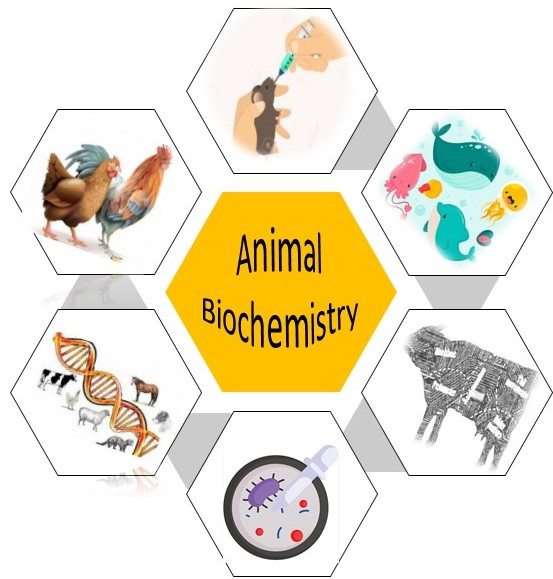
Physics Research Topics

Environmental Science Research Topics

Microeconomics Research Paper Topics

Marketing Research Paper Topics

Leave a Comment Cancel Reply
Your email address will not be published. Required fields are marked *
Save my name, email, and website in this browser for the next time I comment.

The Effects of Climate Change
The effects of human-caused global warming are happening now, are irreversible for people alive today, and will worsen as long as humans add greenhouse gases to the atmosphere.

- We already see effects scientists predicted, such as the loss of sea ice, melting glaciers and ice sheets, sea level rise, and more intense heat waves.
- Scientists predict global temperature increases from human-made greenhouse gases will continue. Severe weather damage will also increase and intensify.
Earth Will Continue to Warm and the Effects Will Be Profound

Global climate change is not a future problem. Changes to Earth’s climate driven by increased human emissions of heat-trapping greenhouse gases are already having widespread effects on the environment: glaciers and ice sheets are shrinking, river and lake ice is breaking up earlier, plant and animal geographic ranges are shifting, and plants and trees are blooming sooner.
Effects that scientists had long predicted would result from global climate change are now occurring, such as sea ice loss, accelerated sea level rise, and longer, more intense heat waves.
The magnitude and rate of climate change and associated risks depend strongly on near-term mitigation and adaptation actions, and projected adverse impacts and related losses and damages escalate with every increment of global warming.

Intergovernmental Panel on Climate Change
Some changes (such as droughts, wildfires, and extreme rainfall) are happening faster than scientists previously assessed. In fact, according to the Intergovernmental Panel on Climate Change (IPCC) — the United Nations body established to assess the science related to climate change — modern humans have never before seen the observed changes in our global climate, and some of these changes are irreversible over the next hundreds to thousands of years.
Scientists have high confidence that global temperatures will continue to rise for many decades, mainly due to greenhouse gases produced by human activities.
The IPCC’s Sixth Assessment report, published in 2021, found that human emissions of heat-trapping gases have already warmed the climate by nearly 2 degrees Fahrenheit (1.1 degrees Celsius) since 1850-1900. 1 The global average temperature is expected to reach or exceed 1.5 degrees C (about 3 degrees F) within the next few decades. These changes will affect all regions of Earth.
The severity of effects caused by climate change will depend on the path of future human activities. More greenhouse gas emissions will lead to more climate extremes and widespread damaging effects across our planet. However, those future effects depend on the total amount of carbon dioxide we emit. So, if we can reduce emissions, we may avoid some of the worst effects.
The scientific evidence is unequivocal: climate change is a threat to human wellbeing and the health of the planet. Any further delay in concerted global action will miss the brief, rapidly closing window to secure a liveable future.
Here are some of the expected effects of global climate change on the United States, according to the Third and Fourth National Climate Assessment Reports:
Future effects of global climate change in the United States:

U.S. Sea Level Likely to Rise 1 to 6.6 Feet by 2100
Global sea level has risen about 8 inches (0.2 meters) since reliable record-keeping began in 1880. By 2100, scientists project that it will rise at least another foot (0.3 meters), but possibly as high as 6.6 feet (2 meters) in a high-emissions scenario. Sea level is rising because of added water from melting land ice and the expansion of seawater as it warms. Image credit: Creative Commons Attribution-Share Alike 4.0

Climate Changes Will Continue Through This Century and Beyond
Global climate is projected to continue warming over this century and beyond. Image credit: Khagani Hasanov, Creative Commons Attribution-Share Alike 3.0

Hurricanes Will Become Stronger and More Intense
Scientists project that hurricane-associated storm intensity and rainfall rates will increase as the climate continues to warm. Image credit: NASA

More Droughts and Heat Waves
Droughts in the Southwest and heat waves (periods of abnormally hot weather lasting days to weeks) are projected to become more intense, and cold waves less intense and less frequent. Image credit: NOAA

Longer Wildfire Season
Warming temperatures have extended and intensified wildfire season in the West, where long-term drought in the region has heightened the risk of fires. Scientists estimate that human-caused climate change has already doubled the area of forest burned in recent decades. By around 2050, the amount of land consumed by wildfires in Western states is projected to further increase by two to six times. Even in traditionally rainy regions like the Southeast, wildfires are projected to increase by about 30%.
Changes in Precipitation Patterns
Climate change is having an uneven effect on precipitation (rain and snow) in the United States, with some locations experiencing increased precipitation and flooding, while others suffer from drought. On average, more winter and spring precipitation is projected for the northern United States, and less for the Southwest, over this century. Image credit: Marvin Nauman/FEMA
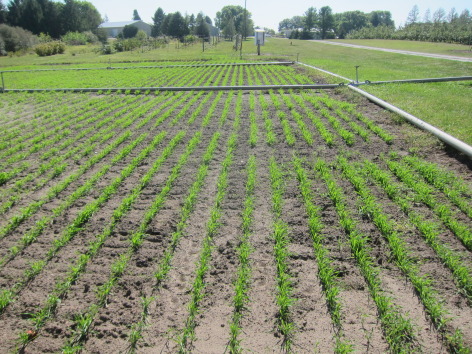
Frost-Free Season (and Growing Season) will Lengthen
The length of the frost-free season, and the corresponding growing season, has been increasing since the 1980s, with the largest increases occurring in the western United States. Across the United States, the growing season is projected to continue to lengthen, which will affect ecosystems and agriculture.

Global Temperatures Will Continue to Rise
Summer of 2023 was Earth's hottest summer on record, 0.41 degrees Fahrenheit (F) (0.23 degrees Celsius (C)) warmer than any other summer in NASA’s record and 2.1 degrees F (1.2 C) warmer than the average summer between 1951 and 1980. Image credit: NASA

Arctic Is Very Likely to Become Ice-Free
Sea ice cover in the Arctic Ocean is expected to continue decreasing, and the Arctic Ocean will very likely become essentially ice-free in late summer if current projections hold. This change is expected to occur before mid-century.
U.S. Regional Effects
Climate change is bringing different types of challenges to each region of the country. Some of the current and future impacts are summarized below. These findings are from the Third 3 and Fourth 4 National Climate Assessment Reports, released by the U.S. Global Change Research Program .
- Northeast. Heat waves, heavy downpours, and sea level rise pose increasing challenges to many aspects of life in the Northeast. Infrastructure, agriculture, fisheries, and ecosystems will be increasingly compromised. Farmers can explore new crop options, but these adaptations are not cost- or risk-free. Moreover, adaptive capacity , which varies throughout the region, could be overwhelmed by a changing climate. Many states and cities are beginning to incorporate climate change into their planning.
- Northwest. Changes in the timing of peak flows in rivers and streams are reducing water supplies and worsening competing demands for water. Sea level rise, erosion, flooding, risks to infrastructure, and increasing ocean acidity pose major threats. Increasing wildfire incidence and severity, heat waves, insect outbreaks, and tree diseases are causing widespread forest die-off.
- Southeast. Sea level rise poses widespread and continuing threats to the region’s economy and environment. Extreme heat will affect health, energy, agriculture, and more. Decreased water availability will have economic and environmental impacts.
- Midwest. Extreme heat, heavy downpours, and flooding will affect infrastructure, health, agriculture, forestry, transportation, air and water quality, and more. Climate change will also worsen a range of risks to the Great Lakes.
- Southwest. Climate change has caused increased heat, drought, and insect outbreaks. In turn, these changes have made wildfires more numerous and severe. The warming climate has also caused a decline in water supplies, reduced agricultural yields, and triggered heat-related health impacts in cities. In coastal areas, flooding and erosion are additional concerns.
1. IPCC 2021, Climate Change 2021: The Physical Science Basis , the Working Group I contribution to the Sixth Assessment Report, Cambridge University Press, Cambridge, UK.
2. IPCC, 2013: Summary for Policymakers. In: Climate Change 2013: The Physical Science Basis. Contribution of Working Group I to the Fifth Assessment Report of the Intergovernmental Panel on Climate Change [Stocker, T.F., D. Qin, G.-K. Plattner, M. Tignor, S.K. Allen, J. Boschung, A. Nauels, Y. Xia, V. Bex and P.M. Midgley (eds.)]. Cambridge University Press, Cambridge, United Kingdom and New York, NY, USA.
3. USGCRP 2014, Third Climate Assessment .
4. USGCRP 2017, Fourth Climate Assessment .
Related Resources

A Degree of Difference
So, the Earth's average temperature has increased about 2 degrees Fahrenheit during the 20th century. What's the big deal?

What’s the difference between climate change and global warming?
“Global warming” refers to the long-term warming of the planet. “Climate change” encompasses global warming, but refers to the broader range of changes that are happening to our planet, including rising sea levels; shrinking mountain glaciers; accelerating ice melt in Greenland, Antarctica and the Arctic; and shifts in flower/plant blooming times.

Is it too late to prevent climate change?
Humans have caused major climate changes to happen already, and we have set in motion more changes still. However, if we stopped emitting greenhouse gases today, the rise in global temperatures would begin to flatten within a few years. Temperatures would then plateau but remain well-elevated for many, many centuries.
Discover More Topics From NASA
Explore Earth Science

Earth Science in Action

Earth Science Data

Facts About Earth

- Open access
- Published: 28 March 2024
Mechanism of action of microRNA166 on nitric oxide in alfalfa ( Medicago sativa L.) under drought stress
- Bochuang Wei 1 , 2 ,
- Yizhen Wang 1 , 2 ,
- Qian Ruan 1 , 2 ,
- Xiaolin Zhu 1 , 2 , 3 ,
- Xian Wang 1 , 2 ,
- Tianjie Wang 1 , 2 ,
- Ying Zhao 1 , 2 &
- Xiaohong Wei 1 , 2 , 3
BMC Genomics volume 25 , Article number: 316 ( 2024 ) Cite this article
64 Accesses
1 Altmetric
Metrics details
Alfalfa is a perennial forage crop of high importance, but its cultivation is often affected by drought stress. Currently, the investigation of drought-related small RNAs is a popular research topic to uncover plant drought resistance mechanisms. Among these small RNAs, microRNA166 (miR166) is associated with drought in numerous plant species. Initial small RNA sequencing studies have shown that miR166 is highly responsive to exogenous nitric oxide (NO) and drought. Therefore, analyzing the expression of Msa-miR166 under nitric oxide and drought treatment is significant.
Bioinformatics analysis revealed that the miR166 family is widely distributed among plants, ranging from mosses to eudicots, with significant distribution differences between species. The evolutionary degree of Msa-miR166s is highly similar to that of Barrel medic ( Medicago truncatula ) and Soybean ( Glycine max ), but significantly different from the model plant Arabidopsis ( Arabidopsis thaliana ). It is suggested that there are no significant differences in miR166s within the species, and members of Msa-miR166s can form a typical stem-loop. The lowest level of exogenous nitric oxide was observed in Msa-miR166s under drought stress, followed by individual drought, and the highest level was observed after removing endogenous nitric oxide.
In response to short-term drought, Msa-miR166s down-regulate expression in alfalfa ( Medicago sativa L.). Exogenous nitric oxide can reduce the expression of Msa-miR166s in response to short-term drought. These findings suggest that Msa-miR166e-5p is responsive to environmental changes. The expression levels of target genes showed an opposite trend to Msa-miR166s, verifying the accuracy of Degradome sequencing in the early stage. This suggests that alfalfa experiences drought stress when regulated by exogenous nitric oxide, targeting HD ZIP-III, FRI, and CoA ligase genes. Additionally, the expression of Msa-miR166s in response to drought stress varies between leaves and roots, indicating spatiotemporal specificity.
Peer Review reports
Alfalfa (Medicago sativa L.) is a valuable perennial forage crop that is rich in protein, fat, vitamins, and minerals. It contains numerous active functional ingredients and has a strong nitrogen fixation ability, resulting in high yield and economic value [ 1 ].
However, alfalfa is primarily cultivated in the arid northern regions of China where water resources are limited, particularly in the northwest. Widespread drought stress during alfalfa cultivation severely limits the yield and quality of alfalfa. In 2014, the global planting area for alfalfa was approximately 2.380 × 10 7 hm 2 , and alfalfa grass production reached 3.41 × 10 8 t [ 2 ]. In 2021, China produced 0.29 million tonnes of alfalfa and imported 0.52 million tonnes of alfalfa hay, according to the latest statistics from China’s State Forestry Administration. This is an urgent issue that requires serious attention. Studying the drought resistance mechanism of alfalfa and improving its drought resistance through biotechnology is significant for agriculture and animal husbandry. “San Deli” was found to be not only a high-yielding forage variety but also nutritionally advantageous after analyzing and screening the grass yield, nutritional composition, and relative feed value of 16 local and foreign lucerne varieties [ 3 ]. Previous studies have shown that “San Deli” is the most sensitive to the “star” signal molecule nitric oxide (NO) among the three varieties of alfalfa: “San Deli”, “Golden Queen”, and “Algangjin” [ 4 ]. The application of NO from an external source can significantly improve the defense response of the alfalfa cultivar “San Deli” to drought [ 5 ].
Nitric oxide (NO) is a gas signaling molecule that plays a significant role in regulating various aspects of plant growth and development [ 6 ]. Recent studies have shown that NO also plays an important role in resisting stress, particularly drought stress [ 7 , 8 ]. Exogenous NO has been observed to alleviate the damage caused by drought stress in various plant species [ 7 , 8 , 9 , 10 , 11 , 12 , 13 ]. This phenomenon has been observed in various plant species, such as Soybean [ 7 , 8 ], Banana (Musa nana Lour ) [ 9 ], Chard (Beta vulgaris L. ) [ 10 ], Rice (Oryza sativa) [ 11 ] , Milk thistle (Silybum marianum L. ) [ 12 ], and Maize (Zea mays) [ 13 ]. Physiologically, exogenous NO regulated fresh and dry weights of above-ground plants [ 7 ], root dry weight [ 10 ], and plant height [ 9 ]. For example, exogenous NO has been shown to promote the generation of adventitious roots in Soybean [ 7 ] and Chard [ 10 ]. It can also reduce yellowing and necrosis of Banana [ 9 ] leaves during drought, thereby improving nutrient uptake and crop yield under drought stress. This positively regulates the plant’s defense mechanisms to cope with limited water conditions [ 7 , 9 , 10 ]. NO also reduces abnormally increased stomatal conductance caused by drought, thereby balancing the transpiration rates and reducing the leaf water loss rate [ 7 ]. This maintains leaf water potential, improves water use efficiency, and increases resistance to drought stress [ 9 , 10 , 11 , 12 , 13 ]. At the biochemical level, it was found that exogenous NO can effectively improve the activity of antioxidant enzymes under drought stress and reduce the production of oxidative products [ 14 , 15 , 16 ]. As stress levels increase, NO can stimulate the production of secondary metabolites, including total phenolics and tocopherols [ 17 , 18 , 19 ]. This activation of the antioxidant system helps to maintain the balance of free radical reactive oxygen species (ROS). This phenomenon has been observed in various plant species, such as Alfalfa [ 5 ], White clover (Trifolium repens) [14] 14 , Soybean [ 8 ], Turfgrass [ 15 ], Tomato (Lycopersicon esculentum Mill) [1616], Wheat (Triticum aestivum L. ) [ 17 ], Maize [ 17 ], and Malus (Malus pumila Mill) [ 18 ] seedlings. This reduces the inducing effect of drought on high levels of ROS, mitigates oxidative damage, preserves the normal function of plant organelles, such as chloroplasts [ 8 , 14 , 18 ] and cell membranes [ 9 , 10 ], and alleviates water loss [ 9 , 19 ] and ion leakage [ 6 , 9 , 14 , 18 ] caused by drought. Furthermore, it has been discovered that exogenous NO can enhance the levels of photosynthetic pigments, which regulate photosynthesis and mitigate the damage caused by excess light energy [ 10 , 12 , 19 ]. This can alleviate the adverse effects of drought on carbohydrate accumulation and energy metabolism in plants, thereby improving drought tolerance in Chard [ 10 ], Milk thistle [ 12 ], White clover [ 14 ], and Trifoliate orange (Citrus trifoliata L.) [ 19 ]. In Arabidopsis [ 20 ], Rice [ 11 ], Maize [ 13 ], and Malus seedlings [ 18 ], it has been discovered that NO causes osmotic regulation by upregulating the accumulation of pressure-compatible solutes. This reduces ion leakage caused by drought and the accumulation of malondialdehyde and soluble proteins in leaves, thereby alleviating the adverse effects of drought on plants [ 11 , 13 , 18 ]. At the molecular level, plants respond to drought by sensing external drought stimuli through sensors in the biofilm and transmitting information through various signal transduction pathways [ 5 , 14 , 20 ]. This results in alterations to the expression and adaptation of genes that respond to drought [ 5 , 14 , 20 ]. These genes are regulated by complex mechanisms, including transcriptional cascade reactions [ 6 ]. Plant miRNAs are a type of endogenous small, single-stranded non-coding RNA molecules. They are approximately 20–24 nt in length and are derived from longer precursor (pre-miRNA) molecules with stem-loop structures [ 21 ]. In plants, mature miRNAs target mRNA after transcription through gene silencing complexes, resulting in the transcriptional silencing and regulation of target genes [ 22 ]. Plants respond to stress by stimulating signal transduction substances, stress-protective substances, and secondary metabolites [ 23 , 24 ].
MiR166 plays a critical role in several developmental processes and regulates biotic and abiotic stresses in major crops [ 25 ]. It is particularly effective in response to abiotic stresses such as drought [ 27 ], salinity [ 28 , 29 ], temperature [ 31 ], and excess cadmium [ 24 ]. The morphological development of plants is altered, enhancing their stress resistance [ 26 ]. The miR166 plays a critical role in the response to drought stress in plants such as Maize [ 24 ], Rice [ 27 ] and Arabidopsis [ 26 ]. A silencing vector for miR166 was constructed in the dicotyledonous plant Arabidopsis [ 26 ] using short tandem target mimic technology (STTM) to obtain the maize silencing the miR166 strain: STTM166. It was found that Rice-STTM166 [ 27 ] and Maize-STTM166 [ 28 ] showed significantly greater drought resistance than the wild-type. Phylogenetic analysis and Reverse-Transcription Quantitative PCR (qRT-PCR) revealed that drought significantly affects the expression of MiR166s and their target genes in plants, including Highbush Blueberry [ 29 ], Soybean [ 30 ], Tea [ 31 ], and Dimocarpus longan Lour [32]30. Under drought treatment, the expression of MiR166 decreased to varying degrees in Soybean [ 30 ] and Highbush Blueberries [ 29 ], with some showing downregulation followed by upregulation. This particular miRNA targets primarily the HD-ZIP III gene family, which comprises a significant number of members [ 25 ]. Several studies have demonstrated that HD ZIP-III plays a crucial regulatory role in the development of plant vascular tissue [ 33 ]. This improves drought resistance by modifying plant vascular development and leaf structure [ 34 , 35 ]. The study used qRT-PCR to identify 42 Zmhdz9 genes with varying expression patterns during drought and rehydration treatment in maize [ 36 ]. Thirteen genes were upregulated, three genes were downregulated, and 26 genes exhibited an irregular expression trend [ 37 ]. Furthermore, overexpression of the alfalfa Mfhb-1 gene significantly improved drought tolerance in both Arabidopsis and alfalfa [ 37 ]. The overexpression of ATHB-7 in Arabidopsis and Tobacco significantly enhanced their drought resistance [ 38 ]. It was observed that ATHB-7 was mainly expressed in the root system during the seedling stage in Arabidopsis. The overexpression of ATHB-6 has been found to enhance drought resistance in maize and promote root growth [ 39 ].
Alfalfa is a leguminous plant genus that is renowned for its high protein and vitamin content, earning it the nickname “king of forage”. However, alfalfa is typically susceptible to drought stress during the growing season. Therefore, it is essential to conduct further research into alfalfa’s response to stress and the discovery of small RNAs and genes related to stress resistance to promote the breeding and improvement of alfalfa. Recent advances in high-throughput sequencing technology and bioinformatics have enabled the identification and analysis of the alfalfa miR166 family at the whole-genome level. While the function of miR166 has been reported in other plants, its role in alfalfa has been scarcely investigated. This study screened Msa-miR166s from previous data [ 40 ] and systematically analyzed the evolutionary analysis, stem ring structure, and expression profile of members of this family. The expression differences of MiR166s and its target genes in roots and leaves under drought and nitric oxide were analyzed using qRT-PCR. The spatiotemporal expression of MiR166s and their target genes in alfalfa provides a foundation for further research on the function of MiR166s in alfalfa.
Materials and methods
Plants’ material.
The selected seeds of the alfalfa variety “San Deli” were provided by Jiuquan Future Grass Industry Co., LTD. The scientific name of Suntory is Medicago sativa L. The variety was registered under No. 247 on December 11, 2002. The applicants were Chen Gu et al. and Bailu Tianjin International Co., LTD. The material for the qRT-PCR experiments in this article, alfalfa (“San Deli” variety Medicago sativa L.), was grown indoors in 2023. Each pot was sown with approximately 20 seeds. All seedlings were grown at a temperature of 25 °C under the same photoperiod of 14 hours of light and 10 hours of darkness. They were watered every 2 days and regularly supplied with Hoagland nutrient solution. The treatment began when the “San Deli” seedlings were in the seedling stage, 45 days after growth. Each experimental and control group consisted of eight pots of 45-day-old alfalfa plants. The study involved two experimental groups and a blank control group. The first experimental group was administered exogenous nitric oxide through a 0.1 mmol/L Sodium Nitroprusside (SNP) solution, while the second experimental group was administered 200 μM Carboxy-PTIO potassium salt (PTIO) solution to clear endogenous nitric oxide. During the pretreatment, the leaves were sprayed once every evening for four consecutive days until the end of the drought treatment. As a control variable, the control group was sprayed with ddH 2 O during the pretreatment, similar to the experimental group. On the fourth day, after 3 days of continuous pretreatment, all experimental materials were subjected to drought stress by irrigating their roots with a 15% PEG-6000 solution. Samples were collected at 0, 6, 12, and 24 hours after irrigation. The control group in question was named the PEG group. The samples were rinsed with ddH 2 O, dried, randomly collected, and stored at − 80 °C. Small RNA Sequencing (Small RNA-seq) [ 40 ] and degradome sequencing experiments in 2019 and 2020, respectively. The experimental materials were divided into three groups: a drought-treated group, a drought-treated group after NO pretreatment, and a blank control group. All other treatment conditions were the same as previously described.
Acquisition of Msa-miR166 family member
The miR166 family members and their target sequences of alfalfa were obtained from our experimental group’s previous Small RNA-seq and Degradome Sequencing. We obtained four pre-miR166s, namely Msa-miR166a, c, d, and e, along with four mature sequences, namely Msa-miR166a, c, e-5p, and g-5p, through Small RNA-seq in 2019. The precursor sequences are shown in Supplementary Table 1 . The Degradome sequencing of the “Xinjiang Daye” variety of alfalfa [ 41 ] revealed six new mature Msa-miR166s. Upon comparison, they were identified as Msa-miR166b, d, f, g-3p, and e-3p, with only two sequences differing from the known Msa-miR166s sequence. Consequently, the primers designed for these six different Msa-miR166s were used for the qRT-PCR experiment.
The target gene of Msa-miR166s was preliminarily predicted through degradome sequencing with reference to alfalfa genome data. Supplementary Table 3 shows the corresponding target gene sequence of Msa-miR166. Primers for the qRT-PCR experiment were designed based on six selected genes.
Statistical analysis of MiR166 distribution in plants
This article uses a total of 293 pre-miR166 sequences and 358 mature sequences from 50 species, including 289 pre-miR166s and 350 mature miR166s downloaded from the miRbase website ( http://www.miRbase.org/ ) and data from alfalfa obtained from preliminary experiments. Using the botanical classification from the miRbase website and the phylogenetic tree of the APG IV system ( https://duocet.ibiodiversity.net/index.php?title=APG_IV%E7%B3%BB%E7%BB%9F ), we conducted a quantitative statistical analysis to investigate the distribution of tMiR166s across various families, genera, and species.
Multiple sequence alignment and phylogenetic analysis of Msa-miR166s
The mature sequence of Msa-miR166s was compared using Dnaman 8.0 software. A Web Logo was generated using online software ( https://weblogo.berkeley.edu/logo.cgi ) to illustrate the degree of motif conservation in the mature body conservative sequence. The Neighbor-joining (NJ) method and bootstrap of MEGA11 software [ 41 , 42 ] were used to perform 1000 bootstrap tests. The phylogenetic tree for pre-miR166s and the mature miR166 sequence of several species were constructed. The related members of alfalfa were then identified.
Prediction of the secondary structure of MIR166s and their target genes
The mfold web server ( http://unafold.rna.albany.edu/?q=mfold ) was used to predict the secondary structure of Msa-miR166 precursor transcripts. Target genes for Msa-miR166s were predicted by analyzing Degradome sequencing data.
RNA extraction, reverse transcription and qRT-PCR
Following sample collection, total RNA was extracted using the UNIQ-10 column Trizol total RNA extraction kit (Sangon Bioengineering Co., Ltd., Shanghai) and the TIAN Script II RT Kit (Tiangen Biochemical Technology Co., Ltd., Beijing). RNA concentration and purity were examined using Nanodrop 2000 (Thermo Fisher Scientific, USA), RNA integrity was examined through agarose gel electrophoresis, and RIN values were determined by Agilent 5300 Bioanalyzer (Agilent, USA).
The TaqMan™ Advanced miRNA cDNA Synthesis Kit (Tailing Reaction, ThermoScientific) was used to synthesize miRNA cDNA templates for qRT-PCR. The qRT-PCR analysis employed specific forward primers and universal reverse primers designed for mature miR166. The primer sequence can be found in Supplementary Table 2 . The U6 gene was used as the internal reference gene for Msa-miR166s. The selection of internal reference genes was based on the results of Yao-dong Zhao [ 40 ].
The cDNA was transcribed using the Evo M-MLV Reverse Transcription Premixed Reagent Kit (which includes a gDNA removal reagent for qRT-PCR) Ver.2 (Accurate Biology). Primers for the target genes were designed using NCBI Premier-BLAST (see Supplementary Table 4 ). The amplified fragments were approximately 100–200 bp. The elongation factor 1 alpha, EF-1α, was used as the internal reference gene for the target gene in the root, while the 18SrRNA was used as the internal reference gene for the target gene in the leaves. The internal reference gene sequences are presented in Supplementary Table 4 . The selection of these genes was primarily based on Fu Yuanyuan’s results [ 43 ]. The entire experiment was conducted using the Quantageneq225 qRT-PCR instrument, and the primer sequences were synthesized by Shenggong Biotechnology (Shanghai) Co., Ltd.
For statistical analysis and data calculation, Microsoft Excel (Office 2021) was utilized. The analysis of variance was conducted using SPSS Statistics 19.0 software (SPSS Inc., Chicago, IL), and the mean values were compared using a student’s t-test at a 5% significance level. The results represent the average of three repeated experiments. The relative expression of miRNA and predicted target genes under different treatment times was calculated using 2 -ΔΔCT , and the results are displayed as log 2 FC. This method was described in [ 44 ].
Table 1 shows the distribution of the miR166 family across dicotyledons, monocotyledons, and other angiosperms, as well as gymnosperms such as China fir ( Cunninghamia lanceolata , Picea abies ), P. densata ( Pinus densata ), and loblolly pine ( Pinus taeda ), and older ferns such as Herba Selaginellae Moellendorfii ( Selaginella moellendorfii ) and Physcomitrella patens ( Bryophyte Physcomitrella patens ). The number of miR166 family members varies significantly among different species in terms of quantity. For instance, the number of mature MiR166 bodies in Leguminosae varies from 1 in Birdsfoot trefoil ( Lotus corniculatus) and Bean ( phaseolus vulgaris ), to 27 in Soybean, and 10 in Barrel Medic. In the Gramineae family, Maize has 26, Rice has 24, Purple Falsebrome ( Brachypodium distachyon ) has 18, Sorghum ( Sorghum bicolor ) has 11, Goat Grass ( Aegilops tauschii ) has 10, Barley ( Hordeum vulgare ) has 3, Sugarcane ( Saccharum SP ) has 1, and Tall Fescue ( Festuca arundinaceous ) has 1 (refer to Table 1 ). The distribution of miR166s is uneven within certain families and genera. For example, within gymnosperms, China fir has the lowest number of mature sequences, with only one. Similarly, monocotyledonous grasses in angiosperms, such as Tall Fescue and Sugarcane, have only one mature sequence. There is only one complete sequence for dicotyledonous angiosperms, such as the legumes Birdsfoot Trefoil and Phaseolus vulgaris , the trifoliate orange of the Rutaceae, and Gossypium hirsutum of the Malvaceae. Additionally, there are species with only one mature sequence in Compositae. The Leguminosae Soybean had the highest number of MiR166s, with a total of 26. Maize had the second-highest number, also with a total of 26.
Before the emergence of monocotyledons, the number of mature bodies in mir166 was equal to the number of precursors. However, in monocotyledons, the number of mir166 mature bodies exceeds the number of precursors. In 16 species of angiosperms, the number of mature bodies exceeded the number of precursors, while in 25 species, the number of mature bodies was equal to the number of precursors. Alfalfa belongs to the dicotyledonous plant family Leguminosae, and together with Barrel Medic are the two most important species in the genus Alfalfa. Barrel Medic has 8 miR166 precursors and 10 mature bodies; Soybean, which is also a legume, has 21 miR166 precursors and 26 mature bodies.
The evolutionary analysis of the pre-miR166 family
The pre-miR166s of Arabidopsis, Soybean, Tribulus Terrestris , Birdsfoot trefoil, and Phaseolus vulgaris of Leguminosae were obtained from the miRBase database. Arabidopsis has 7 members, Soybean has 21 members, Tribulus Terrestris has 7 members, Birdsfoot trefoil has 1 member, and Phaseolus vulgaris has 1 member. The Small RNA-seq data obtained four pre-miR166s in Alfalfa. Figure 1 shows the phylogenetic tree of the miR166 family, which is divided into three branches. The Pick branch includes miR166f and miR166d of Arabidopsis, miR166e and miR166b of Barrel Medic, and miR166j and miR166h of Soybean. The blue branch comprises miR166a and b of Arabidopsis, miR166a, c, r, t, and s of soybean, miR166b, c, and g of barrel medic, and miR166c and g of alfalfa. The yellow branch includes additional members of MiR166s discovered in Soybean, Arabidopsis, Barrel Medic, and Alfalfa, as well as all members of Birdsfoot trefoil and Phaseolus vulgaris . The evolutionary tree shows that Msa-miR166a is most closely related to Mtr-miR166a, followed by Mtr-miR166h. Msa-mir166c is most closely related to Mtr-miR166c, followed by Ath-miR166a. Msa-mir166e is most closely related to Mtr-miR166e, followed by Gma-miR166e. Finally, Msa-miR166g is most closely related to Mtr-miR166g, followed by Gma-miR166a and Gma-miR166c. Msa-miR166e is the longest branch on the evolutionary tree among the four known precursors of alfalfa. Its branch is of equal length to the evolutionary branches of Ath-miR166b, d, and g.

Evolutionary tree of pre-miR166 in leguminous plants and Arabidopsis model plant The scale represents the average number of amino acids at each site
The precursor sequences of Msa-miR166 members were analyzed using DNAMAN and MEAG11 alignment tools across various branches (refer to Fig. 2 ). The analysis revealed that precursor sequences with the same length had a high similarity of 100%, with a minimum of 89%. Figure 2 shows that Msa-miR166s are highly conserved. Create a conservative motif diagram in TBtools with base sequence directions ranging from 5′ to 3′. The conservative motifs of each branch exhibit significant differences, but a highly conservative motif is present at the 3′ end. In contrast, the conserved pattern of miR-166 at the 5’ end is unstable. In particular, the part of the pink branch where Msa-miR166e is located.
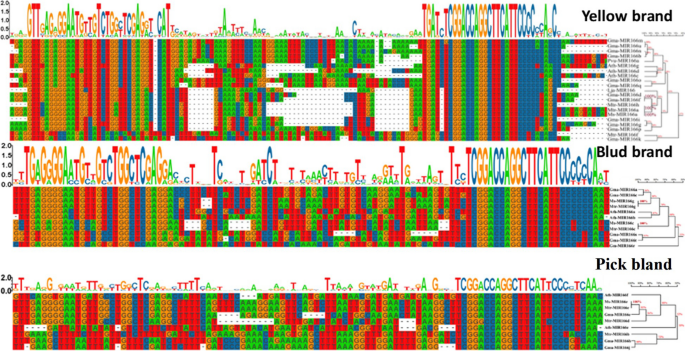
Conservative motifs in the branch of the pre-miR166 evolutionary tree The yellow brand corresponds to the branch with a base colour of yellow in the evolutionary tree of Fig. 1 ; the Blud brand corresponds to the branch with a base colour of blue in the evolutionary tree of Fig. 1 ; and the Pick bland corresponds to the branch with a base colour of pink in the evolutionary tree of Fig. 1
The secondary structure of Msa-miR166 precursor transcripts was predicted using the mfold web server, while the target genes of Msa-miR166s were predicted using degradome sequencing analysis. The secondary stem-loop structure of the precursor sequences of the Msa-miR166 family members is predicted online according to the system defaults of the RNA folding form built into the mfold web server website. The miR166 family has typical RNA hairpin structures that correspond to the basic structural characteristics of miRNA. Among them, the free energy of Msa-miR166a is − 48.6 kcal/mol, the free energy of Msa-miR166c is − 42.80 kcal/mol, the free energy of Msa-miR166e is − 50.2 kcal/mol, the free energy of Msa-miR166g is − 45.7 kcal/mol, and the average free energy is − 46.5 kcal/mol. The free energy of Msa-miR166a and Msa-miR166e is higher than the average free energy. There are differences in the length of the precursor sequences among the four members of the Msa-miR166 family, with Msa-miR166a being the shortest and Msa-miR166g being the longest. Secondary structure analysis of the precursor sequences showed that the precursor sequences of all four Msa-miR166 members could form stable stem-loop structures. The mature miRNA sequences of Msa-miR166a and Msa-miR166c were located at the 3′ end, while those of Msa-miR166e and Msa-miR166g were located at the 5’ end (Fig. 3 A).
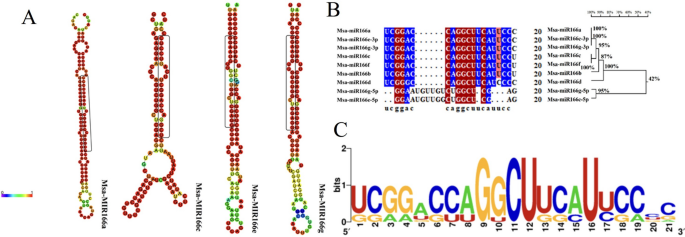
Conserved bases and conserved motifs map of predicted secondary structure of Msa-miR166 family precursors with mature body sequences, A Stem-loop Structure of Msa-miR166 Precursor Family Members, the mature miRNA portion is highlighted in a black box; B Base Conservation Analysis of Mature Body Sequences of Msa-miR166 Family; C Conservative motif diagram of mature body sequences of Msa-miR166 family
The target genes, Transcript ID, and splicing sites of Msa-miR166a, b, c, d, e-5p, and g-5p were predicted by referring to the Alfalfa genome of “Xinjiang Daye” varieties. Through nonparametric analysis of Degradome Sequencing (see Fig. S 1 ), it was observed that Msa-miR166a, b, and c regulate the expression of target gene Ms-ATHB-15 , Ms-ATHB-8 , and Ms-REV through the same cleavage site. Similarly, Msa-miR166b and Msa-miR166c regulate the expression of the target gene Ms-CoA ligase through the same cleavage site. In addition, Msa-miR166e-5p and Msa-miR166g-5p respectively regulate the expression of target genes Ms-FRI and Ms-SF1 (Table 2 ).
By analyzing the primary and secondary structures of the target genes (Supplementary Table 5 ), it was found that the target genes regulated by the Msa-miR166s are mostly hydrophobic proteins and that the structures of Ms-ATHB-8 and Ms-REV , both belonging to the HD ZIP III family, are similar.
The evolutionary analysis of the mature miR166s of plants
Mature mir166 characteristics in alfalfa.
Comparative searches in the mirBase database, using Msa-miR166 sequences, revealed that Msa-miR166s matched extremely well with miR166s from Barrel Medic, Soybean, Maize, and Rice (Table 3 ). Both known and newly discovered miR166s in alfalfa can be found in other species with known mature miR166s with the same base sequence. It can be seen that Msa-miR166s is very conservative in the evolution of plant miR166s (Table 3 ).
Sequence alignment of mature Msa-miR166s
The Msa-miR166 family members’ internal evolution tree was created using DNAMAN 8.0 software. The results were classified into two categories: Msa-miR166g-5p and Msa-miR166e-5p were grouped, while the remaining members were grouped separately. The similarity between Msa-pre-miR166a and Msa-pre-miR166e-3p sequences was high, reaching 95.79%. Upon analyzing eight mature sequences of Msa-miR166 family members, it was discovered that the mature sequences of Msa-miR166 members with the same length were entirely consistent (Fig. 3 B).
Web Logo was used to generate the logo of the conserved sequence of the mature body of the miR166 family (Fig. 3 C). The conservative motif is visible, including a G base at the ninth position, a C base at the eleventh position, and U bases at the twelfth and sixteenth positions.
Evolutionary analysis of mature miR166s in plants
The evolutionary tree shows that the -3p and − 5p of MiR166 differentiate into two branches, when there is only one mature sequence, most of it is located in the -3p branch (Fig. 4 ). All seven mature sequences of Msa-miR166a, d, b, c, f, g-3p, and e-3p are located on the -3p branch of the evolutionary tree, except for Msa-miR166g-5p and e-5p on the -5p branch(Fig. 4 ). The evolutionary tree has no obvious root node, its branches are sequential, and the eight alfalfa miR166s are sequentially distributed on the different branches of the tree. In addition, the phylogenetic tree shows that Msa-miR166s have the closest relationship with Leguminous dicotyledonous plants such as Barrel medic and Soybean, followed by Gramineae of Monocotyledon such as Maize and Rice, Poaceae (Fig. 4 ).
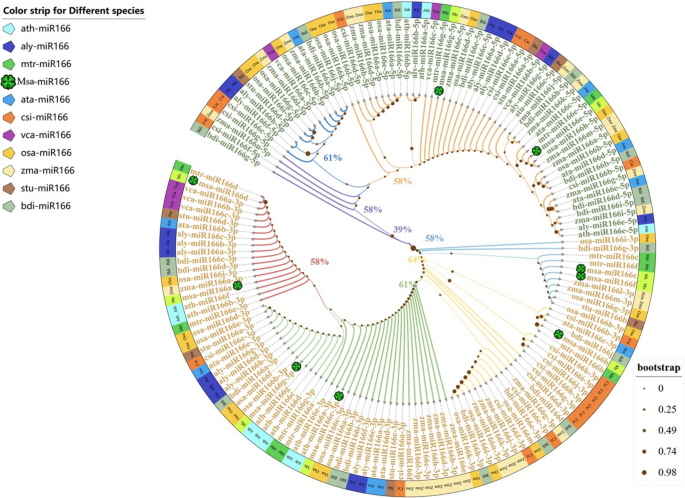
Analysis of the expression patterns of Msa-miR166s and its target genes in young alfalfa seedlings
Total rna isolation related gel images.
RNA was extracted from 12 samples and subjected to agarose gel electrophoresis. The resulting gel showed three distinct bands: 28S, 18S, and 5S (Fig. 5 ). These bands can be used as qRT-PCR experimental templates for the next step.
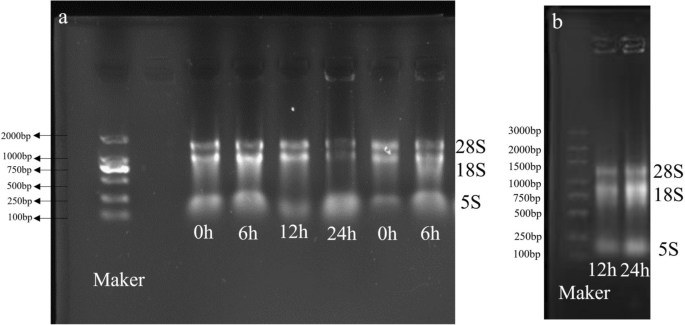
Total RNA isolation related gel images From left to right, samples were taken at 0 h, 6 h, 12 h, and 24 h in both roots and leaves
Results of qRT-PCR
As illustrated in Fig. 6 , the expression level of Msa-miR166s in the root remained constant in the PEG group at 0 hours. During the progression of the drought, the expression of mir166a, b, c decreases within 6 hours after the onset of drought, but rapidly increases at 12 hours, surpassing the expression level at 0 hours. The minimum increase is 1.2 times and the maximum increase is 3 times. However, at 24 hours, it rapidly decreased once more. After the drought, the expression levels of Msa-miR166d, e-5p, and g-5p gradually decreased and then increased, reaching their lowest value at 12 h, which was 0.4 times that of the 0 h. At 24 hours, the expression level increased once more and remained consistent with the level observed at 0 hours. Following the removal of NO from the plant body through PTIO treatment, the expression level of miR166s decreased at 0 h. However, at 6 h of drought, the expression level of miR166s did not change significantly. Even Msa-miR166a, b, d, e-5p showed a downward trend. However, at 12:00, the expression level of Msa-miR166a, b, c, and d increased to its maximum, which was approximately five times that of PTIO at 0 h. There was no significant change in the expression level of Msa-miR166e-5p or g-5p after 12 hours of drought. After 24 hours, the expression levels of Msa-miR166a, b, and c decreased, while the expression level of Msa-miR166d and Msa-miR166e-5p remained almost unchanged. Additionally, the expression level of Msa-miR166g-5p increased by almost double. After applying external NO, the expression level of Msa-miR166s in roots fluctuated at 0 h. However, after drought treatment, the expression level of mir166s rapidly decreased by three orders of magnitude. At 12 h after drought, there was a slight rebound, still significantly lower than the expression level at 0 h; At 24 h, it rapidly decreased to the level at 6 h.
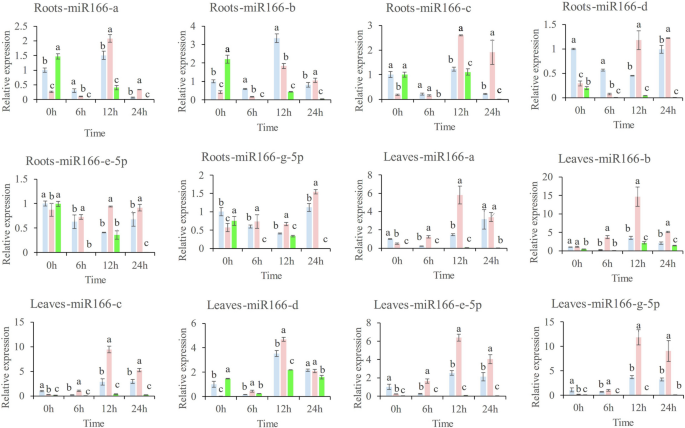
Relative expression of Msa-miR166s in Roots and leaves Note: 0 h: The experiment involved alfalfa plants that were not subjected to drought treatment, as well as those that were treated with drought for 6, 12, and 24 hours. Each group, both experimental and control, consisted of three pots of plants. The PEG group is represented by blue bars, the PTIO group by pink bars, and the SNP group by green bars. Error bars indicate the standard error (SE) of three biological and three technical replicates. Different letters indicate significant differences ( p < 0.05) between samples, as determined by Tukey’s test. The values were normalized using the U6 gene
Under drought conditions, the expression changes of Msa-miR166s in leaves were consistent with those in roots. After the drought, all values decreased before increasing again. However, the peak reached was larger than that of the roots. Apart from Msa-miR166b, the expression levels of the other Msa-miR166s changed after 12 and 24 hours of drought. For instance, Msa-miR166a reached its maximum value in the leaves after 24 hours, which was later than the peak observed in the roots. In the PTIO group, the expression levels of Msa-miR166s were consistent between leaves and roots at 0 h and 6 h under continuous drought. However, at 12 h, the expression levels in leaves reached their maximum values and decreased slightly at 24 h, remaining slightly lower than the expression levels at 12 h. In the group of SNPs, the Msa-miR166s present in the leaves were distinct from those found in the roots. The expression level was lower before the drought and decreased again at 6 hours of drought, but increased at 12 hours. The peak value remained lower than that of the PEG group at the same time and decreased again after 24 hours. The expression level of Msa-miR166s in the PEG group was 100 times higher than that in the SNP group.
In comparison to the expression changes of Msa-miR166s, the expression changes of these six genes exhibit an opposite trend (refer to Fig. 7 ). This confirms the results of degradation group sequencing and preliminarily identifies these six genes as the target genes of Msa-miR166s. After the drought treatment, the target genes of the SNP group in the roots gradually upregulated, and slightly flattened or decreased at 12 h. This is consistent with the slightly increased expression of Msa-miR166s in the roots at 12 h. The target genes in leaves that are affected by the SNP group exhibit a baseline expression at 0 h. Following drought treatment, their expression levels peak at 6 h and subsequently decrease to varying degrees. The expression of Msa-miR166 in leaves showed consistency with the fluctuation observed during drought, with low levels at 0 h and 6 h and high levels at 12 h and 24 h.
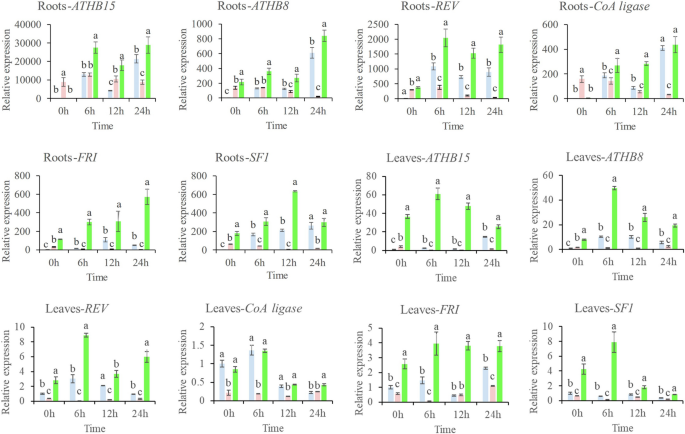
Expression of the target gene in roots and leaves Note: 0 h: The experiment involved alfalfa plants that were not subjected to drought treatment, as well as those that were treated with drought for 6, 12, and 24 hours. Each group, both experimental and control, consisted of three pots of plants. The PEG group is represented by blue bars, the PTIO group by pink bars, and the SNP group by green bars. Error bars indicate the standard error (SE) of three biological and three technical replicates. Different letters indicate significant differences ( p < 0.05) between samples, as determined by Tukey’s test. The values were normalized against the 18SrRNA gene in the leaves and EF-1α in the roots
The alfalfa “San Deli” variety stands out among forage plants for its high yield and quality, but its cultivation is usually limited by drought [ 2 , 3 ]. In early studies on enhancing drought tolerance in “San Deli”, our experimental group found that nitric oxide, a signaling substance, was effective [ 1 , 3 ]. Following treatment with exogenous nitric oxide, “San Deli” was found to produce differential small RNAs in response to drought stress. It was discovered that MIR166 is particularly sensitive to both drought and NO [ 40 ]. MiR166 plays a crucial role in the formation [ 45 , 46 , 47 , 48 ]. It participates in the formation of Arabidopsis roots and maintains the abaxial fate of lateral organs by restricting the expression of HD-ZIP IIIs in the adaxial domain [ 45 ]. Likewise, the overexpression of MiR166a stimulated the growth of lateral roots in Larix Leptolepis seedlings [ 46 ]. In these transgenic roots, MIR166 overexpression resulted in a decrease in the number of symbiotic nodules and lateral roots, as well as the induction of ectopic development of vascular bundles [ 47 ]. Furthermore, transgenic Arabidopsis that overexpressed MIR166 displayed stunted growth and ultimately perished before producing rosette leaves. These plants lacked SAM and accumulated a significant amount of anthocyanin pigments. Alternatively, some plants exhibited mild growth retardation during the seedling stage but continued to grow into the reproductive phase [ 48 ]. MiR166 regulates both organogenesis and vascular development [ 47 , 49 , 50 ]. MiR166 is localized in the leaves, roots, and internode xylem of bamboo seedlings. It targets HOX and serves as a regulatory factor for the differentiation of bamboo vascular tissue [ 49 ]. MiR166 induced cambium differentiation in Populus alba by targeting HB1 under the regulation of the developmental process and season [ 50 ]. Furthermore, it has been discovered that mir166 plays a role in the production of secondary metabolites [ 51 ]. For instance, miR166 was found to be involved in the biosynthesis of piperine, a secondary metabolite in black pepper (Piper nigrum L.) , and the regulation of gallic catechin levels in tea trees [ 51 ]. MiR166 plays a crucial role in regulating plant growth, development, and responses to abiotic and biotic stresses. Research has shown that miR166 responds to drought stress in plants, including Arabidopsis [ 26 ]., Highbush Blueberry [ 29 ], and Soybean [ 30 ]. Furthermore, it was observed that STTM166 plants exhibited stronger drought resistance compared to wild-type plants [ 27 , 28 ]. Additionally, some STTM166 plants displayed stunted growth while promoting lateral root development [ 26 , 27 , 28 ]. However, in high-bush blueberries, Vco-miR166s were upregulated under freezing, low temperature, and high temperature stress, affecting the plant’s response to abiotic stress [ 29 ]. In rice, MiR166 plays a crucial role in the accumulation and tolerance of Cd by regulating its target gene OsHB4 [ 35 ]. Regarding diseases, the sly-miR166/SlyHB module in tomatoes was found to be a negative regulatory factor for plant defense against Tomato leaf curl New Delhi virus (ToLCNDV) [ 52 ]. Under UV stress, MiR166 regulates auxin signaling by targeting auxin response factors (ARFs), which alters plant growth and development in response to UV stress [ 54 ]. However, there are few reports on the functional research of miR166 in alfalfa. Therefore, this study focuses on the bioinformatics analysis of MiR166 in alfalfa and predicts its target genes. The study analyzed the spatiotemporal expression of Msa-miR166s and their target genes in alfalfa roots and leaves under exogenous nitric oxide treatment in response to drought using qRT-PCR.
Previous studies have identified the miR166 family as an ancient class of miRNAs in plant evolution [ 25 ]. The distribution of members of the miR166 family in plants, as shown in Table 1 , was analyzed statistically. Figure 2 illustrates that all branches exhibit clear conserved motifs, suggesting that Msa-miR166s are highly conserved. The evolutionary analysis of plant pre-miR166s is consistent with previous research [ 25 , 27 ]. MiR166 is present throughout the plant kingdom, with no significant difference in distribution between dicotyledonous and monocotyledonous plants (see Table 1 ). However, MiR166 has the same number of mature bodies as its ancestors in older species, such as mosses, ferns, and gymnosperms. In angiosperms, the excess of mature bodies compared to the number of precursors suggests that some MiR166 precursors cleave into two distinct mature bodies that are retained [ 55 ]. It is suggested that the conservation of an increasing number of MiR166-5p mature bodies has contributed to the adaptation of angiosperm plants to their environment. The symptoms of leaf yellowing caused by potato virus X on Nicotiana benthamiana were reduced and virus accumulation decreased when nbe-miR166h-p5 was suppressed [ 53 ]. The analysis of plant pre-miR166s evolution (Fig. 3 A) provides a further explanation that the 3′ end of pre-miR166 contains a highly conserved motif. The conserved motif of the 5′ end is relatively unstable, particularly in the 5′ end of the pink branch (Fig. 2 ), which includes Msa-miR166e. Figure 3 illustrates that Msa-miR166a and Msa-miR166c originate from the 3p end of their precursors, while Msa-miR166e-5p and Msa-miR166g-5p originate from the 5p end of their precursors. The predicted target genes for Msa-miR166s revealed that HD ZIP III, a typical target gene family of mir166s [ 30 , 45 ], was targeted by Msa-miR166a and Msa-miR166c. However, Msa-miR166e-5p and Msa-miR166g-5p, which were FRI and SF1 genes respectively, did not belong to the HD ZIP gene family. Combined with Fig. 2 , Msa-miR166e is unstable at the 5-terminal end and it is hypothesized that the resulting Msa-miR166e-5p matrices may differ from typical miR166s in terms of function or mechanism of action. The combination of weak and non-functional alleles of the FRIGIDA (FRI) and FLOWERING LOCUS C (FLC) genes can significantly reduce a plant’s lifetime water consumption by controlling its flowering time [ 58 ]. Overexpression of FRI in Arabidopsis and Citrus can enhance plant drought tolerance [ 64 ]. FRI upregulates the expression of FLOWERING LOCUS C (FLC) , which is the main determinant of natural changes in flowering time in Arabidopsis [ 58 ]. The dominant allele of FRI endows plants with the need for vernalization, thereby enabling them to asexually overwinter [ 59 ]. Therefore, it is hypothesized that the retained pre-miR166 mature 5′ region may have helped plants adapt to new environments or be more suitable for reproductive survival during the evolution of the species. Previous research has demonstrated that the 5′ sequence upstream of the pri-miR166 gene undergoes more evolutionary changes that affect the spatiotemporal expression of miR166, resulting in functional variability [ 56 ]. This statement avoids the previously mentioned point. Previous research has shown that Csi-miR166g-3p is downregulated during drought stress in tea plants and is involved in root tip development [ 31 ]. In highbush blueberries, Vco-miR166h-3p and Vco-miR166i-3p showed a rapid response 2 hours after freezing, while Vco-miR166d-5p, Vco-miR166f-5p, and Vco-miR166h-3p exhibited a strong response 12 hours after freezing [ 29 ]. Both MiR166–3p and -5p play a crucial role in plant stress response, although they exhibit differences in their timing and degree of stress response.
The secondary structure prediction of Msa-pre-miR166 (Fig. 3 A) predicts that Msa-miR166c has the smallest free energy and is more likely to form folded precursor sequences than other Msa-miR166s. The variation in the number of stem-loops formed by each member of the miR166 family may be attributed to differences in their nucleotide sequences, which could impact the frequency of their activity [ 55 ]. The protomer has a longer free sequence and forms more unpaired regions, resulting in higher free energy [ 57 ], whereas miR166c has the lowest free energy and is thought to form folded precursor sequences relatively easily. Analyzed by comparison in the miRbase database (Table 2 ), it was found that both known and newly discovered miR166s in alfalfa can be found in other species with the same known mature miR166 base sequence. It can be seen that in the evolution of miR166s in the entire plant, the miR166 family of alfalfa is very conservative, and the miR166s with higher similarity are mostly from plants such as barrel medic, soybean, Maize, and Rice. According to current research on miR166s in these species [ 26 , 27 , 30 ], it has been found that plants respond to sudden drought stress by downregulating miR166s. The phylogenetic tree of mature miR166s in some species shows that Msa-miR166 has the closest genetic relationship with dicotyledonous leguminous plants such as Barrel Medic and Soybean, followed by monocotyledonous plants such as Maize and Rice in the gramineae family. This is consistent with the results of the analyses in Table 2 . In the phylogenetic tree, Msa-miR166a and Msa-miR166d of the Msa-miR166 members seem to be more distantly related. There is evidence of evolutionary convergence between Msa-miR166a and Msa-miR166d during maturity, which may have contributed to alfalfa’s adaptation to its current environment (see Fig. 4 ). The mature miR166s phylogenetic tree exhibits a sequential evolutionary pattern. Msa-miR166s are found in different branches of the evolutionary tree, demonstrating the diversity of their evolution. Studies on miR166s in Maize [ 26 ], Highbush blueberries [ 29 ], and soybean [ 30 ], which are closely related to the evolution of Msa-miR166s, have shown that under drought conditions, the drought tolerance of plants is enhanced when the expression of MiR166s decreases.
To investigate the correlation between Msa-miR166s and drought, we selected six mature Msa-miR166s and examined their abundance in response to abiotic stress. Simultaneously, to confirm the accuracy of degradation sequencing, we selected six corresponding target genes and verified their relative expression with Msa-miR166s.
After 6 hours of drought treatment in alfalfa, there was a downregulation of miR166 expression, with varying degrees of decline. The data suggest that the expression of Msa-miR166s is downregulated upon the sudden onset of drought stress. This finding is consistent with previous research conducted on Maize [ 26 ], Highbush blueberries [ 29 ], and Soybeans [ 30 ]. The differences in exercise functions and methods may account for the varying degrees of downregulation among Msa-miRNA166s [ 57 ]. However, after 24 hours of drought, the expression of Msa-miR166s rebounded. Presumably for two reasons. The down-regulated expression of miR166s has been effective in coping with short-term drought [28,29,30,]. However, for the normal growth and development of alfalfa, the expression of miR166s must return to normal levels to cope with drought stress through other pathways [ 27 , 32 , 33 ]. Previous studies indicate that regulation between miRNA-target genes is dynamic, rather than exhibiting sustained high expression or silencing [ 58 ]. Once the target genes’ expression is activated, maintaining the baseline expression level of miR166s is sufficient to produce sustained regulation of the target genes.
Exogenous NO significantly reduced the expression of miR166s and enhanced their fluctuation, indicating that NO can effectively enhance drought tolerance in alfalfa by down-regulating miR166s. Additionally, it enhanced the response of Msa-miR166s to drought. These papers are in agreement with those of previous authors who found that NO promotes plant response to drought stress by regulating physiological and biochemical indices [ 4 , 5 , 40 ]. It is suggested that the application of exogenous NO may upregulate the expression of miR166s, potentially avoiding the adverse traits observed in STTM166 plants when miR166s are downregulated or silenced [ 26 ]. This could be beneficial for plant growth and development in normal environments [ 27 ]. Furthermore, similar to plants such as Highbush Blueberry [ 29 ], Msa-miR166s were expressed in both leaves and roots, indicating that Msa-miR166 plays a role in both organs during the seedling stage. Research has demonstrated that miR166 plays a crucial role in preserving the growth of plant vascular tissues, including the creation of secondary tissues like leaf vein development [ 26 , 27 ] and root secondary growth [ 49 , 50 ]. It is presumed that miR166 plays a similar role in alfalfa. Regarding the performance of STTM166 plants in Arabidopsis [ 26 ] and Maize [ 28 ] during drought, it is hypothesized that alfalfa may cope with short-term drought by regulating secondary growth rate and mobilizing resources throughout the plant body to ensure survival. In suitable living environments for alfalfa, external application of NO upregulates the expression of miR166s. However, under drought stress, Msa-miR166s are downregulated to cope with the stress. External application of NO significantly downregulates the expression of Msa-miR166s in the root.
Under normal conditions, the relative expression level of Msa-miR166s in roots and leaves is the same. However, after drought treatment, the expression level of Msa-miR166s in leaves fluctuates significantly, indicating that leaves are relatively more sensitive to drought. This suggests that the expression of Msa-miR166s in leaves and roots is spatiotemporally specific after drought treatment. At the same time, the relative expression levels of target genes showed opposite trends to Msa-miR166s.The accuracy of the degradation sequencing was verified, and it can be speculated that under the regulation of exogenous nitric oxide, the expression levels of Msa-miR166s decreased, reducing the cleavage of target gene mRNA and releasing enough target gene mRNA [ 54 , 57 ], resulting in normal expression of target genes and enhancing drought resistance of alfalfa. Consistent with research in Tomatoes [ 33 ], Rice [ 35 ] and Arabidopsis [ 45 ], Degradome Sequencing showed that the Msa-miR166s mainly targets the HD-ZIP-III gene family , like homeobox-leucine zipper protein REVOLUTA (REV) , homeobox-leucine zipper protein ATHB-8 (ATHB-8), homeobox-leucine zipper protein ATHB-15 (ATHB-15). In addition, Msa-miR166s are generally targeted towards the Pumpive o-succinyl benzoate-CoA ligase (CoA) . It is hypothesized that Ms-ATHB-8 and Ms-REV have similar functions in enhancing drought tolerance in alfalfa due to their similar predicted protein structures (Supplementary Table 5 ). It is speculated that the downregulation of mir166s expression mediated the upregulation of target gene HD ZIP III , which may help plants cope with drought stress by regulating processes such as vascular development, leaf polarity development, and root development. However, the expression level of target genes in the roots is a hundred times higher than that in the leaves. After drought treatment, it is in a continuous fluctuation state. This series of fluctuations may be due to the complete polarity development of the leaves [ 60 , 61 ], while the development of the roots is still ongoing [ 62 , 63 ], and a large number of HD ZIP III genes are still needed in the roots.
Furthermore, the target gene of miR166, as well as shear factors, may contribute to drought response through activities closely related to plant growth and development. For instance, Pumpive o succinylbenzoate CoA ligase is involved in the biosynthesis of secondary metabolites [ 65 ]. Splicing factor-like protein 1 (SF1) is a crucial protein factor required for the formation of spliceosomes, which regulate mRNA splicing. SF1 is also necessary during development in response to abscisic acid [ 66 ].
In response to short-term drought, Msa-miR166s down-regulate expression in alfalfa ( Medicago sativa L. ). Exogenous nitric oxide can reduce the expression of Msa-miR166s in response to short-term drought. These findings suggest that Msa-miR166e-5p is responsive to environmental changes. The expression levels of target genes showed an opposite trend to Msa-miR166s, verifying the accuracy of Degradome sequencing in the early stage. This suggests that alfalfa experiences drought stress when regulated by exogenous nitric oxide, targeting HD ZIP-III, FRI, and CoA ligase genes. Additionally, the expression of Msa-miR166s in response to drought stress varies between leaves and roots, indicating spatiotemporal specificity.
Availability of data and materials
The alfalfa genome of “Xinjiang Daye” varieties data used in this experiment were downloaded at ( https://figshare.com/projects/whole_genome_sequencing_and_assembly_of_Medicago_sativa/66380 ), and the number of miR166s mature bodies and precursors in plants, the sequence of miR166s mature bodies in plants, and the precursor sequences of Arabidopsis and leguminous plants are all from the miRbase database ( http://www.miRbase.org/ ). All data generated or analyzed during this study are included in this published article/Supplementary Material, further inquiries can be directed to the corresponding authors.
Luo D, Zhang X, Liu J, Wu Y, Zhou Q, Fang L, et al. DROUGHT-INDUCED UNKNOWN PROTEIN 1 positively modulates drought tolerance in cultivated alfalfa ( Medicago sativa L. ). Crop J. 2023;11:57–70.
Article Google Scholar
Xie H, Yang Y, Dong Y, Wang T. Analysis on international development trends of alfalfa. Chin Bull Bot. 2021;56:740–50.
Google Scholar
Li Y, Wang X, Wang X, Yan S, Zhang Z, Yun L, et al. Evaluation on the productive performance of alfalfa varietes in the Central Inner mongolia. Chin J Grassland. 2022;44:39–46.
Zhao Y, Wei X, Long Y, Ji X. Transcriptional analysis reveals sodium nitroprusside affects alfalfa in response to PEG-induced osmotic stress at germination stage. Protoplasma. 2020;5:1–14.
Zhao Y, Wei X, Ji X, Ma W. Endogenous NO-mediated transcripts involved in photosynthesis and carbohydrate metabolism in alfalfa ( Medicago sativa L. ) seedlings under drought stress. Plant Physiol Biochem. 2019;141:456–65.
Article CAS PubMed Google Scholar
Gong X, Zhan N, Hu J, Zuo J, Chen L. A perspective view of nitric oxide: biosynthesis, metabolism and signaling in plants. Scientia Sinica (Vitae). 2022;53:322–33.
de Sousa LF, de Menezes Silva PE, Lourenço LL, Galmés J, Guimarães AC, et al. Improving water use efficiency by changing hydraulic and stomatal characteristics in soybean exposed to drought: the involvement of nitric oxide. Physiol Plant. 2020;3:576–89.
Rezayian M, Ebrahimzadeh H, Niknam V. Nitric oxide stimulates antioxidant system and osmotic adjustment in soybean under drought stress. J Soil Sci Plant Nutr. 2020;3:1122–32.
Mohd Amnan MA, Pua TL, Lau SE, Tan BC, Yamaguchi H, et al. Osmotic stress in banana is relieved by exogenous nitric oxide. PeerJ. 2021;9:1–14.
Ekinci M, Ors S, Yildirim E, Turan M, Kul R. Determination of physiological indices and some antioxidant enzymes of chard exposed to nitric oxide under drought stress. Russ J Plant Physiol. 2020;67:740.
Article CAS Google Scholar
Xiong J, Zhang L, Fu G, Yang Y, Zhu C, Tao L. Drought-induced proline accumulation is uninvolved with increased nitric oxide, which alleviates drought stress by decreasing transpiration in rice. J Plant Res. 2012;125:155–64.
Zangani E, Zehtab S, Andalibi B, Zamani A, Hashemi M. Exogenous nitric oxide improved production and content of flavonolignans in milk thistle seeds under water deficit system. Acta Physiol Plant. 2021;43:1–11.
Majeed S, Nawaz F, Naeem M, Ashraf MY, Ejaz S, Ahmad KS, et al. Nitric oxide regulates water status and associated enzymatic pathways to inhibit nutrients imbalance in maize (Zea mays L.) under drought stress. Plant Physiol Biochem. 2020;155:147–60.
Peng D, Wang X, Li Z, Zhang Y, Peng Y, Li Y, et al. NO is involved in spermidine-induced drought tolerance in white clover via activation of antioxidant enzymes and genes. Protoplasma. 2016;253:1243–54.
Boogar AR, Salehi H, Jowkar A. Exogenous nitric oxide alleviates oxidative damage in turfgrasses under drought stress. S Afr J Bot. 2014;92:78–82.
Jangid KK, Dwivedi P. Physiological and biochemical changes by nitric oxide and brassinosteroid in tomato (Lycopersicon esculentum mill.) under drought stress. Acta Physiol Plant. 2017;39:73–81.
Shan C, Zhou Y, Liu M. Nitric oxide participates in the regulation of the ascorbate-glutathione cycle by exogenous jasmonic acid in the leaves of wheat seedlings under drought stress. Protoplasma. 2015;252:1397–405.
Zhang LS, Li X, Li X, Wei Z, Han M. Exogenous nitric oxide protects against drought-induced oxidative stress in Malus rootstocks. Turk J Bot. 2016;40:17–24.
Fan QJ, Liu JH. Nitric oxide is involved in dehydration/drought tolerance in Poncirus trifoliata seedlings through regulation of antioxidant systems and stomatal response. Plant Cell Rep. 2012;31:145–54.
Khan M, Imran QM, Shahid M, Mun BG, Lee SU, Khan MA, et al. Nitric oxide- induced AtAO3 differentially regulates plant defense and drought tolerance in Arabidopsis thaliana . BMC Plant Biol. 2019;19:602–14.
Article CAS PubMed PubMed Central Google Scholar
Zhang F, Yang J, Zhang N, Wu J, Si H. Roles of microRNAs in abiotic stress response and characteristics regulation of plant. Front Plant Sci. 2022;13:1–18.
Gangadhar BH, Venkidasamy B, Samynathan R, Saranya B, Chung IM. Overview of miRNA biogenesis and applications in plants. Biologia. 2021;76:2309–27.
Sun X, Lin L, Sui N. Regulation mechanism of microRNA in plant response to abiotic stress and breeding. Mol Biol Rep. 2019;46:1447–57.
Kouhi F, Sorkheh K, Ercisli S. MicroRNA expression patterns unveil differential expression of conserved miRNAs and target genes against abiotic stress in safflower. PLoS One. 2020;15:1–15.
Yadav A, Kumar S, Verma R, Lata C, Sanyal I, Rai SP. microRNA 166: an evolutionarily conserved stress biomarker in land plants targeting HD-ZIP family. Physiol Mol Biol Plants. 2021;27:2471–85.
Singh A, Singh S, Panigrahi KC, Reski R, Sarkar AK. Balanced activity of microRNA166/165 and its target transcripts from the class III homeodomain-leucine zipper family regulates root growth in Arabidopsis thaliana . Plant Cell Rep. 2014;33:945–53.
Zhang J, Zhang H, Srivastava AK, Pan Y, Bai J, Fang J, et al. Knockdown of Rice MicroRNA166 confers drought resistance by causing leaf rolling and altering stem xylem development. Plant Physiol. 2018;3:1–12.
Li N, Yang T, Guo Z, Wang Q, Chai M, Wu M, et al. Maize microRNA166 inactivation confers plant development and abiotic stress resistance. Int J Mol Sci. 2020;21:1–24.
Li Y, Wang X, Guo Q, Zhang X, Zhou L, Zhang Y, et al. Conservation and diversity of the miR166 family members from highbush blueberry (Vaccinium corymbosum) and their potential functions in abiotic stress. Front Genet. 2022;13.
Li X, Xie X, Li J, Cui Y, Hou Y, Zhai L, et al. Conservation and diversification of the miR166 family in soybean and potential roles of newly identified the miR166s. BMC Plant Biol. 2017;17:1–11.
Article PubMed PubMed Central Google Scholar
Tian C, Zhou C, Zhu C, Chen L, Shi B, Lin Y, et al. Genome-wide investigation of the miR166 family provides new insights into its involvement in the drought stress responses of tea plants (Camellia sinensis L. O Kuntze) . Forests. 2022;13:1–14.
Zhang Q, Su L, Zhang S, Xu X, Chen X, Li X, et al. Analyses of microRNA166 gene structure, expression, and function during the early stage of somatic embryogenesis in Dimocarpus longan Lour. Plant Physiol Biochem. 2020;147:205–14.
Sharif R, Raza A, Chen P, Li Y, El-Ballat EM, Rauf A, et al. HD-ZIP gene family: potential roles in improving plant growth and regulating stress-responsive mechanisms in plants. Genes. 2021;12:1–18.
Ashish P, Namisha S, Chirom O, Prasad M. The sly-the miR166-SlyHB module acts as a susceptibility factor during ToLCNDV infection. Theor Appl Genet. 2021;135:233–42.
Ding Y, Gong S, Wang Y, Wang F, Bao H, Sun J, et al. MicroRNA166 modulates cadmium tolerance and accumulation in Rice. Plant Physiol. 2018;177:1691–703.
Qiu X, Wang G, Abou Elwafa SF, Fu J, Liu Z, Zhang P, et al. Genome-wide identification of HD-ZIP transcription factors in maize and their regulatory roles in promoting drought tolerance. Physiol Mol Biol Plants. 2022;28:425–37.
Chen T. Studies on Genetic Transformation and Droung-Resistance of Alfalfa HD-Zip Transcription Factor Gene Mfhb-1 in Arabidopsis and Alfalfa. 2023;1. https://doi.org/10.27704/d.cnki.ghnkj.2022.000006 .
Ré DA, Capella M, Bonaventure G, Chan RL. Arabidopsis AtHB7 and AtHB12 evolved divergently to fine tune processes associated with growth and responses to water stress. BMC Plant Biol. 2014;14:1–14.
Hao L, Zhang X, Gao C, Zhang D, Li Y, Hui L, et al. Cloning and Functinal analysis of HD-zip transcription factor gene Zmhdz6 in maize. J Plant Genet Resour. 2022;23:1–13.
Zhao Y, Ma W, Wei X, Long Y, Zhao Y, Su M, et al. Identification of exogenous nitric oxide-responsive miRNAs from alfalfa (Medicago sativa L.) under drought stress by high-throughput sequencing. Genes (Basel). 2019;11:1–11.
Chen H, Zeng Y, Yang Y, Huang L, Tang B, Zhang H, et al. Allele-aware chromosome-level genome assembly and efficient transgene-free genome editing for the autotetraploid cultivated alfalfa. Nat Commun. 2020;11:1–11.
Tamura K, Stecher G, Kumar S. MEGA11: molecular evolutionary genetics analysis version 11. Mol Biol Evol. 2021;38:3022–7.
Fu Y, Mu C, Gao H, Li J. Cloning of 18S rRNA gene and stability evaluation of reference genes in Medicago sativa. Plant Physiol J. 2014;50:1809–15.
CAS Google Scholar
Livak KJ, Schmittgen TD. Analysis of relative gene expression data using real-time quantitative PCR and the 2[−Delta Delta C(T)]. Method. 2013:402–8.
Izhaki A, Bowman L. KANADI and class III HD-zip gene families regulate embryo patterning and modulate auxin flow during embryogenesis in Arabidopsis. Plant Cell. 2007;19:495–508.
Li ZX, Li SG, Zhang LF, Han SY, Li WF, Xu H, et al. Over-expression of miR166a inhibits cotyledon formation in somatic embryos and promotes lateral root development in seedlings of Larix leptolepis. Plant Cell Tissue Organ Cult. 2016;127:461–73.
Boualem A, Laporte P, Jovanovic M, Laffont C, Plet J, Combier JP, et al. MicroRNA166 controls root and nodule development in Medicago truncatula. Plant J. 2014;54:876–87.
Zhu H, Hu F, Wang R, Zhou X, Sze SH, Liou LW, et al. Arabidopsis Argonaute10 specifically sequesters miR166/165 to regulate shoot apical meristem development. Cell. 2011;145:242–56.
Li Y, Zhang S, Zhang D, Li X, Gao Z, Jing Z. The miR166-mRNA network regulates vascular tissue differentiation in Moso bamboo. Front Genet. 2022;13:1–15.
Ko JH, Prassinos C, Han KH. Developmental and seasonal expression of PtaHB1, a Populus gene encoding a class III HD-zip protein, is closely associated with secondary growth and inversely correlated with the level of microRNA (miR166). New Phytol. 2006;169:469–78.
Ding Y, Mao Y, Cen Y, Hu L, Su Y, Ma X, et al. Small RNA sequencing reveals various microRNAs involved in piperine biosynthesis in black pepper (Piper nigrum L.) . BMC Genomics. 2021;22:826–38.
Prasad A, Sharma N, Chirom O, Prasad M. The sly-miR166-SlyHB module acts as a susceptibility factor during ToLCNDV infection. Theor Appl Genet. 2022;135:233–42.
Wang S, Cui W, Wu X, Yuan Q, Zhao J, Zheng H, et al. Suppression of nbe-miR166h-p5 attenuates leaf yellowing symptoms of potato virus X on Nicotiana benthamiana and reduces virus accumulation. Mol Plant Pathol. 2018;19:2384–96.
Singh P, Dutta P, Chakrabarty D. MiRNAs play critical roles in response to abiotic stress by modulating cross-talk of phytohormone signaling. Plant Cell Rep. 2021;1:1–14.
Schwab R, Palatnik JF, Riester M, Schommer C, Schmid M, Weigel D. Specific effects of microRNAs on the plant transcriptome. Dev Cell. 2005;8:517–27.
Barik S, SarkarDas S, Singh A, Gautam V, Kumar P, Majee M, et al. Phylogenetic analysis reveals conservation and diversification of micro RNA166 genes among diverse plant species. Genomics. 2014;103:114–21.
Cuperus JT, Fahlgren N, Carrington JC. Evolution and functional diversification of MIRNA genes. Plant Cell. 2011;23:431–42.
Chen WW, Wang P, Wang D, Shi M, Liang G, He Q, et al. EjFRI, FRIGIDA (FRI) Ortholog from Eriobotrya japonica, delays flowering in Arabidopsis. Int J Mol Sci. 2020;21:1076–87.
Chen Q, Zheng Y, Luo L, Yang Y, Hu X, Kong X. Functional FRIGIDA allele enhances drought tolerance by regulating the P5CS1 pathway in Arabidopsis thaliana . Biochem Biophys Res Commun. 2018;495:1102–7.
Kang J, Mizukami Y, Wang H, Fowke L, Dengler NG. Modification of cell proliferation patterns alters leaf vein architecture in Arabidopsis thaliana . Planta. 2007;226:1207–18.
Gardiner J, Donner TJ, Scarpella E. Simultaneous activation of SHR and ATHB8 expression defines switch to Preprocambial cell state in Arabidopsis leaf development. Dev Dyn. 2011;240:261–70.
Basu P, Pal A. Spatio-temporal analysis of development of basal roots of common bean (Phaseolus vulgaris L.) . Plant Signal Behav. 2011;6:982–95.
Tian H, Jia Y, Niu T, Yu Q, Ding Z. The key players of the primary root growth and development also function in lateral roots in Arabidopsis. Plant Cell Rep. 2014;33:745–53.
Xu YY, Zeng RF, Zhou H, Qiu MQ, Gan ZM, Yang YL, et al. Citrus FRIGIDA cooperates with its interaction partner dehydrin to regulate drought tolerance. Plant J: Cell molecul Biol. 2022;1:164–82.
Kim HU, van Oostende C, Basset GJ, Browse J. The AAE14 gene encodes the Arabidopsis o-succinylbenzoyl-CoA ligase that is essential for phylloquinone synthesis and photosystem-I function. Plant J. 2008;54:272–83.
Chen HC, Cheng SC. Functional roles of protein splicing factors. Biosci Rep. 2012;4:345–59.
Download references
Acknowledgements
We would like to thank Ms. Xiaohong Wei for her guidance and revision of the paper.
This study was supported by the National Natural Science Foundation of China (No. 32060401) and the Scientific Research Initiation Fund of Gansu Agricultural University (No. GAU-KYQD-2020-7).
Author information
Authors and affiliations.
College of Life Science and Technology, Gansu Agricultural University, Lanzhou, 730070, China
Bochuang Wei, Yizhen Wang, Qian Ruan, Xiaolin Zhu, Xian Wang, Tianjie Wang, Ying Zhao & Xiaohong Wei
Gansu Provincial Key Laboratory of Aridland Crop Science, Gansu Agricultural University, Lanzhou, 730070, China
College of Agronomy, Gansu Agricultural University, Lanzhou, 730070, China
Xiaolin Zhu & Xiaohong Wei
You can also search for this author in PubMed Google Scholar
Contributions
This work was conceived by B.C.W., X.L.Z, Y.Z., X.H.W. B.C.W. and Q.R. conducted bioinformatics analysis. B.C.W., Y.Z.W., X.W., and T.J.W. analyzed the experimental data. The first draft was written by B.C.W. B.C.W., Q.R., Y.Z., X.L.Z, and X.H.W. contributed to the improvement of the final draft. All authors approved the final manuscript. All authors have reviewed the manuscript.
Corresponding author
Correspondence to Xiaohong Wei .
Ethics declarations
Ethics approval and consent to participate.
The authors declare that all the experimental research studies on plants, including the collection of plant material, were carried out in accordance with relevant institutional, national, and international guidelines and legislation.
Consent for publication
Not applicable.
Competing interests
The authors declare no competing interests.
Additional information
Publisher’s note.
Springer Nature remains neutral with regard to jurisdictional claims in published maps and institutional affiliations.
Supplementary Information
Additional file 1: figure s1-s2. figure s1..
Picture of target gene degradation sites of Msa-miR166s (T-plots picture). Figure S2 . Total cDNA prep gel images.
Additional file 2: Table S1-S4. Table S1.
Precursor sequence of Msa-miR166s. Table S2. RT-qPCR primer sequences for Msa-miR166s. Table S3. The gene sequence targeted by Msa-miR166s. Table S4. RT-qPCR primer sequences for the target genes. Table S5. Secondary Structure of the Target Genes.
Rights and permissions
Open Access This article is licensed under a Creative Commons Attribution 4.0 International License, which permits use, sharing, adaptation, distribution and reproduction in any medium or format, as long as you give appropriate credit to the original author(s) and the source, provide a link to the Creative Commons licence, and indicate if changes were made. The images or other third party material in this article are included in the article's Creative Commons licence, unless indicated otherwise in a credit line to the material. If material is not included in the article's Creative Commons licence and your intended use is not permitted by statutory regulation or exceeds the permitted use, you will need to obtain permission directly from the copyright holder. To view a copy of this licence, visit http://creativecommons.org/licenses/by/4.0/ . The Creative Commons Public Domain Dedication waiver ( http://creativecommons.org/publicdomain/zero/1.0/ ) applies to the data made available in this article, unless otherwise stated in a credit line to the data.
Reprints and permissions
About this article
Cite this article.
Wei, B., Wang, Y., Ruan, Q. et al. Mechanism of action of microRNA166 on nitric oxide in alfalfa ( Medicago sativa L.) under drought stress. BMC Genomics 25 , 316 (2024). https://doi.org/10.1186/s12864-024-10095-7
Download citation
Received : 08 September 2023
Accepted : 07 February 2024
Published : 28 March 2024
DOI : https://doi.org/10.1186/s12864-024-10095-7
Share this article
Anyone you share the following link with will be able to read this content:
Sorry, a shareable link is not currently available for this article.
Provided by the Springer Nature SharedIt content-sharing initiative
BMC Genomics
ISSN: 1471-2164
- Submission enquiries: [email protected]
- General enquiries: [email protected]
Thank you for visiting nature.com. You are using a browser version with limited support for CSS. To obtain the best experience, we recommend you use a more up to date browser (or turn off compatibility mode in Internet Explorer). In the meantime, to ensure continued support, we are displaying the site without styles and JavaScript.
- View all journals
Plant genetics articles from across Nature Portfolio
Plant genetics deals with heredity in plants, specifically mechanisms of hereditary transmission and variation of inherited characteristics. Plant genetics differs from animal genetics in a number of ways: somatic mutations can contribute to the germ line more easily as flowers develop at the end of branches composed of somatic cells; polyploidy is more common; and plants additionally contain chloroplastic DNA.
Related Subjects
- Genome duplication
- Plant hybridization
- Polyploidy in plants
- Transgenic plants
Latest Research and Reviews
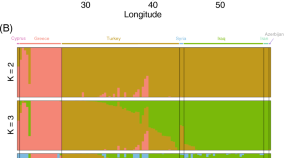
Discrepancy of flowering time between genetically close sublineages of Aegilops umbellulata Zhuk.
- Nozomi Kasazumi
- Kentaro Yoshida
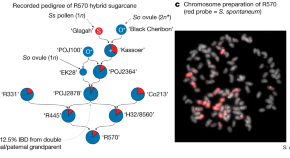
The complex polyploid genome architecture of sugarcane
We build a polyploid reference genome for hybrid sugarcane cultivar R570, improving on its current ‘mosaic monoploid’ representation, enabling fine-grain description of genome architecture and the exploration of candidate genes underlying the Bru1 brown rust resistance locus.
- A. L. Healey
- O. Garsmeur

An ARF gene mutation creates flint kernel architecture in dent maize
The mutation of ARFTF17 results in the development of flint kernel architecture in dent maize by reducing excessive pericarp length. This discovery holds significant potential for enhancing grain quality in elite, high-yielding dent maize hybrids.
- Haihai Wang
- Yongcai Huang

Heritable microbiome variation is correlated with source environment in locally adapted maize varieties
He et al. found that locally adapted maize varieties exert patterns of genetic control on their root and rhizosphere microbiomes that follow variation in their home environments, consistent with a role in tolerance to prevailing stress.
- Xiaoming He
- Danning Wang
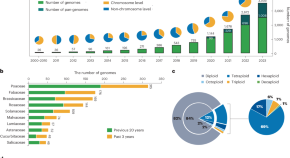
Technology-enabled great leap in deciphering plant genomes
This study collected and analysed 3,517 de novo assemblies from 1,575 plant species sequenced since 2000, including 793 newly sequenced species in the past three years. A database named N3: plants, genomes, technologies was developed to accommodate the metadata associated with the sequenced genomes.
- Lingjuan Xie
- Xiaojiao Gong
- Longjiang Fan
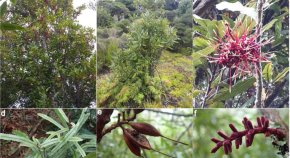
A population genomics analysis of the Aotearoa New Zealand endemic rewarewa tree ( Knightia excelsa )
- Ann M. McCartney
- David Chagné
News and Comment
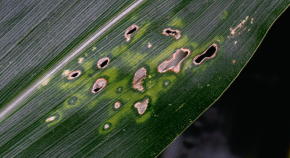
An immune module against gray leaf spot

The faces of JANUS
- Raphael Trösch
Refining the apple pan-genome
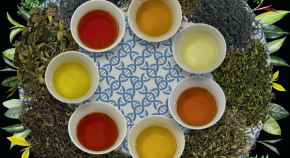
Teatime for pangenomics
A full pot of diversity is discovered in the tea pangenome.
- David Edwards
- Jacqueline Batley
Novel gene for herbicide resistance
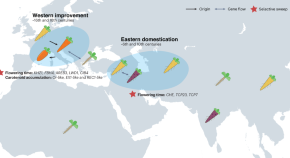
The changing colour of carrot
By assembling a high-quality carrot reference genome and resequencing 630 accessions, a study by Coe et al. reveals the transformative journey of carrot from wild progenitor to modern cultivar and the concomitant accumulation of carotenoids in its taproot.
Quick links
- Explore articles by subject
- Guide to authors
- Editorial policies
- Open access
- Published: 01 April 2024
Collision of herbal medicine and nanotechnology: a bibliometric analysis of herbal nanoparticles from 2004 to 2023
- Sinan Ai 1 , 2 na1 ,
- Yake Li 3 na1 ,
- Huijuan Zheng 4 ,
- Meiling Zhang 5 ,
- Jiayin Tao 4 ,
- Weijing Liu 4 ,
- Liang Peng 1 , 2 ,
- Zhen Wang 4 &
- Yaoxian Wang 6
Journal of Nanobiotechnology volume 22 , Article number: 140 ( 2024 ) Cite this article
Metrics details
Herbal nanoparticles are made from natural herbs/medicinal plants, their extracts, or a combination with other nanoparticle carriers. Compared to traditional herbs, herbal nanoparticles lead to improved bioavailability, enhanced stability, and reduced toxicity. Previous research indicates that herbal medicine nanomaterials are rapidly advancing and making significant progress; however, bibliometric analysis and knowledge mapping for herbal nanoparticles are currently lacking. We performed a bibliometric analysis by retrieving publications related to herbal nanoparticles from the Web of Science Core Collection (WoSCC) database spanning from 2004 to 2023. Data processing was performed using the R package Bibliometrix, VOSviewers, and CiteSpace.
In total, 1876 articles related to herbal nanoparticles were identified, originating from various countries, with China being the primary contributing country. The number of publications in this field increases annually. Beijing University of Chinese Medicine, Shanghai University of Traditional Chinese Medicine, and Saveetha University in India are prominent research institutions in this domain. The Journal “International Journal of Nanomedicine” has the highest number of publications. The number of authors of these publications reached 8234, with Yan Zhao, Yue Zhang, and Huihua Qu being the most prolific authors and Yan Zhao being the most frequently cited author. “Traditional Chinese medicine,” “drug delivery,” and “green synthesis” are the main research focal points. Themes such as “green synthesis,” “curcumin,” “wound healing,” “drug delivery,” and “carbon dots” may represent emerging research areas.
Conclusions
Our study findings assist in identifying the latest research frontiers and hot topics, providing valuable references for scholars investigating the role of nanotechnology in herbal medicine.
Graphical Abstract
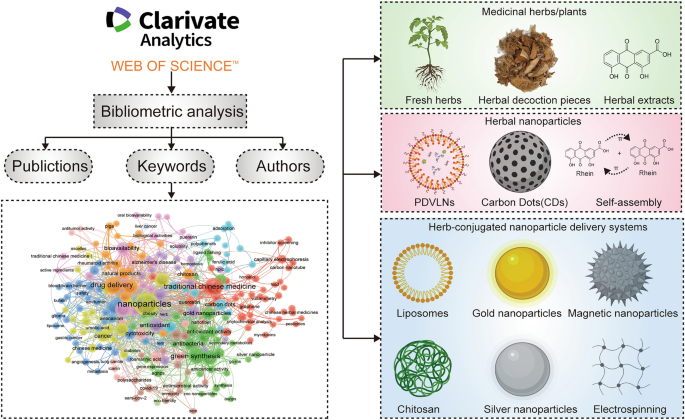
Nanomaterials refer to solid, liquid, or gaseous materials with nanoscale dimensions, typically 1–100 nm. They possess unique physical and chemical properties, including high surface area, quantum effects, and size effects. Nanomaterials have wide applicability in various fields, including electronics, materials science, and biology [ 1 ]. Particularly noteworthy is their significant potential in the field of medicine, offering novel approaches and methods for disease diagnosis and treatment [ 2 , 3 , 4 , 5 , 6 ]. For example, the high affinity of nanomaterials for specific biomolecules enables cancer biomarker detection [ 7 ]. Furthermore, nanomaterials can optimize the treatment methods, including photodynamic therapy (PDT) and photothermal therapy (PTT), which are promising cancer treatment methods involving light-induced cell death. Combining nanotechnology with PDT and PTT can enhance treatment efficacy, using laser-induced heating of gold nanoparticles for targeted cell death induction or utilizing photosensitizers in conjunction with graphene oxide nanoparticles for a more effective PDT [ 8 ]. One of the extensively researched areas is the nanodrug preparation, wherein nanomaterial properties are leveraged to create drug delivery systems with high drug payloads, low toxicity, and controllable release. These nanoparticles not only possess therapeutic properties of their own but also serve as carriers that can transport drugs by altering their surface properties and size to control the rate and mode of drug release [ 9 ].
Herbs, known as medicinal plants, constitute a vital component of traditional medicine with a long history of therapeutic use. Traditional herbal medicines continue to be highly regarded and used in modern times in China, Japan, South Korea, India and Arab countries; traditional Chinese medicine (TCM) in China, Japan and South Korea, Ayurveda in India, and aromatherapy in Arab countries are prominent examples [ 10 ]. In particular, traditional Chinese herbs, holds an important role in complementary therapies in China as their precise efficacy and low toxicity are widely acknowledged. Over a hundred TCM institutions use herbal medicine for treating patients. The therapeutic potential of traditional Chinese herbal medicine has gained recognition by the World Health Organization, which has initiated a program aimed at promoting and researching the safety, efficacy, and quality standards of Chinese herbal medicine, enabling more countries to completely harness the therapeutic potential of traditional Chinese herbal medicine [ 11 ]. An increasing body of scientific research confirms the various biological effects of herbal medicine, including antitumor, anti-inflammatory, and antimicrobial properties [ 12 , 13 , 14 ]. Furthermore, herbal extracts provide extensive avenues for developing new medications, with many plant-derived drugs already in use [ 15 ], including artemisinin, a compound extracted from sweet wormwood that is widely used to treat malaria, berberine to treat diarrhea, and paclitaxel as a cancer chemotherapy drug [ 16 , 17 , 18 ]. The chemical components of medicinal plants and their wide-ranging applications will give rise to the development of innovative products with fewer side effects than the existing medications. However, herbal medicine has several challenges such as limited administration routes, poor water solubility, low bioavailability, inadequate targeting, and high toxicity that prevent several drugs from entering clinical use. Recently, nanotechnology has been widely applied to address these therapeutic challenges because of its advantages that include high penetrability, strong targeting capabilities, and efficient controlled release. The two key applications of nanotechnology in the field of traditional herbal medicine are nanosizing and nanodelivery systems. For instance, drug nanosizing can enhance drug solubility and stability, thereby improving the drug’s therapeutic effectiveness and reducing toxicity [ 19 ]. Furthermore, herbal nano-delivery systems enable precise drug delivery and controlled release, enhancing the drug’s efficacy and minimizing side effects through synergistic interactions with carriers [ 20 ]. The amalgamation of nanotechnology with traditional herbal medicine is the outcome of the intersection of traditional medicine and modern technology. Traditional medicine boasts a rich history, and nanotechnology provides new vitality into traditional herbs. To date, we have achieved a series of breakthroughs and advancements in the field of herbal nanoparticle research. The present study aims to summarize the research hotspots and progress in the field of herbal nanoparticles over the past 20 years, gain a better understanding of the role of nanotechnology in TCM, contribute to the modernization of TCM, and promote nanomedicine development in clinical applications.
Over the 20 years, substantial evidence has confirmed the critical role of nanotechnology in research and development of traditional herbs; several recent review articles have delved into various aspects of this theory [ 21 , 22 , 23 , 24 , 25 , 26 , 27 ]. However, a comprehensive analysis regarding the current state and future directions is currently lacking. Moreover, there is no objective description to highlight the research focal points in this field. Bibliometrics, introduced by Alan Pritchard in 1969, is a statistical method for analyzing literature information and identifying developmental trends as well as research hotspots in specific fields [ 28 ]. This method has been widely utilized in various disciplines, including medical research [ 29 , 30 , 31 , 32 , 33 ]. A bibliometric analysis of publications, countries, institutions, journals, authors, and keywords would enable a comprehensive understanding of the developmental process in the research field. Furthermore, for determining the foundations, frontiers, and highlights of this field, author keywords would be used to perform keyword co-occurrence analysis. To the best of our knowledge, bibliometric studies on the association between nanomedicine and coronary heart disease as well as breast, gastric, and colon cancers have already been conducted [ 34 , 35 , 36 , 37 , 38 ]. Although bibliometrics has not been applied to the study of nanotechnology and traditional herbs yet, the role of nanotechnology in traditional herbal medicine is indeed a shining gem in current research. Therefore, to fill this knowledge gap, the present study aimed to objectively reveal the current status and future directions of nanotechnology in traditional herbs via a bibliometric analysis; identify major contributors, institutions, countries, and current research focal points; review current research hotspots; and anticipate research trends and future prospects in this field.
Data source and search strategy
We conducted an extensive search and analysis using the Web of Science Core Collection (WoSCC) database, covering English-language literature from 2004 to 2023 (up to December 31, 2023). Bibliometric analysis is generally performed using the WoSCC and Scopus databases; we selected WoSCC because its covers several renowned and influential journals, which are favored by academic researchers [ 37 , 39 ]. We employed the following search term combinations: [TS = (“Nanoparticles” OR “Nanocapsules” OR “Nanoconjugates” OR “Nanogels” OR “Nanospheres” OR “Nanotubes, Carbon” OR “Nanopores” OR “Nanotubes” OR “Nanowires” OR “nanomedicine” OR “Nanostructure” OR “Nanostructured Materials” OR “Nanomaterial” OR “Nanocomposites” OR “Nanogels” OR “Nanofibers” OR “carbon dots” OR “carbon quantum dots” OR “nanodots” OR “nano dots” OR “carbon nanodots” OR “polymeric dots” OR “Graphene Quantum Dots”) AND TS = (“Herb” OR “Traditional Chinese Medicine” OR “Medicinal Plants” OR “Herbal Medicine” OR “Chinese Plant Extracts” OR “Herb Extracts” OR “Herbal Compounds” OR “Plant Compounds” OR “Phytochemicals”)] to retrieve all relevant records. Articles using a search period from 2004 to 2023 were selected for this study; this was considered a sufficient timeframe to reflect the current research status in the field as there was little to no literature on herbal nanomaterial formulations before 2004. All relevant literature concerning herbal nanoparticles was exported in TXT format as “Full Records and References.” Subsequently, it was imported into the R package bibliometrix, VOSviewer, and CiteSpace for a comprehensive bibliometric analysis. The workflow diagram is illustrated in Fig. 1 .
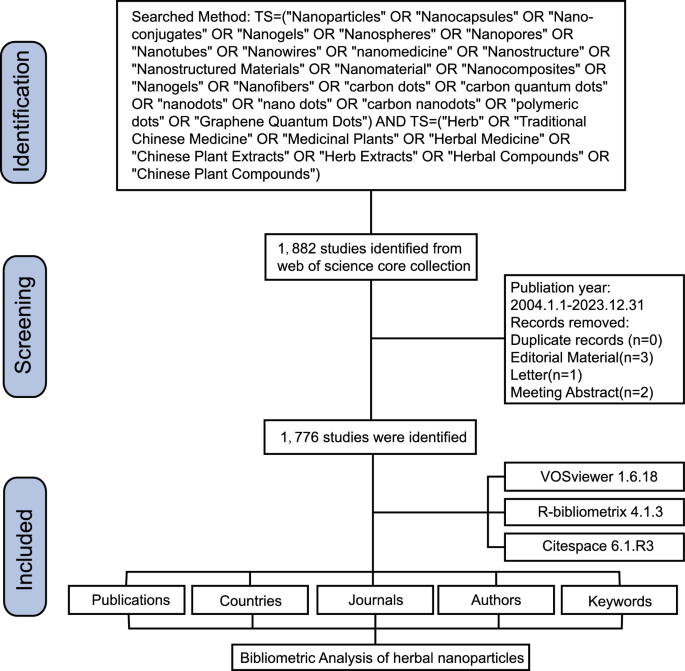
Flowchart of the literature screening process
Data analysis
We used the bibliometric tools such as Bibliometrix R package, VOSviewer, and CiteSpace to visualize the results of our bibliographic analysis. To enhance the presentation of our research outcomes, we carefully selected suitable software for examining various facets of our study. In this investigation, we utilized R (version 4.1.2), R-bibliometrix package (version 3.0.3, http://www.bibliometrix.org ), CiteSpace (version 6.1. R2), and VOSviewer software (version 1.6.18) to visualize our selected literature [ 36 , 37 , 39 ]. By leveraging these tools, we performed an indepth analysis of publications, countries, institutions, journals, authors, and keywords. Using the R-bibliometrix package, we performed frequency statistics for authors, journals, institutions, and countries, which included publication and citation counts. For each category, the top 20 frequencies were displayed. Furthermore, we created a word cloud of the top 50 author keywords in R-bibliometrix, wherein the word size represented their frequency. For the remaining software parameters, the default settings were used. During the execution of R-bibliometrix, we used Biblioshiny that serves as a user-friendly web interface for R-bibliometrix and facilitates the visual display of data analysis and social network graphs [ 40 ]. We used the powerful R package ggplot2 (version 3.4.2) to enhance the visual representation of our research findings further. Moreover, we used VOSviewer software (version 1.6.16, https://www.VOSviewer.com ), developed by Nees Jan van Eck and Ludo Waltman at Leiden University [ 41 ], to generate co-authorship, country, institution, and keyword co-occurrence networks, with node size indicating the frequency of appearance or citation and connecting line thickness reflecting collaboration strength. For the keyword co-occurrence network, we set the minimum frequency of appearance to 10 for authors, institutions, journals, and keywords. For countries, the minimum appearance frequency was set at 5, and for article citation counts, the minimum frequency was set to 100. Furthermore, we used CiteSpace, a widely used bibliometric analysis and visualization software developed by Professor Chaomei Chen [ 42 ] to facilitate keyword cluster analysis and keyword cluster timeline visualization. We pruned slice networks and merged them using Pathfinder and performed keyword K-means clustering analysis using a G-index value of k = 10.
Number of publications and citation evolution
In total, we included 1876 publications from the WoSCC database that comprised 1512 articles and 364 reviews. We depicted a line chart illustrating the evolution of the number of publications related to herbal nanoparticles from 2004 to 2023 (Fig. 2 A). The entire period was divided into the following three phases based on the annual publication growth rate: first phase (2004–2008), marked a period of stability; second phase (2009–2016), experienced slow growth; and third phase (2017–2023), witnessed rapid growth.
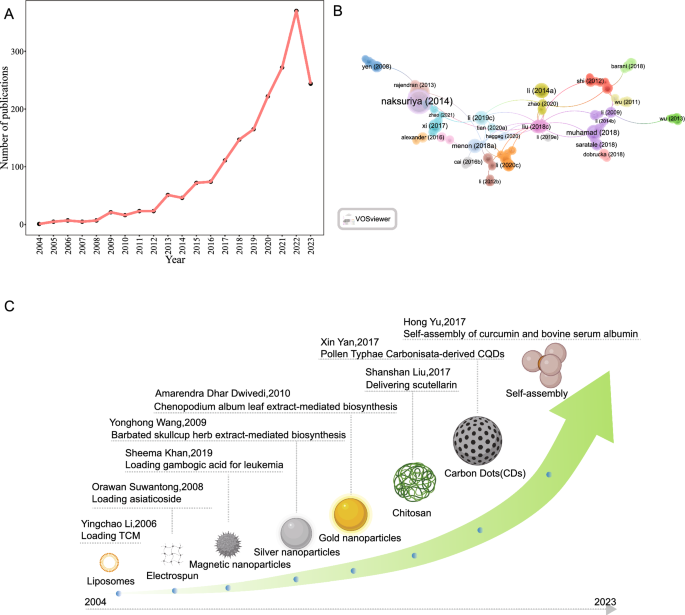
Analysis of all publications. A Trends in annual publications. B Co-citation network analysis of publications. C Chronological timeline of key articles in herbal nanoparticle research
According to VOSviewer’s co-citation network analysis (Fig. 2 B), the most cited article in the WoSCC database was authored by Eileen White. This article, titled “Curcumin nanoformulations: a review of pharmaceutical properties and preclinical studies and clinical data related to cancer treatment” [ 43 ] was published in the Biomaterials journal (IF = 14.0) in 2014 and accumulated a total of 630 citations. The second most cited article was “Nanotechnology-based drug delivery systems and herbal medicines: a review” [ 20 ] by Bonifacio that was published in the International Journal of Nanomedicine (IF = 8.0) in 2014. By systematically assessing the citation counts of articles, we selected a series of pivotal papers that reported the applications of specific nanotechnologies in traditional herbal medicine at an early stage [ 44 , 45 , 46 , 47 , 48 , 49 , 50 , 51 ]. Subsequently, we constructed a chronological timeline, highlighting some milestone studies in a sequential manner (Fig. 2 C).
Core journals analysis
Figure 3 A shows the top 20 journals that published articles related to herbal nanoparticles from 2000 to 2022; these journals collectively published 1157 articles, accounting for 25.27% of the total publications. Among them, the International Journal of Nanomedicine , with an impact factor of 8.0 and a Journal Citation Reports Q1 ranking, published 61 relevant papers, contributing to 3.24% of all publications. The H-index is an indicator used to assess the journals’ quantity and impact [ 52 , 53 ]. Figure 3 B shows that the International Journal of Nanomedicine (H-index = 27) and Talanta (H-index = 16) are the two most influential journals based on their H-index. Furthermore, the journal co-citation network based on VOSviewer visualization (Fig. 3 C) suggested that the three key journals with the highest total link strength were the International Journal of Nanomedicine , Molecules , and Journal of Pharmaceutical and Biomedical Analysis . Figure 3 D shows that the growth trends of the five major journals indicate that the International Journal of Nanomedicine has consistently been a popular journal in this field.
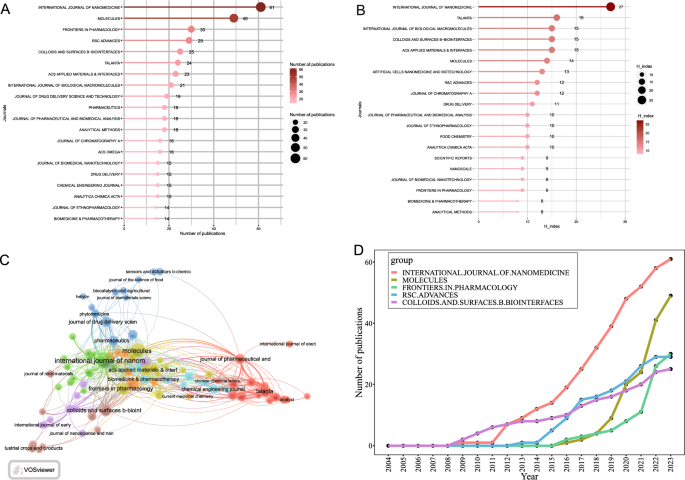
The most productive and influential journals in research on the herbal nanoparticles. A The top 20 most productive journals contributing to research. B The top 20 journals ranked by H-index. C The publication trends in the top 5 journals over time. D Co-citation network analysis of journals
Analysis of countries and institutions
Figure 4 A, B illustrate the number of articles published and the collaboration network among 87 countries conducting research on herbal nanoparticles. In terms of productivity, China leads with 3051 articles, followed by India (737 articles), Iran (442 articles), United States (203 articles), and Saudi Arabia (166 articles). Regarding their respective citation counts, China stands out as a prominent contributor in this research field, with a total citation count of 20,578, surpassing other countries such as India (10,506 citations), Iran (5296 citations), and South Korea (1278 citations). These countries have rich herbal usage traditions. China, especially, traces its herbal usage, which continues to the present day, back over 2000 years. Figure 5 C, D , using VOSviewer and R-bibliometrix, illustrate the collaborative relationships among the leading countries, primarily demonstrating close collaborations and exchanges between China, India, and the United States. Among the 36 countries involved in international collaborations with a minimum of 5 articles, China has the highest number of collaborations with other countries (227), followed by India (167) and the United States (146).
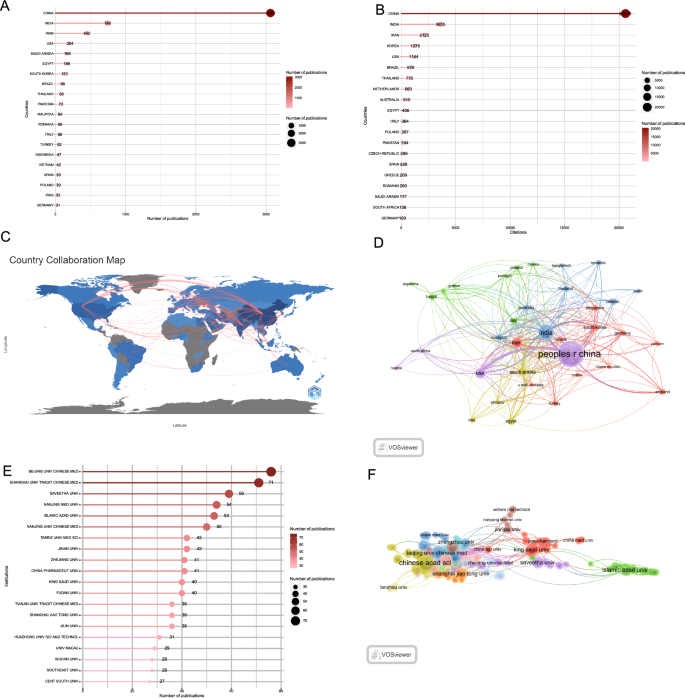
Contribution and collaboration among countries and institutions. A The top 20 most productive countries. B The top 20 most cited countries. C contribution and collaboration among countries. D Collaboration map with a minimum number of documents of a country of > 10 publications based on collaboration among countries. E The top 20 most productive institutions. F Collaboration map with a minimum number of documents of a country of > 5 publications based on collaboration among institutions

Authors’ contribution and collaboration. A The top 20 most productive authors. B The top 20 author’s production over time. C Authors’ collaboration network. D Co-citation network of authors
These published articles originate from 2258 global institutions. Figure 5 E lists the top 20 high-productivity institutions in herbal nanoparticle research, with 16 of them being located in China. The remaining four institutions include Saveetha University in India, Islamic Azad University in Iran, Tabriz University of Medical Sciences in the United States, and King Saud University in Saudi Arabia. The China Academy of Chinese Medical Sciences has the highest number of published articles (76) followed by Shanghai University of Traditional Chinese Medicine (71 articles), Saveetha University (59 articles), and Nanjing Medical University (54 articles). The collaboration network in Fig. 5 F highlights the most influential institutions, including the Chinese Academy of Sciences (71 links), China Pharmaceutical University (39 links), and Fudan University (37 links).
Author contributions
In total, 8234 authors contributed to the literature on herbal nanoparticles, with an average of 4.38 authors/article. The top 20 most prolific authors collectively contributed to 196 articles, accounting for 22.27% of all published work (Fig. 5 A). Among these authors, Yan Zhao from Beijing University of Chinese Medicine stands out as the most prolific, contributing 19 articles in this field, followed closely by Yue Zhang (16 articles) and Huihua Qu (16 articles) from the same research team. Figure 5 B illustrates the high productivity of the top 20 authors, indicating their regular publication patterns and demonstrating their strong commitment to this research area. To identify the key authors and study collaboration patterns, we used VOSviewer to create a collaboration network (Fig. 5 C). For clarity, the collaboration network focuses on displaying collaborations among 116 authors who were involved in a minimum of 5 articles. The network illustrates close collaborations among the authors, each with a centrality of < 0.1. Within the collaboration network, Yan Zhao demonstrates the most significant collaborative relationships, with a link strength of 67. Subsequently, Huihua Qu (65) and Yue Zhang (65) also emerge as notable collaborators in the network. A co-citation network analysis described the collaborative relationships among 80 authors involved in at least 5 articles (Fig. 5 D). The co-citation analysis further underscores Yan Zhao, Huihua Qu, and Yue Zhang as the top three authors in this context.
Keyword and hotspot analysis
A comprehensive keyword analysis on the selected 1876 articles related to herbal nanoparticles was performed using “Author Keywords” from the Biblioshiny application and “Keywords Plus” provided by the Thomson Reuters editorial team. In total, 5134 keywords were identified. However, upon comparing the results from these two sources, “Author Keywords” was observed to provide more accurate results, making it the primary data source for the analysis. The frequency of each keyword was visually represented using a word cloud, as shown in Fig. 6 A. The term “nanoparticles” had the highest frequency, mentioned 151 times, followed by “traditional Chinese medicine” (82 times) and “drug delivery” (80 times). Notably, high-frequency keywords that have emerged in recent years are displayed in Fig. 6 B. Figure 6 C shows the keyword cluster timeline visualization, highlighting the recent research hotspots, including TCM, green synthesis, nanoparticles, curcumin, wound healing, drug delivery, and carbon dots (CDs). We conducted a keyword analysis on the selected 1876 articles using VOSviewer and CiteSpace software. To examine the association among keywords and identify prevalent topics, we performed a co-occurrence analysis. Using CiteSpace, we categorized these keyword clusters into 11 categories, including TCM, green synthesis, nanoparticles, curcumin, wound healing, antioxidants, drug delivery, essential oil, apoptosis, antibacterial, magnetic nanoparticles, and CDs (Fig. 7 A). Similarly, using VOSviewer, we selected the top 205 keywords that appeared at least 10 times, constructed a co-occurrence network (Fig. 7 B), and identified clusters represented by different colors, including red, green, blue, and yellow. The nodes of the same color within a cluster represent closely related co-occurrences, with node size and link width varying based on the degree and strength of co-occurrence. “Betweenness centrality” is used to measure the importance of nodes in the network, with larger nodes and higher total link strength indicating more informative contributions. The two largest nodes with the highest total link strength were “nanoparticles” and “traditional Chinese medicine” within the yellow cluster. The top 20 keywords include nanoparticles, TCM, drug delivery, green synthesis, silver nanoparticles, nanotechnology, curcumin, apoptosis, antioxidants, herbal medicine, nanomedicine, nanoparticles, bioavailability, gold nanoparticles, cancer, CDs, wound healing, antimicrobial, and plant compounds. Additional file 2 : Table S1 provides specific information for each cluster of keywords.
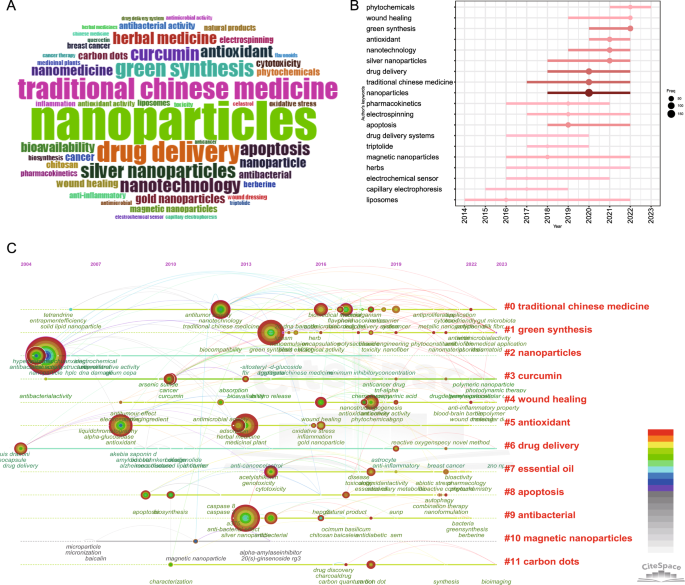
Analysis of topic trends. A Word cloud based on author’s keyword. B The keyword cluster timeline. C Trend topics based on author’s keywords over time
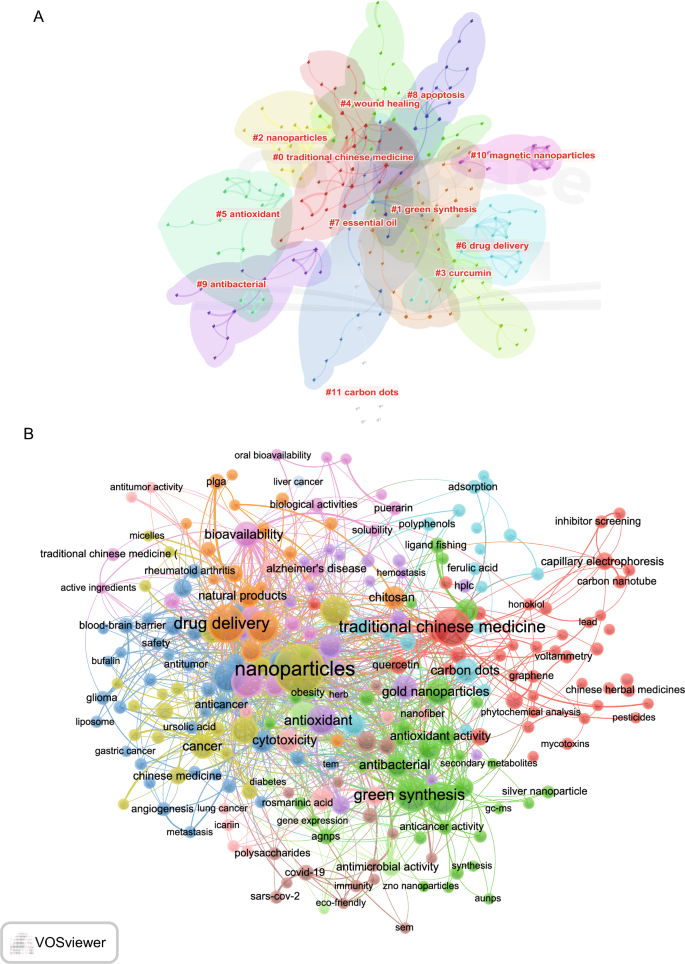
Keywords cluster analysis. A Keywords cluster analysis conducted using CiteSpace. B Co-occurrence visualization network of keywords
Recently, with the advancement of science and technology, the importance of nanomaterials in the field of medicine has garnered increasing interest, positioning it as a significant focal point in research. Furthermore, traditional herbal medicine, with the assistance of nanotechnology, has piqued the curiosity of more researchers. This is the first study that has attempted to use bibliometric analysis methods for investigating publications related to herbal nanoparticles. We utilized R software, VOSviewer, and CiteSpace to conduct a bibliometric visual analysis of 1876 herbal nanoparticle related documents extracted from the WoSCC database. The results of this study provide a comprehensive understanding of the research trends in herbal nanoparticles from 2004 to 2023. Based on publication output trends, since 2010, the number of articles related to herbal nanoparticles has steadily increased, with explosive growth occurring since 2016. This may be attributed to the publication of key articles that have driven interest in this field. An analysis of journal publications revealed considerable enthusiasm among international journals, especially in specialized journals such as the International Journal of Nanomedicine , for exploring the functionality of herbal nanoparticles. This indirectly reflects the strong interest of prestigious journals in this research direction. China has emerged as a major research powerhouse in this field, leading in research output [ 54 , 55 ]. This can be attributed to China’s rich traditional use of herbal medicine that dates back centuries [ 56 ]. Moreover, the Chinese government has been increasing its financial support for studies related to herbal nanoparticles. Chinese researchers have published a substantial volume of research papers on herbal nanoparticles in domestic and renowned international journals, highlighting the vibrant development of this field [ 21 ]. Consequently, China’s research output and influence in this area have been increasing. Furthermore, India, as one of the earliest nations to use herbal medicine and with its traditional Ayurvedic medicine system centered around herbal usage [ 57 ]. Similarly, we can observe the utilization of plant extracts for medical purposes in regions such as the Arab countries because of their use in aromatherapy [ 58 ]. China’s neighboring countries, such as Japan and South Korea, engage in cultural exchanges related to TCM, contributing to their leading positions in research on herbal nanoparticles [ 59 , 60 ]. Furthermore, extensive collaborations have been established between China, India, and the United States. Although the United States has published fewer articles as compared to China and India, it engages in more collaborations between these two countries. The advanced facilities in the United States promote research and development in the field of herbal nanoparticles via these collaborations. Currently, international co-operation in this field remains in its nascent stage and should be expanded further to promote the global dissemination of herbal nanoparticle research.
Based on the results of the author’s analysis, Yan Zhao emerges as the most prolific researcher who actively collaborates with several other researchers. Yue Zhang and Huihua Qu, who rank second and third, respectively, belong to the light blue region of the author collaboration network and are part of the same team at Beijing University of Chinese Medicine. They have conducted extensive research on the biological activities of CDs from TCM. Their work has uncovered applications of these CDs in various biological functions, including hemostasis, anti-inflammatory properties, and hepatoprotection [ 61 , 62 , 63 , 64 ]. Researchers in the yellow region, including Penglong Wang, Haimin Lei, and Xuemei Huang, have focused on the self-assembly structures and supramolecular nanostructures of natural medicines [ 65 , 66 ]. In the brown region, Professor Daquan Chen and his team from Yantai University primarily conducted studies on targeted nanodelivery systems for TCM and their extracts [ 67 , 68 , 69 ]. They explored various systems, including plant-derived exosome-like vesicles, macrophage membrane biomimetic nanoparticles, and nanomicelles, for delivering natural bioactive products. In the red portion, Professor Gang Chen from Guangdong Pharmaceutical University investigated the green synthesis of silver nanoparticles using TCM and achieved nanodelivery of TCM [ 70 ]. Based on the current keyword analysis, the research hotspots in the field of herbal nanoparticles primarily encompass several aspects of nanoparticle synthesis methods, types, and herbal compounds. We categorized the keyword hotspots into the following five aspects: natural herbal nanoparticles, CDs, self-assembled herbal nanoparticles, herbal nanoparticle delivery systems, and herbal compounds. We reviewed the research focus areas for each category. Figures 8 and 9 summarize natural herbal nanoparticles, CDs, and self-assembled herbal nanoparticles. Figure 10 provides a comprehensive overview of the focal points of herbal nanoparticle delivery systems. Finally, Table 1 presents research information on the top 10 herbal compounds related to nanoparticles [ 71 , 72 , 73 , 74 , 75 , 76 , 77 , 78 , 79 , 80 , 81 , 82 , 83 , 84 , 85 , 86 , 87 , 88 , 89 , 90 , 91 , 92 , 93 , 94 , 95 , 96 , 97 , 98 , 99 , 100 , 101 , 102 , 103 , 104 , 105 , 106 , 107 , 108 , 109 , 110 , 111 , 112 , 113 , 114 , 115 , 116 , 117 , 118 , 119 , 120 , 121 , 122 , 123 , 124 , 125 , 126 , 127 , 128 , 129 , 130 , 131 , 132 , 133 , 134 , 135 , 136 , 137 , 138 , 139 , 140 , 141 , 142 , 143 , 144 , 145 , 146 , 147 , 148 , 149 ]. We hope our data will provide valuable insights into the most promising hotspots in herbal nanoparticles.
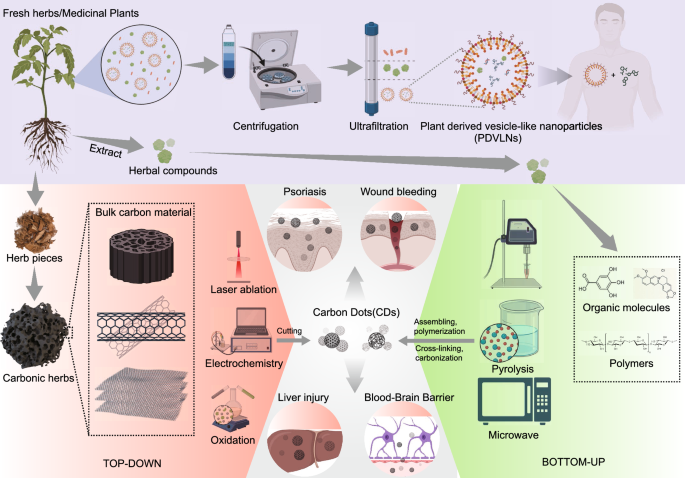
Natural herbal nanoparticles and carbon dots
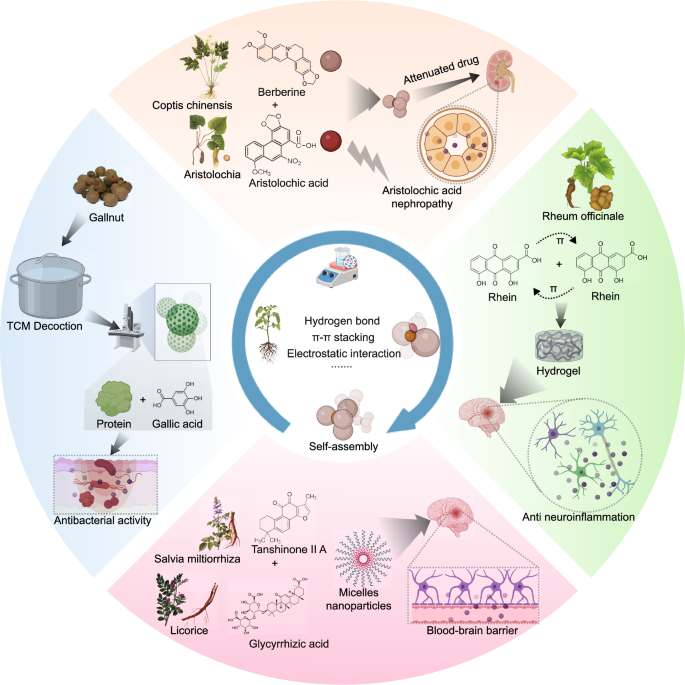
Self-assembled herbal nanoparticles
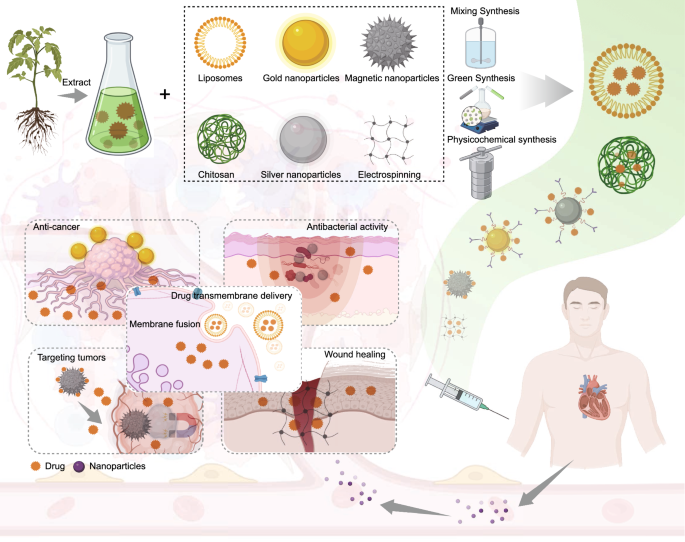
Herbal nanoparticle delivery systems
Natural herbal nanoparticles.
Plant-derived vesicle-like nanoparticles (PDVLNs) are natural nanoparticles produced by plants [ 150 ]. Similar to the structure of animal exosomes, certain vesicle-like structures secreted by plants are nanoscale biological particles encapsulated within a phospholipid bilayer. They contain lipids, proteins, nucleic acids, and small molecules. These components have the ability to be transferred to recipient cells, thereby regulating intercellular communication. Even before research on mammalian-derived exosomes, plants could generate extracellular vesicles. However, progress in research on this topic has been slow. Early research predominantly focused on the functions of extracellular vesicles within plants, overlooking the potential for these nanoscale vesicles to transfer various bioactive substances among different organisms. In a previous review article, Zheng Lei proposed defining vesicle-like nanostructures isolated from plants as PDVLNs. PDVLNs have garnered considerable attention owing to their exceptional bioavailability, stability, and bioactivity. They hold promising therapeutic value and have become a central focus of interdisciplinary scientific research. The methods for preparing PDVLNs primarily include tissue disruption and tissue infiltration centrifugation methods. Further purification of PDVLNs can be achieved via density gradient ultracentrifugation, ultrafiltration, immunoprecipitation, and other techniques [ 150 ]. For example, previous research has demonstrated that garlic chive-derived vesicle-like nanoparticles extracted from garlic and Chinese chives, along with their active component phospholipid 1, 2-dilinoleoyl-sn-glycero-3-phosphocholine, exhibit the capability to inhibit NOD-like receptor thermal protein domain associated protein 3 inflammasome activation, thereby improving the metabolic health of diet-induced obese mice [ 151 ]. Modern medicine has confirmed that lemon water can effectively intervene in the occurrence and development of kidney stones. Zhang et al. successfully extracted lemon-derived extracellular vesicles (LEVNs) via density gradient centrifugation. They confirmed that LEVNs are delivered intact to the kidneys by natural oral administration. LEVNs restore calcium homeostasis and alter calcium oxalate crystal formation, thus helping mitigate stone aggregation and formation [ 151 ]. Another previous study extracted and purified exosomes from Taraxacum officinale through ultracentrifugation. T. officinale -derived exosomes alleviated intestinal tissue inflammation and minimized intestinal tissue damage, thereby significantly reducing high blood pressure in a rat model [ 152 ]. Although research on PDVLNs is currently limited, they hold the potential to become a major focus of future investigations.
Carbon dots
CDs are carbon-based nanoparticles with sizes < 10 nm, featuring a variety of functional groups on their surfaces. They can be applied in various fields, including biomedicine and energy. In a comprehensive review published in Nature Nanotechnology , Luka Ðorđević and colleagues provide a systematic overview of how CD properties can be tailored for diverse applications via different chemical strategies and synthesis methods [ 153 ]. When TCM are subjected to high-temperature carbonization, they produce “traditional Chinese medicine carbonaceous nanoparticles” with particle sizes of < 10 nm, also known as “traditional Chinese medicine-derived carbon quantum dots.” These represent a novel class of carbon-based nanomaterials. These carbon quantum dots can be sourced from various TCM formulations, including Xueyu, Puhuang, and Baizhu charcoal, which typically have hemostasis, antidiarrheal, and astringent effects following their preparation. Currently, the preparation of TCM CDs primarily involves the following two approaches: “top–down” method, which uses physical or chemical means to isolate carbon materials; and “bottom–up” approach, which involves the polymerization or carbonization of small organic molecules [ 153 ]. Furthermore, TCM CDs retain the inherent pharmacological activities of medicinal materials while exhibiting biocompatibility, optical characteristics, and high stability. Weikang Luo and his team led the development of nontoxic, functional nanoCDs derived from inexpensive ingredients, such as peach kernels and safflower. These nanoCDs have been reported to penetrate the blood–brain barrier more easily in mice with traumatic brain injury, promoting neural function recovery, reducing brain edema, and minimizing neuronal damage [ 154 ]. Another study discovered that Lycium barbarum CDs can inhibit aging by modulating the m6A modification of Clip3, thereby alleviating radiation-induced bone damage [ 155 ]. A research team at the Beijing University of Chinese Medicine performed a series of investigations on TCM CDs using various medicinal plants, such as Puhuang charcoal, Longgu (fossilized bone), Gegen (Pueraria), Baishao (peony root), and Huangbapipi (Cortex Phellodendri), for a range of applications, including hemostasis, anxiety reduction, hyperuricemia management, hepatoprotection, and psoriasis treatment [ 61 , 62 , 63 , 64 , 156 ]. In summary, TCM CDs represent a promising new class of nanomedicines with various potential applications.
Self-assembly is a molecular-level phenomenon, wherein disordered molecular structures spontaneously arrange into ordered structures via noncovalent forces, including hydrogen bonds, van der Waals forces, and π–π, electrostatic, hydrophobic, and co-ordination interactions. In the process of decocting TCMs, self-assembly phenomena are widely observed, resulting in the formation of several nanoscale particles. For example, Han Bo reported the presence of spherical nanoparticles in gallnut decoction. These nanoparticles were formed via the self-assembly of gallic acid compounds and gallnut larval proteins [ 157 ]. Furthermore, TCM mixtures of Qingxue Chushi decoction contain drug delivery systems based on liquorice proteins. These systems can combine with compounds, including baicalin, paeoniflorin, and glycyrrhizic acid, to form nanoparticles, helping in the improving the skin conditions in a psoriasis mouse model [ 123 ]. Moreover, researchers have extracted extracellular vesicle nanoparticles from the TCM Jianpi Jiedu Recipe decoction. These nanoparticles were found to influence fibroblast activation, thereby inhibiting the growth and metastasis of colon cancer [ 158 ]. Furthermore, boiled liquorice proteins can self-assemble into nanoparticles, which have a potential for in vivo drug delivery for various medications. By encapsulating astragaloside IV in licorice protein nanoparticles, the solubility of astragaloside IV can be significantly improved [ 159 ]. The self-assembly phenomena in TCM decoction processes have driven researchers to develop a range of strategies for synthesizing nanoscale particles from the small molecules of TCM. For example, Professor Lei Haimin from Beijing University of Chinese Medicine has proposed a strategy for heteroline supramolecular self-assembly based on berberine. This strategy revealed that effective components of flavonoids in coptis detoxification decoction can self-assemble with berberine to form supramolecular structures. This alteration affects their inhibitory effects on Staphylococcus aureus and their ability to remove biofilms [ 66 ]. Furthermore, the self-assembly of aristolochic acid and berberine forms a linear heterogeneous supramolecule, which can reduce the acute nephrotoxicity of aristolochic acid, providing a new strategy for addressing toxicity issues in TCMs containing aristolochic acid [ 160 ]. Moreover, researchers have designed a biomimetic nanodelivery system that utilizes tanshinone IIA and glycyrrhetinic acid to self-assemble into nanomicelles, effectively accumulating drugs into the glioblastoma lesions [ 161 ]. Zheng had observed that rhein self-assembles into supramolecular hydrogels through intermolecular π–π interactions and hydrogen bonds. Compared to free drugs, these hydrogels more readily enter cells, subsequently achieving anti-neuroinflammatory therapy by inhibiting the Toll-like receptor 4/nuclear factor-κB signaling pathway [ 162 ]. In another study, salvianolic acid B and NapFFKYp could form a spontaneous hydrogel that promoted wound healing [ 163 ].
Herbal nanoparticle delivery systems are a significant focus in the field of herbal nanoparticles. Keyword analysis indicates that the primary delivery carriers currently employed include gold nanoparticles, silver nanoparticles, magnetic nanoparticles, electrospinning, liposomes, and chitosan. Nanoencapsulation strategies involve enclosing the active ingredients of herbal medicines within nanoscale carriers to enhance their solubility, stability, and bioavailability, which in turn improves the therapeutic efficacy while reducing the potential side effects. Common encapsulation strategies include liposomes and chitosan. Liposomes, as a carrier system, have long been used in herbal nanodelivery. A previous study demonstrated that liposome encapsulation significantly enhanced berberine’s solubility in a buffer solution and helped maintain the ejection fraction following myocardial infarction. This suggests that employing liposome encapsulation significantly increases its therapeutic availability, indicating liposome encapsulation as a promising approach [ 164 ]. Recently, chitosan encapsulation has gained increasing attention in herbal nanodelivery research. Chitosan, a semisynthetic polysaccharide derived from chitin, has gained prominence as an ideal pharmaceutical carrier material because of its excellent biodegradability, biocompatibility, lack of immunogenicity, nonirritating nature, nonthermal properties, and nontoxicity. In this research trend, Nayeresadat Hasheminejad successfully prepared chitosan nanoparticles using an emulsion-ion gelation method to encapsulate clove essential oil. This strategy effectively enhanced the antimicrobial effects of clove essential oil, and in vitro release studies revealed precise drug release over 56 days [ 165 ]. In another study, Lazer et al. covalently bound folic acid to chitosan molecules, which resulted in the synthesis of chitosan–folic acid–quercetin nanoparticles. These nanoparticles exhibited anticancer effects on colon cancer by regulating the expression of pro-apoptotic genes, inhibiting tumor colony formation, and inducing cell apoptosis [ 166 ]. Apart from the therapeutic actions of herbal compounds, certain herbal ingredients served as targeted delivery agents. In this system, glycyrrhetinic acid-modified chitosan served as a carrier for the chemotherapy drug doxorubicin and was loaded into a metal–organic framework. The liver-targeting ligand glycyrrhetinic acid specifically bound to glycyrrhetinic acid receptors overexpressed on liver cancer cell membrane, providing an active targeting effect for the delivery system [ 167 ].
Furthermore, gold and silver nanoparticles have been used for herbal delivery, wherein drug molecules are loaded onto the surface of these nanoparticles via covalent and noncovalent interactions. However, their safety has been a subject of debate. Gold nanoparticles are widely used in cancer therapy, achieving multitarget treatment of tumors when combined with herbal medicines. In one study, curcumin and gold nanoparticles were used for treating cancer. These nanoparticles entered the body and bound to specific areas. By irradiating this region with lasers, gold nanoparticles were activated to generate heat, thereby destroying the cancer cells. Simultaneously, curcumin attached to the gold nanoparticles was released inside the body, seeking out other cancer treatment targets [ 168 ]. Silver surfaces possess antibacterial properties, and silver nanoparticles have significantly increased antibacterial efficacy because of their enlarged surface area. In this research, aqueous Siberian ginseng extracts were used to prepare the stock solutions of silver nanoparticles. Liquid chromatography‒mass spectrometry revealed the presence of substances, such as eleutheroside A and eleutheroside E, in the silver nanoparticles. These green-synthesized silver nanoparticles exhibited enhanced antibacterial activity against various bacteria [ 169 ].
Furthermore, nanoparticles with unique properties, including magnetic nanoparticles and electrospun nanofibers, have been utilized for nanodelivery. For example, Fe 3 O 4 magnetic nanoparticles exhibit superparamagnetism that enables precise control by external magnetic fields and achieves targeted drug delivery to cancer cells. Moreover, under an alternating magnetic field, these magnetic nanoparticles can generate localized heat, holding potential applications, such as hyperthermia treatment in tumor tissues. For example, Khan et al. developed a formulation of curcumin prepared using superparamagnetic iron oxide nanoparticles as a nontoxic biologically active anti-inflammatory/anticancer agent. This formulation successfully improved the delivery efficiency of curcumin, especially for pancreatic tumors [ 170 ]. In another study conducted by Kaiping Wang, the anticancer drug paclitaxel and Fe 3 O 4 magnetic material were co-encapsulated within the polylactic acid-glycolic acid copolymer nanoparticles. These coloaded drug nanoparticles induced apoptosis of A549 cells by disrupting lysosomes and activating the mitochondrial pathways, demonstrating a high anticancer activity [ 171 ]. Electrospinning technology is a method for preparing porous and spatially interconnected nanofibers. During this process, electrospinning involves the ejection and spinning of a charged polymer solution, forming nanofibers with diameters in the nanoscale range on a receiving device. The resulting nanofibers exhibit high porosity, large surface area, uniformity, and ability to mimic the extracellular matrix, making them suitable in tissue engineering, wound dressings, drug carriers, and other biopharmaceutical fields. This technology can be used for the production of nanofibers using effective traditional Chinese herbal materials, offering potential for the development of new wound healing materials and further leveraging the role of TCM in the promotion of wound healing and tissue repair. One study designed a “sandwich-like” structured electrospun nanofiber wound dressing for diabetes. It involved a hydrophilic polyvinyl alcohol inner layer loaded with metformin hydrochloride to facilitate diabetic wound healing. The middle layer, a composite membrane dressing, demonstrated excellent mechanical properties resembling human skin’s tensile performance. The hydrophobic polylactic acid outer layer contained erythromycin and puerarin, which demonstrated significant antibacterial properties [ 172 ]. These features make the diabetes wound dressing promising for medical applications.
Nanoparticles associated with herbal small molecule compounds
Herbal small molecule compounds play a vital role in traditional medicine and are widely employed globally, including glycosides [ 173 ], flavonoids [ 174 ], Terpenoids [ 175 ], phenylpropanoids [ 176 ], alkaloids [ 177 ], and phenols [ 178 ]. Furthermore, these herbal extracts are considered essential sources for new drug development because of their diverse compounds with unique structures and considerable biological activities [ 17 , 179 ]. Unfortunately, several purified compounds from these herbal extracts face limited absorption upon oral administration, imposing severe restrictions on their clinical applications [ 180 , 181 ]. Through a bibliometric analysis, some notable Chinese herbal compounds were identified in the field of nanoparticles, including curcumin, berberine, resveratrol, quercetin, celastrol and others.
Curcumin, a compound derived from the Chinese herb turmeric, possesses a range of biological effects, including anti-inflammatory, anti-oxidant, and anti-cancer activities. However, curcumin has limited water solubility and chemical instability, leading to restricted bioavailability. Nanoparticle preparation represents an effective strategy for enhancing the solubility and bioavailability of curcumin. Strategies based on turmeric nanovesicles use nanovesicles extracted from fresh turmeric, with mass spectrometry identifying curcumin as a major component. The oral administration of turmeric nanovesicles exerts anti-inflammatory effects via mechanisms including the repair of damaged intestinal barriers, modulation of gut microbiota, and regulation of macrophage phenotypes [ 71 ]. Furthermore, strategies involving liposome and chitosan encapsulation have been utilized in curcumin delivery, employing various preparation methods and therapeutic applications. For example, a liposome nanoparticle, constructed by fusing the red blood cell membrane with a phospholipid bilayer, encapsulates curcumin in the hydrophobic region of the bilayer for delivery into macrophages to modulate macrophage polarization. This approach effectively alleviates excessive inflammation in diabetic wound healing and considerably promotes diabetic wound closure [ 182 ]. Furthermore, a layered nanoparticle system, comprising curcumin, zein, hyaluronic acid, piperine, and chitosan, has been reported. Through a layer-by-layer encapsulation approach, this system successfully delays the release of curcumin and piperine [ 183 ]. Moreover, gold and silver nanoparticles are commonly used to load curcumin. For example, curcumin-coated gold nanoparticles, through a green synthesis approach, can induce apoptosis in human renal cancer A498 cells [ 184 ]. Curcumin silver nanoparticles have been successfully encapsulated in electrospun nanofiber membranes, exhibiting biocompatibility and broad-spectrum antibacterial activity [ 79 ]. Water solubility and excellent antioxidant properties have been achieved through the combination of curcumin and iron in the preparation of iron–curcumin nanoparticles (Fe–Cur NPs). These particles effectively protect cells from oxidative stress damage. Similarly, Fe–Cur NPs can alleviate acute lung injury by clearing intracellular ROS and coreducing inflammation [ 75 ]. Another study reported the development of targeted biomimetic nanoparticles. These nanoparticles comprised curcumin-modified Cu2-xSe nanoparticles encapsulated in the macrophage membrane and enabled targeted drug delivery to mitochondria, improving neuronal mitochondrial function and thus enhancing the treatment of Parkinson's disease [ 76 ].
Berberine, an alkaloid with a rich history of use in TCM and Ayurvedic medicine, is known for its applications in clearing heat, detoxification, and antibacterial therapies. However, its limited water solubility results in low bioavailability when administered orally. Furthermore, it may exhibit toxicity at high doses, thereby restricting its clinical benefits. To overcome these challenges, researchers have developed various nanotechnology-based strategies for berberine. For instance, Dua et al. developed a novel drug delivery system known as berberine phytantriol liquid crystal nanoparticles (BP-LCNs), which encapsulated berberine within soluble, biodegradable polymers to improve its bioavailability, enhance the therapeutic efficacy, and reduce drug toxicity [ 80 ]. Berberine is an alkaloid compound that can react with molecules such as saponins and organic acids to produce amphiphilic substances, which can self-assemble into nanoparticles, and promote the oral absorption of the active ingredients. Inspired by the combination of traditional Chinese herbs such as berberine and citrus aurantium, Professor Le Hai Min and his team at the Beijing University of Chinese Medicine have developed a series of self-assembly strategies based on berberine. Berberine and cinnamic acid self-assemble directly into ordered cinnamic acid-berberine nanoparticles (CA-BBR NPs) via noncovalent bonds such, as electrostatic interactions, π–π stacking, and hydrophobic interactions. These CA-BBR NPs demonstrate excellent biocompatibility and sustained release properties, effectively adhering to and penetrating bacteria to combat multidrug-resistant S. aureus [ 91 ]. Furthermore, carboxyl groups in berberine can react with berberine under acid‒base neutralization reactions. Based on this finding, carrier-free binary nanoparticles of gallic acid-berberine (GA-BBR NPs) were prepared using an efficient “one-pot” method. These GA-BBR NPs self-assemble through electrostatic interactions, π–π stacking, and hydrophobic interactions [ 87 ]. Another study revealed that two natural plant compounds, berberine and hesperetin, directly self-assembled into carrier-free dual-function spherical berberine-hesperetin nanoparticles (BBR-HST NPs) through noncovalent bonds such as electrostatic interactions, π–π stacking, and hydrogen bonds. BBR-HST NPs exhibited synergistic anti-inflammatory effects, effectively modulating the immune environment and repairing damaged intestinal barriers, exhibiting significant advantages in the treatment of ulcerative colitis and inflammation as compared to equivalent doses of BBR and HST [ 88 ]. Furthermore, two natural compounds with antimicrobial and anti-inflammatory properties, berberine and sanguinarine, could self-assemble directly into carrier-free binary small molecule berberine-sanguinarine (BA-SAN) hydrogels through noncovalent bonds, such as electrostatic attraction, π–π stacking, and hydrogen bonding. Moreover, the BA-SAN hydrogel is suitable for wound dressings, inhibiting bacteria, reducing wound inflammation, and promoting wound healing, and it demonstrated good biocompatibility [ 89 ]. The integration of self-assembly strategies with nanodelivery systems has led to the development of more potent drug delivery systems. Jing Zhao et al. isolated and purified natural nanoparticles from astragalus extracts. These nanoparticles were self-assembled from proteins in coptis extracts and served as a natural nanodrug delivery system, significantly improving the pharmacokinetics of oral berberine [ 81 ]. Researchers have also developed various targeted delivery systems for transporting berberine. Photodynamic therapy has emerged as a novel cancer treatment method. Researchers developed a tumor-targeted drug by combining berberine, as an oxygen and immune microenvironment modulator, with the near-infrared photodynamic dye IR68 that was chemically modified with DSPE-PEG2000 liposomes. Berberine in liposomes reversed tumor hypoxia and enhanced reactive oxygen species generation and T-cell infiltration, thereby reducing the resistance to photodynamic immunotherapy [ 82 ]. Furthermore, exosomes were extracted from M2 macrophages and used as carriers to effectively accumulate berberine at the spinal cord injury sites. This exosome-based delivery system, using M2 macrophage exosomes as carriers, can serve as an anti-inflammatory drug delivery system for treating secondary spinal cord injuries [ 83 ].
Quercetin, a flavonol compound, is widely distributed in various plant tissues, such as the stems, bark, flowers, leaves, buds, seeds, and fruits, primarily in the form of glycosides. This compound exhibits diverse biological activities, including anti-inflammatory, anti-bacterial, anti-viral, and anti-cancer properties, as well as potential applications in the prevention and treatment of cardiovascular and cerebrovascular diseases. Nevertheless, its limited solubility and bioavailability have constrained its clinical utility. The preparation of quercetin–chitosan derivative-based nanoparticles through electrostatic interactions enhances the stability and bioavailability of quercetin, thereby improving its efficacy in treating intestinal mucosal inflammation [ 105 ]. In another study, quercetin was successfully loaded into extracellular vesicles derived from human mesenchymal stem cells using electroporation. These vesicles are characterized by high production capacity and low immunogenicity, making them an ideal carrier for certain type 2 diabetes therapeutic agents. This novel research indicates that quercetin-loaded extracellular vesicles can more effectively suppress β-cell apoptosis and promote insulin secretion, thereby alleviating type 2 diabetes [ 76 , 103 ]. Moreover, it quercetin-modified ultrasmall Cu2-xSe nanoparticles can activate the Nrf2/Keap1/p62 signaling pathway in neurons, thereby improving the motor dysfunction in patients with Parkinson’s disease [ 76 ]. In another study, quercetin was associated with the antioxidant cerium dioxide nanoparticles for the design of a novel nanodrug with bidirectional regulation of macrophage differentiation. This design reduced the M1/M2 ratio in macrophages, inducing M1-to-M2 differentiation and thereby mitigating inflammation, offering a new periodontitis treatment strategy [ 104 ]. Moreover, recent research by Zhu Chunling introduced a unique self-assembled nanoparticle composed of the small peptide amino acid molecules 9-fluorenylmethyloxycarbonyl-tryptophan (Fmoc-Trp), Fe 2+ , and quercetin (Que). The assembly relied on coordination, electrostatic attraction, and hydrophobic interactions between these components, resulting in hollow-structured Fmoc-Trp-Fe-Que nanoparticles. This innovative assembly method transformed quercetin from a mere drug payload into a fundamental building unit for nanodrugs. This approach achieved efficient quercetin loading, enhancing its water solubility, resistance to degradation, antioxidant capacity, bioavailability, blood‒brain barrier penetration, and anti-Alzheimer’s disease performance [ 102 ].
Celastrol, a natural compound derived from Tripterygium wilfordii , has been extensively studied for its therapeutic potential in various diseases. However, its clinical utility has been hampered by its inherent toxicity to humans. The primary active constituents of T. wilfordii include triptolide and celastrol, both of which possess multifaceted pharmacological properties, including anti -rheumatic, anti-cancer, and proteinuria-reducing effects. To overcome the safety concerns associated with celastrol, numerous studies have explored the use of nanotechnology for drug delivery. For instance, Ruixing Liu designed a nanoformulation loaded with celastrol to circumvent ocular drug delivery barriers, reduce dosing frequency, and mitigate drug toxicity. This approach effectively suppressed corneal stromal fibrosis [ 92 ]. Another study successfully encapsulated celastrol into PEG-PCL nanoparticles, and these drug-loaded nanomicelles ameliorated inflammation and metabolic disruptions in obese mice, preventing potential gastrointestinal irritation and damage associated with celastrol monotherapy [ 93 ]. Several research investigations have demonstrated the advantages of targeted nanodelivery systems to minimize celastrol distribution in organs, thus mitigating multiorgan toxicity. One study developed a ROS-responsive polymer-based celastrol drug delivery micelle, which selectively accumulated and released celastrol at the site of inflammation in collagen-induced arthritis mice, effectively inhibiting rheumatoid arthritis progression [ 94 ]. Ling Guo et al. constructed a mesangial cell-targeted drug delivery system using albumin nanoparticles. They reported that celastrol-loaded albumin nanoparticles penetrated the fenestrated endothelium and accumulated in the mesangial cells, significantly enhancing the anti-inflammatory, anti-proliferative, and anti-mesangial matrix deposition effects of celastrol. This approach improved the in vivo distribution of celastrol while reducing the associated side effects [ 95 ]. Moreover, enzyme-responsive nanoparticles were employed to selectively induce apoptosis of osteoclasts and macrophages in the joints of rheumatoid arthritis by delivering celastrol [ 95 ]. Furthermore, another study also reported that folic acid-modified ROS-responsive celastrol nanoparticles were designed to alleviate rheumatoid arthritis symptoms [ 96 ]. Moreover, injected celastrol nanoparticles have maintained sustained drug concentrations in melanomas, inducing strong immunogenic cell death and programmed death-ligand 1 downregulation, effectively inhibiting tumor growth [ 98 ].
Similar to celastrol, triptolide, another bioactive compound derived from the Thunder God Vine, has been explored using a range of drug delivery strategies, including lipid-based systems, extracellular vesicles, and self-assembly methods. Triptolide/Ce6 liposome nanoparticles have been utilized to enhance the penetration and retention effect for triptolide accumulation at tumor sites. Upon laser irradiation, the photosensitizer Ce6 generates reactive oxygen species, further oxidizing unsaturated phospholipids, leading to liposomal disruption and triptolide release for efficient hepatocellular carcinoma therapy [ 114 ]. Extracellular vesicles, specifically dendritic cell-derived exosomes, have been explored as nanocarriers for triptolide. These dendritic cell-derived exosomes have a natural affinity for their parent cells, thereby enabling targeted drug delivery of triptolide and avoiding mononuclear phagocyte system uptake and immunological clearance. This approach has shown successful and safe therapeutic outcomes in mouse models of autoimmune diseases [ 113 ]. Furthermore, triptolide has been encapsulated within tumor necrosis factor-related apoptosis-inducing ligand (TRAIL)-engineered exosomes by using ultrasound and ultraspeed centrifugation techniques. TRAIL can selectively bind to death receptor 5, which is highly expressed in human melanoma cells, leading to targeted apoptosis, whereas triptolide release triggers the apoptosis signaling pathway [ 185 ]. One study reported the development of a self-assembled glutathione-activated triptolide nanoparticle (CyssTPN), which is carrier-free. In comparison to carrier-based triptolide delivery systems, CyssTPN significantly reduced toxicity and achieved increased drug release under glutathione stimulation in tumor tissues, thereby enhancing the therapeutic efficacy [ 106 ]. In summary, these nanotechnological advancements hold great promise for enhancing the therapeutic efficacy of celastrol and triptolide while simultaneously mitigating their toxicity. These studies provide strong support for the clinical application of these natural compounds in the treatment of various diseases.
Currently, research on plant nanoparticles has progressed to a certain extent, although investigations in the field of medical diseases remain at the stage of cell culture or animal experiments. Despite the majority of experimental results demonstrating the biocompatibility of plant nanoparticles, few studies have reported adverse reactions to TCM nanoparticles, primarily attributed to the nanoformulation of herbal medicines leading to the accumulation of drug concentration [ 21 ], coupled with the inherent toxicity of certain nanocarrier materials. Owing to the heterogeneity of the human body and experimental models, the likelihood of translating herbal nanoparticles into human clinical trials is low, hindering the establishment of effective and safe assessments in the human body. Furthermore, the complex manufacturing process of nanotechnology makes it large-scale clinical implementation challenging, resulting in uncertainties and challenges between laboratory experiments and clinical applications. Nevertheless, there remains optimism for clinical research on plant nanoparticles, particularly with breakthroughs in certain technological methods, such as CDs and self-assembly techniques, which simplify nanoparticle fabrication and reduce reliance on traditional gold or silver nanoparticle delivery systems, thereby minimizing the development of adverse effects on the human body. Moreover, the use of some plant nanoparticles in tumor diseases provides insights for other diseases; for example, albumin-bound paclitaxel, a nanoformulation of paclitaxel bound to albumin, has shown promising results in improving survival rates in pancreatic cancer clinical trials [ 186 ]. Furthermore, given the safety of topical applications of plant nanomedicines, our research has identified their potential in wound healing and treatment of psoriasis, osteoarthritis, and other conditions [ 61 , 77 , 87 ]. Therefore, the development of novel plant nanoparticle dressings for surface-related diseases holds great promise for breakthroughs in clinical research.
To our knowledge, plant nanomedicine is a highly anticipated frontier in the interdisciplinary field of medicine and engineering. Many medicinal compounds in plants, such as curcumin and berberine, have poor water solubility and low bioavailability [ 180 , 181 ]. Therefore, medical or pharmacological researchers must not only consider the effects of a single plant component on disease models, but also address the key areas, such as compound stability, distribution and pharmacokinetics. Breakthroughs can be achieved by medical or pharmacological researchers via interdisciplinary research. In China, some clinically used medicinal plants in their fresh form or after boiling in various decoctions induce significant responses in the human body. However, when a single major component of these herbs is extracted and purified, significant effects are often not seen. Could this be because of the nanovesicular form of the fresh herbal medicine or to the formation of nanoparticles after boiling, which aid drug delivery? Therefore, integrating nanotechnology into pharmacological research may lead to more satisfactory results. Our research highlights the hotspots in plant nanomedicine research, including countries, institutions, and experimental teams, providing guidance for researchers seeking collaborations.
Contrary to traditional review articles, our study provides a comprehensive and quantitative analysis of research focuses, patterns, and collaborative efforts in the field of herbal nanoparticles. This approach enables a better understanding of the development in this field. However, our research has several limitations that need to be acknowledged. First, because of software limitations, we focused solely on publications from the WOSCC database, excluding nonEnglish publications, which may introduce publication bias. Second, citation data are subject to temporal influence, with older papers frequently receiving more citations than newer papers. Therefore, some outstanding papers might not receive their due recognition because of their relatively shorter availability. Furthermore, the common practice of citing review articles rather than original research may introduce bias. Moreover, using different combinations of literature analysis software may lead to omission of information, causing slight variations in the results. In the present study, we categorized the discussion of research hotspots that might possibly limit our discussion to some extent and not entirely represent the full landscape of herbal nanoparticles. Despite these limitations, our research provides a comprehensive survey of hotspots and trends in the field of herbal nanoparticles, offering valuable insights for current and future research work.
This pioneering study has provided an indepth analysis of research directions and future prospects in the field of herbal nanoparticles. Overall, the number of publications in this research area between 2004 and 2023 has rapidly increased. China has exhibited significant productivity in this specific research field, emerging as the most influential nation. Meanwhile, countries using traditional herbal medicine, such as India, Iran, and Arabic nations, have also become popular publishing nations. Despite having lower publication numbers, the United States engages in extensive collaborations with these countries. Journal analysis highlights influential and highly productive journals in the field, with a particular focus on the area of plant nanomedicine, driving its advancement. The results of the keyword clustering analysis reveal that research in this field primarily centers on green synthesis, curcumin, wound healing, drug delivery, and CDs, prominently featuring new synthesis methods, drug delivery, herbal small molecule compounds, and applications of herbal nanoparticles enabled by nanotechnology. These timely findings provide fresh insights for the development of TCM, helping researchers to select appropriate journals for publication, identify potential collaborators, and understand hot issues and cutting-edge areas, thus propelling the advancement of this field.
Availability of data and materials
The dataset supporting the conclusions of this article is included within the article (Additional file 1 ).
Abbreviations
Web of Science Core Collection
Photodynamic therapy
Photothermal therapy
Plant-derived vesicle-like nanoparticles
Lemon-derived extracellular vesicles
Traditional Chinese medicines
Fe-curcumin nanoparticles
Berberine Phytantriol Liquid Crystal Nanoparticles
Cinnamic acid-berberine nanoparticles
Gallic acid-berberine nanoparticles
Berberine-hesperetin nanoparticles
Berberine-sanguinarine
9-Fluorenylmethyloxycarbonyl-tryptophan
Programmed death-ligand 1
Tumor necrosis factor-related apoptosis-inducing ligand
Glutathione-activated triptolide nanoparticle
Keller AA, Ehrens A, Zheng Y, Nowack B. Developing trends in nanomaterials and their environmental implications. Nat Nanotechnol. 2023;18:834–7.
Article CAS PubMed Google Scholar
Nune SK, Gunda P, Thallapally PK, Lin YY, Forrest ML, Berkland CJ. Nanoparticles for biomedical imaging. Expert Opin Drug Deliv. 2009;6:1175–94.
Article CAS PubMed PubMed Central Google Scholar
Jaque D, Martínez Maestro L, del Rosal B, Haro-Gonzalez P, Benayas A, Plaza JL, Martín Rodríguez E, García Solé J. Nanoparticles for photothermal therapies. Nanoscale. 2014;6:9494–530.
Swierczewska M, Han HS, Kim K, Park JH, Lee S. Polysaccharide-based nanoparticles for theranostic nanomedicine. Adv Drug Deliv Rev. 2016;99:70–84.
Wen J, Moloney EB, Canning A, Donohoe E, Ritter T, Wang J, Xiang D, Wu J, Li Y. Synthesized nanoparticles, biomimetic nanoparticles and extracellular vesicles for treatment of autoimmune disease: comparison and prospect. Pharmacol Res. 2021;172: 105833.
Fang RH, Zhang L. Biohybrid nanoparticles for treating arthritis. Nat Nanotechnol. 2023. https://doi.org/10.1038/s41565-023-01503-2 .
Article PubMed Google Scholar
Lin G, Zhang M. Ligand chemistry in antitumor theranostic nanoparticles. Acc Chem Res. 2023;56:1578–90.
Overchuk M, Weersink RA, Wilson BC, Zheng G. Photodynamic and photothermal therapies: synergy opportunities for nanomedicine. ACS Nano. 2023;17:7979–8003.
Venugopal J, Prabhakaran MP, Low S, Choon AT, Deepika G, Dev VR, Ramakrishna S. Continuous nanostructures for the controlled release of drugs. Curr Pharm Des. 2009;15:1799–808.
Leonti M, Verpoorte R. Traditional Mediterranean and European herbal medicines. J Ethnopharmacol. 2017;199:161–7.
Qi Z, Kelley E. The WHO traditional medicine strategy 2014–2023: a perspective. Science. 2014;346:S5–6.
Google Scholar
Wang S, Long S, Deng Z, Wu W. Positive role of Chinese herbal medicine in cancer immune regulation. Am J Chin Med. 2020;48:1577–92.
Wang Y, Chen S, Du K, Liang C, Wang S, Owusu Boadi E, Li J, Pang X, He J, Chang YX. Traditional herbal medicine: therapeutic potential in rheumatoid arthritis. J Ethnopharmacol. 2021;279: 114368.
Ghasemian A, Fattahi A, Shokouhi Mostafavi SK, Almarzoqi AH, Memariani M, Ben Braiek O, Yassine HM, Mostafavi NSS, Ahmed MM, Mirforughi SA. Herbal medicine as an auspicious therapeutic approach for the eradication of Helicobacter pylori infection: a concise review. J Cell Physiol. 2019;234:16847–60.
Atanasov AG, Waltenberger B, Pferschy-Wenzig EM, Linder T, Wawrosch C, Uhrin P, Temml V, Wang L, Schwaiger S, Heiss EH, et al. Discovery and resupply of pharmacologically active plant-derived natural products: a review. Biotechnol Adv. 2015;33:1582–614.
Tu Y. The discovery of artemisinin (qinghaosu) and gifts from Chinese medicine. Nat Med. 2011;17:1217–20.
Song D, Hao J, Fan D. Biological properties and clinical applications of berberine. Front Med. 2020;14:564–82.
Zhu L, Chen L. Progress in research on paclitaxel and tumor immunotherapy. Cell Mol Biol Lett. 2019;24:40.
Li Y, Lu H, Liang S, Xu S. Dual stable nanomedicines prepared by cisplatin-crosslinked camptothecin prodrug micelles for effective drug delivery. ACS Appl Mater Interfaces. 2019;11:20649–59.
Bonifácio BV, Silva PB, Ramos MA, Negri KM, Bauab TM, Chorilli M. Nanotechnology-based drug delivery systems and herbal medicines: a review. Int J Nanomed. 2014;9:1–15.
Zhang J, Hu K, Di L, Wang P, Liu Z, Zhang J, Yue P, Song W, Zhang J, Chen T, et al. Traditional herbal medicine and nanomedicine: converging disciplines to improve therapeutic efficacy and human health. Adv Drug Deliv Rev. 2021;178: 113964.
Abdifetah O, Na-Bangchang K. Pharmacokinetic studies of nanoparticles as a delivery system for conventional drugs and herb-derived compounds for cancer therapy: a systematic review. Int J Nanomed. 2019;14:5659–77.
Article CAS Google Scholar
Muhamad N, Plengsuriyakarn T, Na-Bangchang K. Application of active targeting nanoparticle delivery system for chemotherapeutic drugs and traditional/herbal medicines in cancer therapy: a systematic review. Int J Nanomed. 2018;13:3921–35.
Wei D, Yang H, Zhang Y, Zhang X, Wang J, Wu X, Chang J. Nano-traditional Chinese medicine: a promising strategy and its recent advances. J Mater Chem B. 2022;10:2973–94.
Huang J, Zhu Y, Xiao H, Liu J, Li S, Zheng Q, Tang J, Meng X. Formation of a traditional Chinese medicine self-assembly nanostrategy and its application in cancer: a promising treatment. Chin Med. 2023;18:66.
Guan J, Chen W, Yang M, Wu E, Qian J, Zhan C. Regulation of in vivo delivery of nanomedicines by herbal medicines. Adv Drug Deliv Rev. 2021;174:210–28.
Teja PK, Mithiya J, Kate AS, Bairwa K, Chauthe SK. Herbal nanomedicines: recent advancements, challenges, opportunities and regulatory overview. Phytomedicine. 2022;96: 153890.
Ninkov A, Frank JR, Maggio LA. Bibliometrics: methods for studying academic publishing. Perspect Med Educ. 2022;11:173–6.
Hassan W, Zafar M, Duarte AE, Kamdem JP, Teixeira da Rocha JB. Pharmacological research: a bibliometric analysis from 1989 to 2019. Pharmacol Res. 2021;169: 105645.
Ahmad P, Slots J. A bibliometric analysis of periodontology. Periodontol. 2000;2021(85):237–40.
Shah SM, Ahmad T, Chen S, Yuting G, Liu X, Yuan Y. A bibliometric analysis of the one hundred most cited studies in psychosomatic research. Psychother Psychosom. 2021;90:425–30.
Cheng K, Zhou Y, Wu H. Bibliometric analysis of global research trends on monkeypox: are we ready to face this challenge? J Med Virol. 2023;95: e27892.
Merigó JM, Núñez A. Influential journals in health research: a bibliometric study. Global Health. 2016;12:46.
Article PubMed PubMed Central Google Scholar
Guo J, Wang H, Li Y, Zhu S, Hu H, Gu Z. Nanotechnology in coronary heart disease. Acta Biomater. 2023;171:37–67.
Sun S, Wang YH, Gao X, Wang HY, Zhang L, Wang N, Li CM, Xiong SQ. Current perspectives and trends in nanoparticle drug delivery systems in breast cancer: bibliometric analysis and review. Front Bioeng Biotechnol. 2023;11:1253048.
Ling LX, Ouyang Y, Hu Y. Research trends on nanomaterials in gastric cancer: a bibliometric analysis from 2004 to 2023. J Nanobiotechnol. 2023;21:248.
Article Google Scholar
Darroudi M, Gholami M, Rezayi M, Khazaei M. An overview and bibliometric analysis on the colorectal cancer therapy by magnetic functionalized nanoparticles for the responsive and targeted drug delivery. J Nanobiotechnol. 2021;19:399.
Wu F, Gao J, Kang J, Wang X, Niu Q, Liu J, Zhang L. Knowledge mapping of exosomes in autoimmune diseases: a bibliometric analysis (2002–2021). Front Immunol. 2022;13: 939433.
Zhiguo F, Ji W, Shenyuan C, Guoyou Z, Chen K, Hui Q, Wenrong X, Zhai X. A swift expanding trend of extracellular vesicles in spinal cord injury research: a bibliometric analysis. J Nanobiotechnology. 2023;21:289.
Aria M, Cuccurullo C. Bibliometrix: an R-tool for comprehensive science mapping analysis. J Informet. 2017;11:959–75.
Eck NJv, Waltman L. Visualizing bibliometric networks. In: Rousseau R, Wolfram D, Ding Y, editors. Measuring scholarly impact: methods and practice. Berlin: Springer; 2014.
Synnestvedt MB, Chen C, Holmes JH. CiteSpace II: visualization and knowledge discovery in bibliographic databases. AMIA Annu Symp Proc. 2005;2005:724–8.
PubMed PubMed Central Google Scholar
Naksuriya O, Okonogi S, Schiffelers RM, Hennink WE. Curcumin nanoformulations: a review of pharmaceutical properties and preclinical studies and clinical data related to cancer treatment. Biomaterials. 2014;35:3365–83.
Li Y, Dong L, Jia A, Chang X, Xue H. Preparation and characterization of solid lipid nanoparticles loaded traditional Chinese medicine. Int J Biol Macromol. 2006;38:296–9.
Sikareepaisan P, Suksamrarn A, Supaphol P. Electrospun gelatin fiber mats containing a herbal- Centella asiatica -extract and release characteristic of asiaticoside. Nanotechnology. 2008;19: 015102.
Chen B, Liang Y, Wu W, Cheng J, Xia G, Gao F, Ding J, Gao C, Shao Z, Li G, et al. Synergistic effect of magnetic nanoparticles of Fe(3)O(4) with gambogic acid on apoptosis of K562 leukemia cells. Int J Nanomed. 2009;4:251–9.
Wang Y, He X, Wang K, Zhang X, Tan W. Barbated skullcup herb extract-mediated biosynthesis of gold nanoparticles and its primary application in electrochemistry. Colloids Surf B Biointerfaces. 2009;73:75–9.
Dwivedi AD, Gopal K. Plant-mediated biosynthesis of silver and gold nanoparticles. J Biomed Nanotechnol. 2011;7:163–4.
Liu S, Ho PC. Intranasal administration of brain-targeted HP-β-CD/chitosan nanoparticles for delivery of scutellarin, a compound with protective effect in cerebral ischaemia. J Pharm Pharmacol. 2017;69:1495–501.
Yan X, Zhao Y, Luo J, Xiong W, Liu X, Cheng J, Wang Y, Zhang M, Qu H. Hemostatic bioactivity of novel Pollen typhae carbonisata-derived carbon quantum dots. J Nanobiotechnol. 2017;15:60.
Yu H, Nguyen MH, Cheow WS, Hadinoto K. A new bioavailability enhancement strategy of curcumin via self-assembly nano-complexation of curcumin and bovine serum albumin. Mater Sci Eng C Mater Biol Appl. 2017;75:25–33.
Hirsch JE. An index to quantify an individual’s scientific research output. Proc Natl Acad Sci USA. 2005;102:16569–72.
Engqvist L, Frommen JG. The h-index and self-citations. Trends Ecol Evol. 2008;23:250–2.
Cyranoski D. Why Chinese medicine is heading for clinics around the world. Nature. 2018;561:448–50.
Fan TP, Deal G, Koo HL, Rees D, Sun H, Chen S, Dou JH, Makarov VG, Pozharitskaya ON, Shikov AN, et al. Future development of global regulations of Chinese herbal products. J Ethnopharmacol. 2012;140:568–86.
Tang JL, Liu BY, Ma KW. Traditional Chinese medicine. Lancet. 2008;372:1938–40.
Jaiswal YS, Williams LL. A glimpse of ayurveda—the forgotten history and principles of Indian traditional medicine. J Tradit Complement Med. 2017;7:50–3.
Thangaleela S, Sivamaruthi BS, Kesika P, Bharathi M, Kunaviktikul W, Klunklin A, Chanthapoon C, Chaiyasut C. Essential oils, phytoncides, aromachology, and aromatherapy—a review. Appl Sci. 2022;12:4495.
Motoo Y, Seki T, Tsutani K. Traditional Japanese medicine, kampo: its history and current status. Chin J Integr Med. 2011;17:85–7.
Kumar H, Song SY, More SV, Kang SM, Kim BW, Kim IS, Choi DK. Traditional Korean East Asian medicines and herbal formulations for cognitive impairment. Molecules. 2013;18:14670–93.
Zhang M, Cheng J, Hu J, Luo J, Zhang Y, Lu F, Kong H, Qu H, Zhao Y. Green Phellodendri Chinensis cortex-based carbon dots for ameliorating imiquimod-induced psoriasis-like inflammation in mice. J Nanobiotechnol. 2021;19:105.
Hu J, Luo J, Zhang M, Wu J, Zhang Y, Kong H, Qu H, Cheng G, Zhao Y. Protective effects of radix sophorae flavescentis carbonisata-based carbon dots against ethanol-induced acute gastric ulcer in rats: anti-inflammatory and antioxidant activities. Int J Nanomed. 2021;16:2461–75.
Zhang Y, Wang S, Lu F, Zhang M, Kong H, Cheng J, Luo J, Zhao Y, Qu H. The neuroprotective effect of pretreatment with carbon dots from crinis carbonisatus (carbonized human hair) against cerebral ischemia reperfusion injury. J Nanobiotechnol. 2021;19:257.
Zhang M, Cheng J, Luo J, Li C, Hou T, Zhao Y, Wang Y, Qu H, Kong H. Protective effects of scutellariae radix carbonisata-derived carbon dots on blood-heat and hemorrhage rats. Front Pharmacol. 2023;14:1118550.
Tian X, Wang P, Li T, Huang X, Guo W, Yang Y, Yan M, Zhang H, Cai D, Jia X, et al. Self-assembled natural phytochemicals for synergistically antibacterial application from the enlightenment of traditional Chinese medicine combination. Acta Pharm Sin B. 2020;10:1784–95.
Li T, Wang P, Guo W, Huang X, Tian X, Wu G, Xu B, Li F, Yan C, Liang XJ, Lei H. Natural berberine-based Chinese herb medicine assembled nanostructures with modified antibacterial application. ACS Nano. 2019;13:6770–81.
Cao M, Diao N, Cai X, Chen X, Xiao Y, Guo C, Chen D, Zhang X. Plant exosome nanovesicles (PENs): green delivery platforms. Mater Horiz. 2023;10:3879–94.
Hou X, Lin H, Zhou X, Cheng Z, Li Y, Liu X, Zhao F, Zhu Y, Zhang P, Chen D. Novel dual ROS-sensitive and CD44 receptor targeting nanomicelles based on oligomeric hyaluronic acid for the efficient therapy of atherosclerosis. Carbohydr Polym. 2020;232: 115787.
Yu C, Liu H, Guo C, Chen Q, Su Y, Guo H, Hou X, Zhao F, Fan H, Xu H, et al. Dextran sulfate-based MMP-2 enzyme-sensitive SR-A receptor targeting nanomicelles for the treatment of rheumatoid arthritis. Drug Deliv. 2022;29:454–65.
Wen L, Zeng P, Zhang L, Huang W, Wang H, Chen G. Symbiosis theory-directed green synthesis of silver nanoparticles and their application in infected wound healing. Int J Nanomed. 2016;11:2757–67.
CAS Google Scholar
Liu C, Yan X, Zhang Y, Yang M, Ma Y, Zhang Y, Xu Q, Tu K, Zhang M. Oral administration of turmeric-derived exosome-like nanovesicles with anti-inflammatory and pro-resolving bioactions for murine colitis therapy. J Nanobiotechnol. 2022;20:206.
Gao C, Zhou Y, Chen Z, Li H, Xiao Y, Hao W, Zhu Y, Vong CT, Farag MA, Wang Y, Wang S. Turmeric-derived nanovesicles as novel nanobiologics for targeted therapy of ulcerative colitis. Theranostics. 2022;12:5596–614.
Zhu X, Yu Z, Feng L, Deng L, Fang Z, Liu Z, Li Y, Wu X, Qin L, Guo R, Zheng Y. Chitosan-based nanoparticle co-delivery of docetaxel and curcumin ameliorates anti-tumor chemoimmunotherapy in lung cancer. Carbohydr Polym. 2021;268: 118237.
Zhou Z, Gong F, Zhang P, Wang X, Zhang R, Xia W, Gao X, Zhou X, Cheng L. Natural product curcumin-based coordination nanoparticles for treating osteoarthritis via targeting Nrf2 and blocking NLRP3 inflammasome. Nano Res. 2022;15:3338–45.
Yuan R, Li Y, Han S, Chen X, Chen J, He J, Gao H, Yang Y, Yang S, Yang Y. Fe-curcumin nanozyme-mediated reactive oxygen species scavenging and anti-inflammation for acute lung injury. ACS Cent Sci. 2022;8:10–21.
Zheng Q, Liu H, Zhang H, Han Y, Yuan J, Wang T, Gao Y, Li Z. Ameliorating mitochondrial dysfunction of neurons by biomimetic targeting nanoparticles mediated mitochondrial biogenesis to boost the therapy of Parkinson’s disease. Adv Sci. 2023;10: e2300758.
Yang J, Yang B, Shi J. A nanomedicine-enabled ion-exchange strategy for enhancing curcumin-based rheumatoid arthritis therapy. Angew Chem Int Ed Engl. 2023;62: e202310061.
Qu B, Xue J, Luo Y. Self-assembled caseinate-laponite ® nanocomposites for curcumin delivery. Food Chem. 2021;363: 130338.
Cai L, Zhu X, Ruan H, Yang J, Wei W, Wu Y, Zhou L, Jiang H, Ji M, Chen J. Curcumin-stabilized silver nanoparticles encapsulated in biocompatible electrospun nanofibrous scaffold for sustained eradication of drug-resistant bacteria. J Hazard Mater. 2023;452: 131290.
Alnuqaydan AM, Almutary AG, Azam M, Manandhar B, Yin GHS, Yen LL, Madheswaran T, Paudel KR, Hansbro PM, Chellappan DK, Dua K. Evaluation of the cytotoxic activity and anti-migratory effect of berberine-phytantriol liquid crystalline nanoparticle formulation on non-small-cell lung cancer in vitro. Pharmaceutics. 2022. https://doi.org/10.3390/pharmaceutics14061119 .
Zhao J, Zhao Q, Lu JZ, Ye D, Mu S, Yang XD, Zhang WD, Ma BL. Natural nano-drug delivery system in coptidis rhizoma extract with modified berberine hydrochloride pharmacokinetics. Int J Nanomedicine. 2021;16:6297–311.
Zheng C, Luo W, Liu Y, Chen J, Deng H, Zhou Z, Shen J. Killing three birds with one stone: multi-stage metabolic regulation mediated by clinically usable berberine liposome to overcome photodynamic immunotherapy resistance. Chem Eng J. 2023;454: 140164.
Gao ZS, Zhang CJ, Xia N, Tian H, Li DY, Lin JQ, Mei XF, Wu C. Berberine-loaded M2 macrophage-derived exosomes for spinal cord injury therapy. Acta Biomater. 2021;126:211–23.
Guo HH, Feng CL, Zhang WX, Luo ZG, Zhang HJ, Zhang TT, Ma C, Zhan Y, Li R, Wu S, et al. Liver-target nanotechnology facilitates berberine to ameliorate cardio-metabolic diseases. Nat Commun. 1981;2019:10.
Sun L, Nie X, Lu W, Zhang Q, Fang W, Gao S, Chen S, Hu R. Mucus-penetrating alginate-chitosan nanoparticles loaded with berberine hydrochloride for oral delivery to the inflammation site of ulcerative colitis. AAPS PharmSciTech. 2022;23:179.
Fan XX, Xu MZ, Leung EL, Jun C, Yuan Z, Liu L. ROS-responsive berberine polymeric micelles effectively suppressed the inflammation of rheumatoid arthritis by targeting mitochondria. Nanomicro Lett. 2020;12:76.
CAS PubMed PubMed Central Google Scholar
Lu J, Wang Z, Cai D, Lin X, Huang X, Yuan Z, Zhang Y, Lei H, Wang P. Carrier-free binary self-assembled nanomedicines originated from traditional herb medicine with multifunction to accelerate MRSA-infected wound healing by antibacterial, anti-inflammation and promoting angiogenesis. Int J Nanomed. 2023;18:4885–906.
Gao S, Zheng H, Xu S, Kong J, Gao F, Wang Z, Li Y, Dai Z, Jiang X, Ding X, Lei H. Novel natural carrier-free self-assembled nanoparticles for treatment of ulcerative colitis by balancing immune microenvironment and intestinal barrier. Adv Healthc Mater. 2023. https://doi.org/10.1002/adhm.202301826 .
Wang Z, Lu J, Yuan Z, Pi W, Huang X, Lin X, Zhang Y, Lei H, Wang P. Natural carrier-free binary small molecule self-assembled hydrogel synergize antibacterial effects and promote wound healing by inhibiting virulence factors and alleviating the inflammatory response. Small. 2023;19: e2205528.
Shen Y, Zou Y, Chen X, Li P, Rao Y, Yang X, Sun Y, Hu H. Antibacterial self-assembled nanodrugs composed of berberine derivatives and rhamnolipids against helicobacter pylori. J Control Release. 2020;328:575–86.
Huang X, Wang P, Li T, Tian X, Guo W, Xu B, Huang G, Cai D, Zhou F, Zhang H, Lei H. Self-assemblies based on traditional medicine berberine and cinnamic acid for adhesion-induced inhibition multidrug-resistant Staphylococcus aureus . ACS Appl Mater Interfaces. 2020;12:227–37.
Liu R, Li J, Guo Z, Chu D, Li C, Shi L, Zhang J, Zhu L, Li Z. Celastrol Alleviates corneal stromal fibrosis by inhibiting TGF-β1/smad2/3-YAP/TAZ signaling after descemet stripping endothelial keratoplasty. Invest Ophthalmol Vis Sci. 2023;64:9.
Zhao J, Luo D, Zhang Z, Fan N, Wang Y, Nie H, Rong J. Celastrol-loaded PEG-PCL nanomicelles ameliorate inflammation, lipid accumulation, insulin resistance and gastrointestinal injury in diet-induced obese mice. J Control Release. 2019;310:188–97.
An L, Li Z, Shi L, Wang L, Wang Y, Jin L, Shuai X, Li J. Inflammation-targeted celastrol nanodrug attenuates collagen-induced arthritis through NF-κB and notch1 pathways. Nano Lett. 2020;20:7728–36.
Guo L, Luo S, Du Z, Zhou M, Li P, Fu Y, Sun X, Huang Y, Zhang Z. Targeted delivery of celastrol to mesangial cells is effective against mesangioproliferative glomerulonephritis. Nat Commun. 2017;8:878.
Deng C, Zhang Q, He P, Zhou B, He K, Sun X, Lei G, Gong T, Zhang Z. Targeted apoptosis of macrophages and osteoclasts in arthritic joints is effective against advanced inflammatory arthritis. Nat Commun. 2021;12:2174.
Lin S, Wang D, Xu C, Zhang P, Gao K, Liu C, Mei X. Therapy of rheumatoid arthritis by reactive oxygen species-responsive celastrol-loaded nanomedicines via targeting macrophages apoptosis. Mater Des. 2022;224: 111298.
Qiu N, Liu Y, Liu Q, Chen Y, Shen L, Hu M, Zhou X, Shen Y, Gao J, Huang L. Celastrol nanoemulsion induces immunogenicity and downregulates PD-L1 to boost abscopal effect in melanoma therapy. Biomaterials. 2021;269: 120604.
Li Z, Liu R, Guo Z, Chu D, Zhu L, Zhang J, Shuai X, Li J. Celastrol-based nanomedicine promotes corneal allograft survival. J Nanobiotechnol. 2021;19:341.
Shan WG, Wang HG, Wu R, Zhan ZJ, Ma LF. Synthesis and anti-tumor activity study of water-soluble PEG-celastrol coupling derivatives as self-assembled nanoparticles. Bioorg Med Chem Lett. 2019;29:685–7.
Ding B, Wahid MA, Wang Z, Xie C, Thakkar A, Prabhu S, Wang J. Triptolide and celastrol loaded silk fibroin nanoparticles show synergistic effect against human pancreatic cancer cells. Nanoscale. 2017;9:11739–53.
Zhu C, Yang Y, Li X, Chen X, Lin X, Wu X. Develop potential multi-target drugs by self-assembly of quercetin with amino acids and metal ion to achieve significant efficacy in anti-Alzheimer’s disease. Nano Res. 2022;15:5173–82.
Zhuang M, Rao L, Chen Y, Xiao S, Xia H, Yang J, Lv X, Qin D, Zhu C. Controlled spion-exosomes loaded with quercetin preserves pancreatic beta cell survival and function in type 2 diabetes mellitus. Int J Nanomed. 2023;18:5733–48.
Wang Y, Li C, Wan Y, Qi M, Chen Q, Sun Y, Sun X, Fang J, Fu L, Xu L, et al. Quercetin-loaded ceria nanocomposite potentiate dual-directional immunoregulation via macrophage polarization against periodontal inflammation. Small. 2021;17: e2101505.
Yan L, Wei L, Zheng W-s, Liu S, Yin L, Liu C, Zheng L. Oral delivery of chitosan derivative-based nanoparticles encapsulating quercetin to attenuate intestinal injury and regulate gut microbiota dysbiosis in mucositis treatment. ACS Food Sci Technol. 2021. https://doi.org/10.1021/acsfoodscitech.0c00121 .
Li Y, Zhou L, Zhu B, Xiang J, Du J, He M, Fan X-X, Zhang P, Zeng R, Gong PJMCF. A glutathione-activated carrier-free nanodrug of triptolide as a trackable drug delivery system for monitoring and improving tumor therapy. Mater Chem Front. 2021. https://doi.org/10.1039/D1QM00400J .
Roy S, Rhim J-W. Fabrication of chitosan-based functional nanocomposite films: effect of quercetin-loaded chitosan nanoparticles. Food Hydrocolloids. 2021;121: 107065.
Pan T, Yang K, Li J, Pang E, Zhao S, Xing X, Tan Q, Wang Q, Yi J, Lan M. Self-assembled quercetin-Fe3+ nanoparticles for synergetic near-infrared light-triggered low-temperature photothermal/glutathione-activated chemodynamic therapy. Sci China Mater. 2023;66:3735–43.
Sun W, Chen Y, Wang L, Wang Z, Liu S, Zhang M, Liu Y, Li Q, Zhang H. Gram-scale preparation of quercetin supramolecular nanoribbons for intestinal inflammatory diseases by oral administration. Biomaterials. 2023;295: 122039.
Li L, Zhang M, Liu T, Li J, Sun S, Chen J, Liu Z, Zhang Z, Zhang L. Quercetin-ferrum nanoparticles enhance photothermal therapy by modulating the tumor immunosuppressive microenvironment. Acta Biomater. 2022;154:454–66.
Liu H, Han Y, Wang T, Zhang H, Xu Q, Yuan J, Li Z. Targeting microglia for therapy of parkinson’s disease by using biomimetic ultrasmall nanoparticles. J Am Chem Soc. 2020;142:21730–42.
Gu Y, Du Y, Jiang L, Tang X, Li A, Zhao Y, Lang Y, Liu X, Liu J. αvβ3 integrin-specific exosomes engineered with cyclopeptide for targeted delivery of triptolide against malignant melanoma. J Nanobiotechnol. 2022;20:384.
Rao Q, Ma G, Li M, Wu H, Zhang Y, Zhang C, Ma Z, Huang L. Targeted delivery of triptolide by dendritic cell-derived exosomes for colitis and rheumatoid arthritis therapy in murine models. Br J Pharmacol. 2023;180:330–46.
Yu L, Wang Z, Mo Z, Zou B, Yang Y, Sun R, Ma W, Yu M, Zhang S, Yu Z. Synergetic delivery of triptolide and Ce6 with light-activatable liposomes for efficient hepatocellular carcinoma therapy. Acta Pharm Sin B. 2021;11:2004–15.
Li P, Yang X, Yang Y, He H, Chou CK, Chen F, Pan H, Liu L, Cai L, Ma Y, Chen X. Synergistic effect of all-trans-retinal and triptolide encapsulated in an inflammation-targeted nanoparticle on collagen-induced arthritis in mice. J Control Release. 2020;319:87–103.
Li C, Liu R, Song Y, Chen Y, Zhu D, Yu L, Huang Q, Zhang Z, Xue Z, Hua Z, et al. Hyaluronic acid hydrogels hybridized with au-triptolide nanoparticles for intraarticular targeted multi-therapy of rheumatoid arthritis. Front Pharmacol. 2022;13: 849101.
Wang S, Guo Q, Xu R, Lin P, Deng G, Xia X. Combination of ferroptosis and pyroptosis dual induction by triptolide nano-MOFs for immunotherapy of melanoma. J Nanobiotechnol. 2023;21:383.
Tian J, He X, Lan X, Liang X, Zhong Z, Zhu L, Chen K, Chang Q, Xu W. One-pot controllable assembly of a baicalin-condensed aptamer nanodrug for synergistic anti-obesity. Small. 2023;19: e2205933.
Han S, Wang W, Wang S, Yang T, Zhang G, Wang D, Ju R, Lu Y, Wang H, Wang L. Tumor microenvironment remodeling and tumor therapy based on M2-like tumor associated macrophage-targeting nano-complexes. Theranostics. 2021;11:2892–916.
Jin S, Gao J, Yang R, Yuan C, Wang R, Zou Q, Zuo Y, Zhu M, Li Y, Man Y, Li J. A baicalin-loaded coaxial nanofiber scaffold regulated inflammation and osteoclast differentiation for vascularized bone regeneration. Bioact Mater. 2022;8:559–72.
CAS PubMed Google Scholar
Li C, Wang J, Niu Y, Zhang H, Ouyang H, Zhang G, Fu Y. Baicalin nanocomplexes with an in situ-forming biomimetic gel implant for repair of calvarial bone defects via localized sclerostin inhibition. ACS Appl Mater Interfaces. 2023. https://doi.org/10.1021/acsami.2c20946 .
Meher MK, Unnikrishnan BS, Tripathi DK, Packirisamy G, Poluri KM. Baicalin functionalized PEI-heparin carbon dots as cancer theranostic agent. Int J Biol Macromol. 2023;253: 126846.
Li Y, Zhang D, Shi T, Yu Y, Tian Y, Xie Q, Shi J, Kong L, Yang C, Zhang Z. De novo engineering of nanoformulation from traditional Chinese medicine mixtures for psoriasis. Nano Res. 2023;16:5279–91.
Yu B, Pu Y, Liu J, Liao J, Chen K, Zhang J, Zhong W, Hu Y, Wang X-Q, Liu B, et al. Targeted delivery of emodin to adipocytes by aptamer-functionalized PEG-PLGA nanoparticles in vitro. J Drug Deliv Sci Technol. 2020;57: 101739.
Song Y, Li D, Lu Y, Jiang K, Yang Y, Xu Y, Dong L, Yan X, Ling D, Yang X, Yu SH. Ferrimagnetic mPEG-b-PHEP copolymer micelles loaded with iron oxide nanocubes and emodin for enhanced magnetic hyperthermia-chemotherapy. Natl Sci Rev. 2020;7:723–36.
Wu M, Ling W, Wei J, Liao R, Sun H, Li D, Zhao Y, Zhao L. Biomimetic photosensitizer nanocrystals trigger enhanced ferroptosis for improving cancer treatment. J Control Release. 2022;352:1116–33.
Liu Y, Zhao J, Xu X, Xu Y, Cui W, Yang Y, Li J. Emodin-based nanoarchitectonics with giant two-photon absorption for enhanced photodynamic therapy. Angew Chem Int Ed Engl. 2023;62: e202308019.
Zhang Z, Peng S, Xu T, Liu J, Zhao L, Xu H, Zhang W, Zhu Y, Yang Z. Retinal microenvironment-protected rhein-gffye nanofibers attenuate retinal ischemia-reperfusion injury via inhibiting oxidative stress and regulating microglial/macrophage M1/M2 polarization. Adv Sci. 2023;10: e2302909.
Ouyang L, Chen B, Liu X, Wang D, Li Y, Liao Y, Yeung KWK, Liu X. Puerarin@Chitosan composite for infected bone repair through mimicking the bio-functions of antimicrobial peptides. Bioact Mater. 2023;21:520–30.
Zeng X, Chen B, Wang L, Sun Y, Jin Z, Liu X, Ouyang L, Liao Y. Chitosan@Puerarin hydrogel for accelerated wound healing in diabetic subjects by miR-29ab1 mediated inflammatory axis suppression. Bioact Mater. 2023;19:653–65.
Wang S, Chen B, Ouyang L, Wang D, Tan J, Qiao Y, Ge S, Ruan J, Zhuang A, Liu X, Jia R. A novel stimuli-responsive injectable antibacterial hydrogel to achieve synergetic photothermal/gene-targeted therapy towards uveal melanoma. Adv Sci. 2021;8: e2004721.
Luo L, Li Y, Bao Z, Zhu D, Chen G, Li W, Xiao Y, Wang Z, Zhang Y, Liu H, et al. Pericardial delivery of SDF-1 α puerarin hydrogel promotes heart repair and electrical coupling. Adv Mater. 2023. https://doi.org/10.1002/adma.202302686 .
Deng W, Wang H, Wu B, Zhang X. Selenium-layered nanoparticles serving for oral delivery of phytomedicines with hypoglycemic activity to synergistically potentiate the antidiabetic effect. Acta Pharm Sin B. 2019;9:74–86.
Zhao Y, Li S, Feng M, Zhang M, Liu Z, Yao Y, Zhang T, Jiang Y, Lin Y, Cai X. Effects of puerarin-loaded tetrahedral framework nucleic acids on osteonecrosis of the femoral head. Small. 2023;19: e2302326.
Zhang Z, Ji Y, Hu N, Yu Q, Zhang X, Li J, Wu F, Xu H, Tang Q, Li X. Ferroptosis-induced anticancer effect of resveratrol with a biomimetic nano-delivery system in colorectal cancer treatment. Asian J Pharm Sci. 2022;17:751–66.
Li C, Wang N, Zheng G, Yang L. Oral administration of resveratrol-selenium-peptide nanocomposites alleviates alzheimer’s disease-like pathogenesis by inhibiting Aβ aggregation and regulating gut microbiota. ACS Appl Mater Interfaces. 2021;13:46406–20.
Katila N, Duwa R, Bhurtel S, Khanal S, Maharjan S, Jeong JH, Lee S, Choi DY, Yook S. Enhancement of blood-brain barrier penetration and the neuroprotective effect of resveratrol. J Control Release. 2022;346:1–19.
Liu K, Liu Y, Lu J, Liu X, Hao L, Yi J. Nanoparticles prepared by polysaccharides extracted from biyang floral mushroom loaded with resveratrol: characterization, bioactivity and release behavior under in vitro digestion. Food Chem. 2023;426: 136612.
Yao Y, Lei X, Wang Y, Zhang G, Huang H, Zhao Y, Shi S, Gao Y, Cai X, Gao S, Lin Y. A mitochondrial nanoguard modulates redox homeostasis and bioenergy metabolism in diabetic peripheral neuropathy. ACS Nano. 2023. https://doi.org/10.1021/acsnano.3c04462 .
Nguyen DD, Luo LJ, Yang CJ, Lai JY. Highly retina-permeating and long-acting resveratrol/metformin nanotherapeutics for enhanced treatment of macular degeneration. ACS Nano. 2023;17:168–83.
Zheng X, Sun K, Liu Y, Yin X, Zhu H, Yu F, Zhao W. Resveratrol-loaded macrophage exosomes alleviate multiple sclerosis through targeting microglia. J Control Release. 2023;353:675–84.
Hu Q, Zhou F, Ly NK, Ordyna J, Peterson T, Fan Z, Wang S. Development of multifunctional nanoencapsulated trans-resveratrol/chitosan nutraceutical edible coating for strawberry preservation. ACS Nano. 2023;17:8586–97.
Jiang Y, Zang K, Sun J, Zeng XA, Li H, Brennan C, Huang M, Xu L. Preparation of modified Jiuzao glutelin isolate with carboxymethyl chitosan by ultrasound-stirring assisted maillard reaction and its protective effect of loading resveratrol/quercetin in nano-emulsion. Ultrason Sonochem. 2022;88: 106094.
Chen X, Zhu X, Ma L, Lin A, Gong Y, Yuan G, Liu J. A core-shell structure QRu-PLGA-RES-DS NP nanocomposite with photothermal response-induced M2 macrophage polarization for rheumatoid arthritis therapy. Nanoscale. 2019;11:18209–23.
Chung CH, Jung W, Keum H, Kim TW, Jon S. Nanoparticles derived from the natural antioxidant rosmarinic acid ameliorate acute inflammatory bowel disease. ACS Nano. 2020;14:6887–96.
Zhou Y, Zhang Y, Jiang C, Chen Y, Tong F, Yang X, Wang Y, Xia X, Gao H. Rosmarinic acid-crosslinked supramolecular nanoassembly with self-regulated photodynamic and anti-metastasis properties for synergistic photoimmunotherapy. Small. 2023;19: e2300594.
Ge X, Hu J, Peng Y, Zeng Z, He D, Li X, Chen Y, Luo G, Deng J, Xu Z, He S. Atmosphere-inspired multilayered nanoarmor with modulable protection and delivery of Interleukin-4 for inflammatory microenvironment modulation. Biomaterials. 2023;301: 122254.
Zhong G, Qiu M, Zhang J, Jiang F, Yue X, Huang C, Zhao S, Zeng R, Zhang C, Qu Y. Fabrication and characterization of PVA@PLA electrospinning nanofibers embedded with Bletilla striata polysaccharide and rosmarinic acid to promote wound healing. Int J Biol Macromol. 2023;234: 123693.
Huerta-Madroñal M, Caro-León J, Espinosa-Cano E, Aguilar MR, Vázquez-Lasa B. Chitosan—rosmarinic acid conjugates with antioxidant, anti-inflammatory and photoprotective properties. Carbohydr Polym. 2021;273: 118619.
Feng J, Xiu Q, Huang Y, Troyer Z, Li B, Zheng L. Plant-derived vesicle-like nanoparticles as promising biotherapeutic tools: present and future. Adv Mater. 2023;35: e2207826.
Zhang L, Li S, Cong M, Liu Z, Dong Z, Zhao M, Gao K, Hu L, Qiao H. Lemon-derived extracellular vesicle-like nanoparticles block the progression of kidney stones by antagonizing endoplasmic reticulum stress in renal tubular cells. Nano Lett. 2023;23:1555–63.
Zhang X, Pan Z, Wang Y, Liu P, Hu K. Taraxacum officinale-derived exosome-like nanovesicles modulate gut metabolites to prevent intermittent hypoxia-induced hypertension. Biomed Pharmacother. 2023;161: 114572.
Ðorđević L, Arcudi F, Cacioppo M, Prato M. A multifunctional chemical toolbox to engineer carbon dots for biomedical and energy applications. Nat Nanotechnol. 2022;17:112–30.
Luo W, Zhang L, Li X, Zheng J, Chen Q, Yang Z, Cheng M, Chen Y, Wu Y, Zhang W, et al. Green functional carbon dots derived from herbal medicine ameliorate blood—brain barrier permeability following traumatic brain injury. Nano Res. 2022;15:9274–85.
Guo Z, Wang Z, Liu Y, Wu H, Zhang Q, Han J, Liu J, Zhang C. Carbon Dots from Lycium barbarum attenuate radiation-induced bone injury by inhibiting senescence via METTL3/clip3 in an m(6)a-dependent manner. ACS Appl Mater Interfaces. 2023;15:20726–41.
Wang X, Zhang Y, Zhang M, Kong H, Wang S, Cheng J, Qu H, Zhao Y. Novel carbon dots derived from Puerariae lobatae radix and their anti-gout effects. Molecules. 2019. https://doi.org/10.5555/20203003026 .
Fan J, Yu H, Lu X, Xue R, Guan J, Xu Y, Qi Y, He L, Yu W, Abay S, et al. Overlooked spherical nanoparticles exist in plant extracts: from mechanism to therapeutic applications. ACS Appl Mater Interfaces. 2023. https://doi.org/10.1021/acsami.2c19065 .
Li R, Zhou J, Wu X, Li H, Pu Y, Liu N, Han Z, Zhou L, Wang Y, Zhu H, et al. Jianpi jiedu recipe inhibits colorectal cancer liver metastasis via regulating ITGBL1-rich extracellular vesicles mediated activation of cancer-associated fibroblasts. Phytomedicine. 2022;100: 154082.
Zhou J, Zhang J, Gao G, Wang H, He X, Chen T, Ke L, Rao P, Wang Q. Boiling licorice produces self-assembled protein nanoparticles: a novel source of bioactive nanomaterials. J Agric Food Chem. 2019;67:9354–61.
Wang P, Guo W, Huang G, Zhen J, Li Y, Li T, Zhao L, Yuan K, Tian X, Huang X, et al. Berberine-based heterogeneous linear supramolecules neutralized the acute nephrotoxicity of aristolochic acid by the self-assembly strategy. ACS Appl Mater Interfaces. 2021;13:32729–42.
Cui J, Wang X, Li J, Zhu A, Du Y, Zeng W, Guo Y, Di L, Wang R. Immune exosomes loading self-assembled nanomicelles traverse the blood-brain barrier for chemo-immunotherapy against glioblastoma. ACS Nano. 2023. https://doi.org/10.1021/acsnano.2c10219 .
Zheng J, Fan R, Wu H, Yao H, Yan Y, Liu J, Ran L, Sun Z, Yi L, Dang L, et al. Directed self-assembly of herbal small molecules into sustained release hydrogels for treating neural inflammation. Nat Commun. 2019;10:1604.
Huang X, Li T, Jiang X, Wang Z, Wang M, Wu X, Li J, Shi J. Co-assembled supramolecular hydrogel of salvianolic acid b and a phosphopeptide for enhanced wound healing. ACS Appl Mater Interfaces. 2023;15:45606–15.
Allijn IE, Czarny BMS, Wang X, Chong SY, Weiler M, da Silva AE, Metselaar JM, Lam CSP, Pastorin G, de Kleijn DPV, et al. Liposome encapsulated berberine treatment attenuates cardiac dysfunction after myocardial infarction. J Control Release. 2017;247:127–33.
Hasheminejad N, Khodaiyan F, Safari M. Improving the antifungal activity of clove essential oil encapsulated by chitosan nanoparticles. Food Chem. 2019;275:113–22.
Mary Lazer L, Sadhasivam B, Palaniyandi K, Muthuswamy T, Ramachandran I, Balakrishnan A, Pathak S, Narayan S, Ramalingam S. Chitosan-based nano-formulation enhances the anticancer efficacy of hesperetin. Int J Biol Macromol. 2018;107:1988–98.
Cui L, Wang X, Liu Z, Li Z, Bai Z, Lin K, Yang J, Cui Y, Tian F. Metal-organic framework decorated with glycyrrhetinic acid conjugated chitosan as a pH-responsive nanocarrier for targeted drug delivery. Int J Biol Macromol. 2023;240: 124370.
Mahmoudi A, Kesharwani P, Majeed M, Teng Y, Sahebkar A. Recent advances in nanogold as a promising nanocarrier for curcumin delivery. Colloids Surf B Biointerfaces. 2022;215: 112481.
Abbai R, Mathiyalagan R, Markus J, Kim YJ, Wang C, Singh P, Ahn S, Farh Mel A, Yang DC. Green synthesis of multifunctional silver and gold nanoparticles from the oriental herbal adaptogen: Siberian ginseng. Int J Nanomed. 2016;11:3131–43.
Khan S, Setua S, Kumari S, Dan N, Massey A, Hafeez BB, Yallapu MM, Stiles ZE, Alabkaa A, Yue J, et al. Superparamagnetic iron oxide nanoparticles of curcumin enhance gemcitabine therapeutic response in pancreatic cancer. Biomaterials. 2019;208:83–97.
Wang K, Hu H, Zhang Q, Zhang Y, Shi C. Synthesis, purification, and anticancer effect of magnetic Fe(3)O(4)-loaded poly (lactic-co-glycolic) nanoparticles of the natural drug tetrandrine. J Microencapsul. 2019;36:356–70.
Liao M, Jian X, Zhao Y, Fu X, Wan M, Zheng W, Dong X, Zhou W, Zhao H. “Sandwich-like” structure electrostatic spun micro/nanofiber polylactic acid-polyvinyl alcohol-polylactic acid film dressing with metformin hydrochloride and puerarin for enhanced diabetic wound healing. Int J Biol Macromol. 2023;253: 127223.
Li L, Feng Y, Hong Y, Lin X, Shen L. Recent advances in drug delivery system for bioactive glycosides from traditional Chinese medicine. Am J Chin Med. 2018;46:1791–824.
Wen K, Fang X, Yang J, Yao Y, Nandakumar KS, Salem ML, Cheng K. Recent research on flavonoids and their biomedical applications. Curr Med Chem. 2021;28:1042–66.
Bergman ME, Davis B, Phillips MA. Medically useful plant terpenoids: biosynthesis, occurrence, and mechanism of action. Molecules. 2019. https://doi.org/10.3390/molecules24213961 .
Neelam, Khatkar A, Sharma KK. Phenylpropanoids and its derivatives: biological activities and its role in food, pharmaceutical and cosmetic industries. Crit Rev Food Sci Nutr. 2020;60:2655–75.
Bhambhani S, Kondhare KR, Giri AP. Diversity in chemical structures and biological properties of plant alkaloids. Molecules. 2021. https://doi.org/10.3390/molecules26113374 .
Weng CJ, Yen GC. Chemopreventive effects of dietary phytochemicals against cancer invasion and metastasis: phenolic acids, monophenol, polyphenol, and their derivatives. Cancer Treat Rev. 2012;38:76–87.
Nelson KM, Dahlin JL, Bisson J, Graham J, Pauli GF, Walters MA. The essential medicinal chemistry of curcumin. J Med Chem. 2017;60:1620–37.
Tabanelli R, Brogi S, Calderone V. Improving curcumin bioavailability: current strategies and future perspectives. Pharmaceutics. 2021. https://doi.org/10.3390/pharmaceutics13101715 .
Kumar A, Ekavali Chopra K, Mukherjee M, Pottabathini R, Dhull DK. Current knowledge and pharmacological profile of berberine: An update. Eur J Pharmacol. 2015;761:288–97.
Hu Q, Luo Y. Chitosan-based nanocarriers for encapsulation and delivery of curcumin: a review. Int J Biol Macromol. 2021;179:125–35.
Chen S, McClements DJ, Jian L, Han Y, Dai L, Mao L, Gao Y. Core-shell biopolymer nanoparticles for co-delivery of curcumin and piperine: sequential electrostatic deposition of hyaluronic acid and chitosan shells on the zein core. ACS Appl Mater Interfaces. 2019;11:38103–15.
Liu R, Pei Q, Shou T, Zhang W, Hu J, Li W. Apoptotic effect of green synthesized gold nanoparticles from Curcuma wenyujin extract against human renal cell carcinoma A498 cells. Int J Nanomed. 2019;14:4091–103.
Jiang L, Gu Y, Du Y, Tang X, Wu X, Liu J. Engineering exosomes endowed with targeted delivery of triptolide for malignant melanoma therapy. ACS Appl Mater Interfaces. 2021;13:42411–28.
Von Hoff DD, Ervin T, Arena FP, Chiorean EG, Infante J, Moore M, Seay T, Tjulandin SA, Ma WW, Saleh MN, et al. Increased survival in pancreatic cancer with nab-paclitaxel plus gemcitabine. N Engl J Med. 2013;369:1691–703.
Download references
Acknowledgements
I would like to express my appreciation to my co-authors, whose professional knowledge and experience were essential to the success of this paper. I would also like to extend my sincere thanks to the editors of the journal, whose efforts helped to refine and improve this study.
This research was supported by the National Natural Science Foundation of China (Grant Numbers 82174342, 82274460, 82004272, 82170817 and 81970713), Beijing Municipal Natural Science Foundation of China (7222160), National High Level Hospital Clinical Research Funding (2023-NHLHCRF-DJZD-01) and Beijing Research Ward Construction Clinical Research Project (2022-YJXBF-04-02).
Author information
Sinan Ai and Yake Li have contributed equally to this work and were marked as co-first authors.
Authors and Affiliations
China-Japan Friendship Hospital, Beijing, China
Sinan Ai & Liang Peng
Beijing Key Laboratory for Immune-Mediated Inflammatory Diseases, Institute of Medical Science, China-Japan Friendship Hospital, Beijing, China
Beijing Hospital of Traditional Chinese Medicine, Capital Medical University, Beijing, China
Dongzhimen Hospital, Beijing University of Chinese Medicine, Beijing, China
Huijuan Zheng, Jiayin Tao, Weijing Liu & Zhen Wang
Beijing Friendship Hospital, Capital Medical University, Beijing, China
Meiling Zhang
Henan University of Chinese Medicine, Zhengzhou, Henan, China
Yaoxian Wang
You can also search for this author in PubMed Google Scholar
Contributions
The paper was designed by ASN, ZHJ and MLZ. Data were analyzed by ASN and LYK. The manuscript was prepared by ASN, LYK and TJY. ZML, ZHJ and PL reviewed and refined the paper. PL, WZ and WYX conceived and designed the study and provided financial support. All authors contributed to the paper and gave their approval for the submitted version.
Corresponding authors
Correspondence to Liang Peng , Zhen Wang or Yaoxian Wang .
Ethics declarations
Ethics approval and consent to participate.
Not applicable.
Consent for publication
Not applicable since the manuscript is entirely original; the tables and figures presented are original for this article and have neither been published nor are currently under consideration for publication by any other journal.
Competing interests
The authors declare that they have no competing interest.
Additional information
Publisher's note.
Springer Nature remains neutral with regard to jurisdictional claims in published maps and institutional affiliations.
Supplementary Information
Additional file 1: dat..
Data extracted from Web of Science.
Additional file 2: Table S1
. Keywords clusters information by Vosviewer.
Rights and permissions
Open Access This article is licensed under a Creative Commons Attribution 4.0 International License, which permits use, sharing, adaptation, distribution and reproduction in any medium or format, as long as you give appropriate credit to the original author(s) and the source, provide a link to the Creative Commons licence, and indicate if changes were made. The images or other third party material in this article are included in the article's Creative Commons licence, unless indicated otherwise in a credit line to the material. If material is not included in the article's Creative Commons licence and your intended use is not permitted by statutory regulation or exceeds the permitted use, you will need to obtain permission directly from the copyright holder. To view a copy of this licence, visit http://creativecommons.org/licenses/by/4.0/ . The Creative Commons Public Domain Dedication waiver ( http://creativecommons.org/publicdomain/zero/1.0/ ) applies to the data made available in this article, unless otherwise stated in a credit line to the data.
Reprints and permissions
About this article
Cite this article.
Ai, S., Li, Y., Zheng, H. et al. Collision of herbal medicine and nanotechnology: a bibliometric analysis of herbal nanoparticles from 2004 to 2023. J Nanobiotechnol 22 , 140 (2024). https://doi.org/10.1186/s12951-024-02426-3
Download citation
Received : 13 November 2023
Accepted : 18 March 2024
Published : 01 April 2024
DOI : https://doi.org/10.1186/s12951-024-02426-3
Share this article
Anyone you share the following link with will be able to read this content:
Sorry, a shareable link is not currently available for this article.
Provided by the Springer Nature SharedIt content-sharing initiative
- Herbal nanoparticles
- Herbal medicine
- Traditional Chinese medicine
- Nanoparticles
- Bibliometric analysis
Journal of Nanobiotechnology
ISSN: 1477-3155
- Submission enquiries: [email protected]

IMAGES
VIDEO
COMMENTS
100+ Botany Research Topics [Updated 2024] General / By StatAnalytica / 5th January 2024. Botany, the scientific study of plants, holds the key to understanding the intricate and fascinating world of flora that surrounds us. As we delve into the realm of botany research, we uncover a vast array of botany research topics that not only contribute ...
Plant Science - Research Topics. The following Research Topics are led by experts in their field and contribute to the scientific understanding of plant-science. These Research topics are published in the peer-reviewed journal Frontiers in Plant Science, as open access articles. Research Topic.
Haploids fast-track hybrid plant breeding. Two studies report the use of paternal haploids to enable one-step transfer of cytoplasmic male sterility in maize and broccoli, which resolves a key ...
The most cited plant science journal advances our understanding of plant biology for sustainable food security, functional ecosystems and human health. ... 1,766 Research Topics Guest edit your own article collection Suggest a topic. ... In-Depth Interpretation of Critical Genomic Information Related to the Biosynthesis of Key Specialized ...
Explore our most highly accessed plant science articles in 2017. Featuring authors from around the World, these papers highlight valuable research within plant science from an international community.
This study by Scacchi et al. shows that a mobile small-RNA-based Turing system dynamically organizes plant organ polarity. The afforded developmental flexibility accounts for diversity in organ ...
A rare 3-D tree fossil may be the earliest glimpse at a forest understory. The 350-million-year-old tree, which was wider than it was tall thanks to a mop-top crown of 3-meter-long leaves, would ...
Plant biology is a key area of science that bears major weight in the mankind's ongoing and future efforts to combat the consequences of global warming, climate change, pollution, and population growth. An in-depth understanding of plant physiology is paramount to our ability to optimize current agricultural practices, to develop new crop ...
Genetics October 26, 2023. How Hot Is 'Pepper X'? Its Creator Spent 6 Hours Recovering from Eating It. "Pepper X" is officially the hottest pepper in the world, weighing in with 2.693 ...
We aimed to stimulate discussion amongst the plant science and related communities, and identify areas of research that would have a substantial impact. ... Before the panel meeting the full list of 350 submitted questions was roughly organized into groups according to topic. Each panel member independently selected their top 20 questions and ...
Plant project studies allow us to learn about plant biology and potential usage for plants in other fields such as medicine, agriculture, and biotechnology. The following plant project ideas provide suggestions for topics that can be explored through experimentation. Plant and Soil Chemistry Science Projects. By Anne Marie Helmenstine, Ph.D.
Looking for research topics related to Plants? this page might help you come up with ideas. Research topics are subjects or issues researchers are interested in when conducting research. A well-defined research topic is the starting point of every successful research project. Choosing a topic is an ongoing process by which researchers explore ...
In addition, scientists can investigate how plants respond to reduced gravity environments on the moon and Mars. This researcher's guide provides information on the background for plant science research, summarizes previous research, including lessons learned, and provides information on ISS research facilities.
Here's a closer look at the projects receiving 2022 funding. Quantifying Plant Benefits. Measuring the Benefits of Plants: Improved Cardiovascular Health and Well-being from Visual Exposure to Plants (J. Hollander, Tufts University): New research findings and tools in biometrics have advanced this field drastically and offer significant opportunities to better quantify the benefits of plants.
Plant physiology is a sub-discipline of botany concerned with the physical, chemical and biological functioning of plants. Latest Research and Reviews Night-time decline in plant respiration is ...
On the other hand, the links between the authors, the countries and the topics under research have been analyzed through the detection of communities. The last two periods, from 2009 to 2014 and from 2015 to 2019, have been examined in terms of research topics. ... more than 110,000 studies related to medicinal plants have been published ...
The Plant Biotechnology section at Frontiers in Plant Science mainly publishes applied studies examining how plants can be improved using modern genetic techniques (Lloyd and Kossmann, 2021). This Research Topic was designed to allow editors from the section to highlight some of their own plant biotechnological work.
Here are some importance of botany research topics for students: 1. Academic Growth. High school students engaging in botany research not only enhance their academic prowess but also develop critical thinking skills. Exploring the intricate world of plants fosters a deeper understanding of biological concepts. 2.
Organic farming and soil fertility. Badgley et al. [Citation 12] express an opinion that organic systems for food production can contribute substantially for feeding the fast growing human population on the current agricultural land base, while maintaining soil structure and fertility.The so-called conservation agriculture is being widely promoted in many areas mostly for the recovery of ...
U.S. Arid Land Agricultural Research Center. U.S. Arid Land Agricultural Research Center: Water Management and Conservation Research. Southwest Watershed Research. Sustainable Agricultural Water Systems Research. Crop Improvement and Protection Research. Watershed Management Research. Soil and Water Conservation Research.
A new study provides insights into how a family of immune proteins in plants confers disease resistance. The study builds on previous research by the same research group, which highlighted the ...
Haploids fast-track hybrid plant breeding. Two studies report the use of paternal haploids to enable one-step transfer of cytoplasmic male sterility in maize and broccoli, which resolves a key ...
Research Topics Concerning the Improved Nutrient and Metabolite Content in Plants. Biochemical analysis of two variants of snow peas for lignin accumulation. Physiological and morphological improvement of rice attributes linked with the foliar application of salicylic acid.
Global climate change is not a future problem. Changes to Earth's climate driven by increased human emissions of heat-trapping greenhouse gases are already having widespread effects on the environment: glaciers and ice sheets are shrinking, river and lake ice is breaking up earlier, plant and animal geographic ranges are shifting, and plants and trees are blooming sooner.
Background Alfalfa is a perennial forage crop of high importance, but its cultivation is often affected by drought stress. Currently, the investigation of drought-related small RNAs is a popular research topic to uncover plant drought resistance mechanisms. Among these small RNAs, microRNA166 (miR166) is associated with drought in numerous plant species. Initial small RNA sequencing studies ...
RSS Feed. Plant genetics deals with heredity in plants, specifically mechanisms of hereditary transmission and variation of inherited characteristics. Plant genetics differs from animal genetics ...
Background Herbal nanoparticles are made from natural herbs/medicinal plants, their extracts, or a combination with other nanoparticle carriers. Compared to traditional herbs, herbal nanoparticles lead to improved bioavailability, enhanced stability, and reduced toxicity. Previous research indicates that herbal medicine nanomaterials are rapidly advancing and making significant progress ...